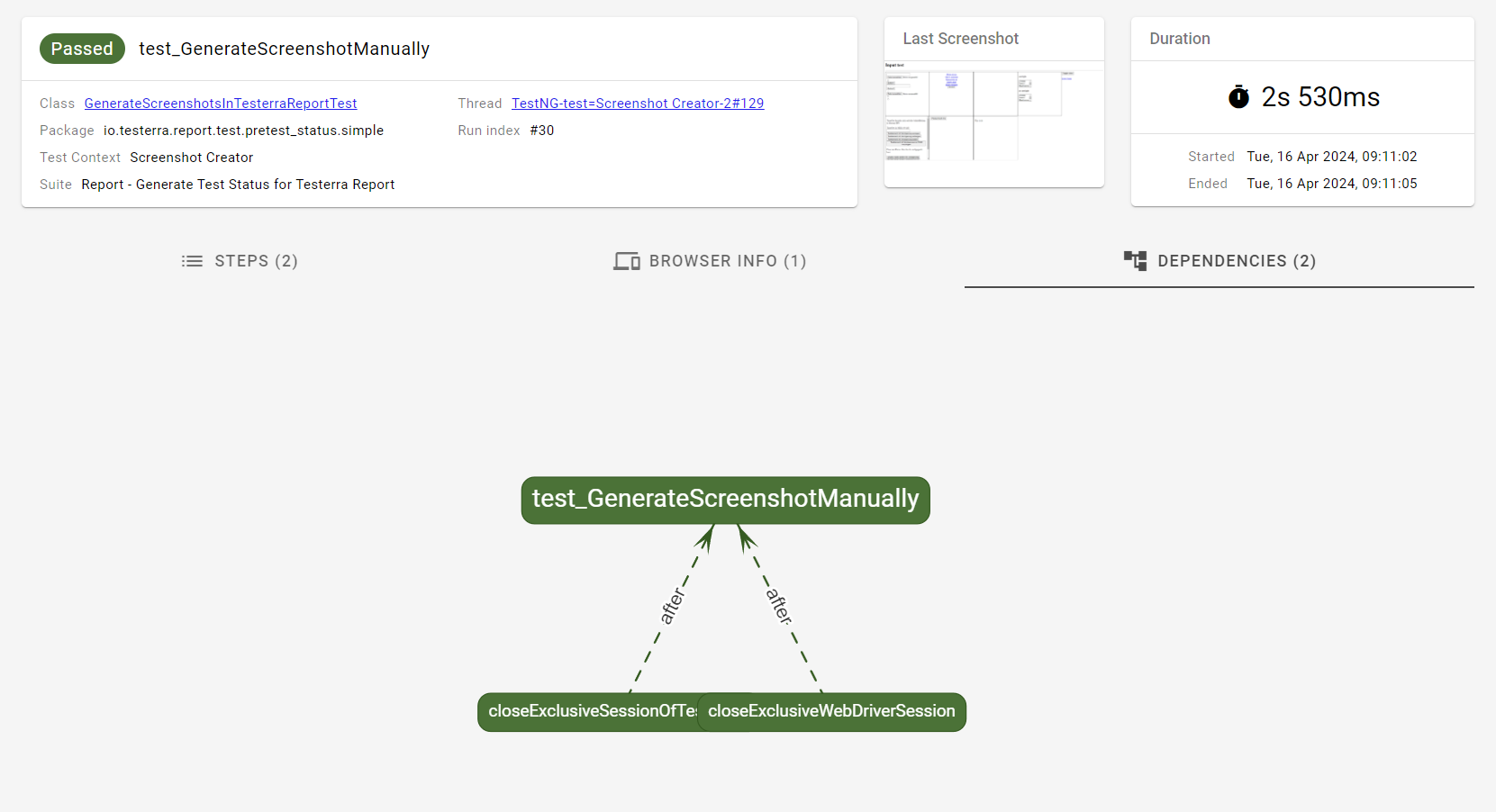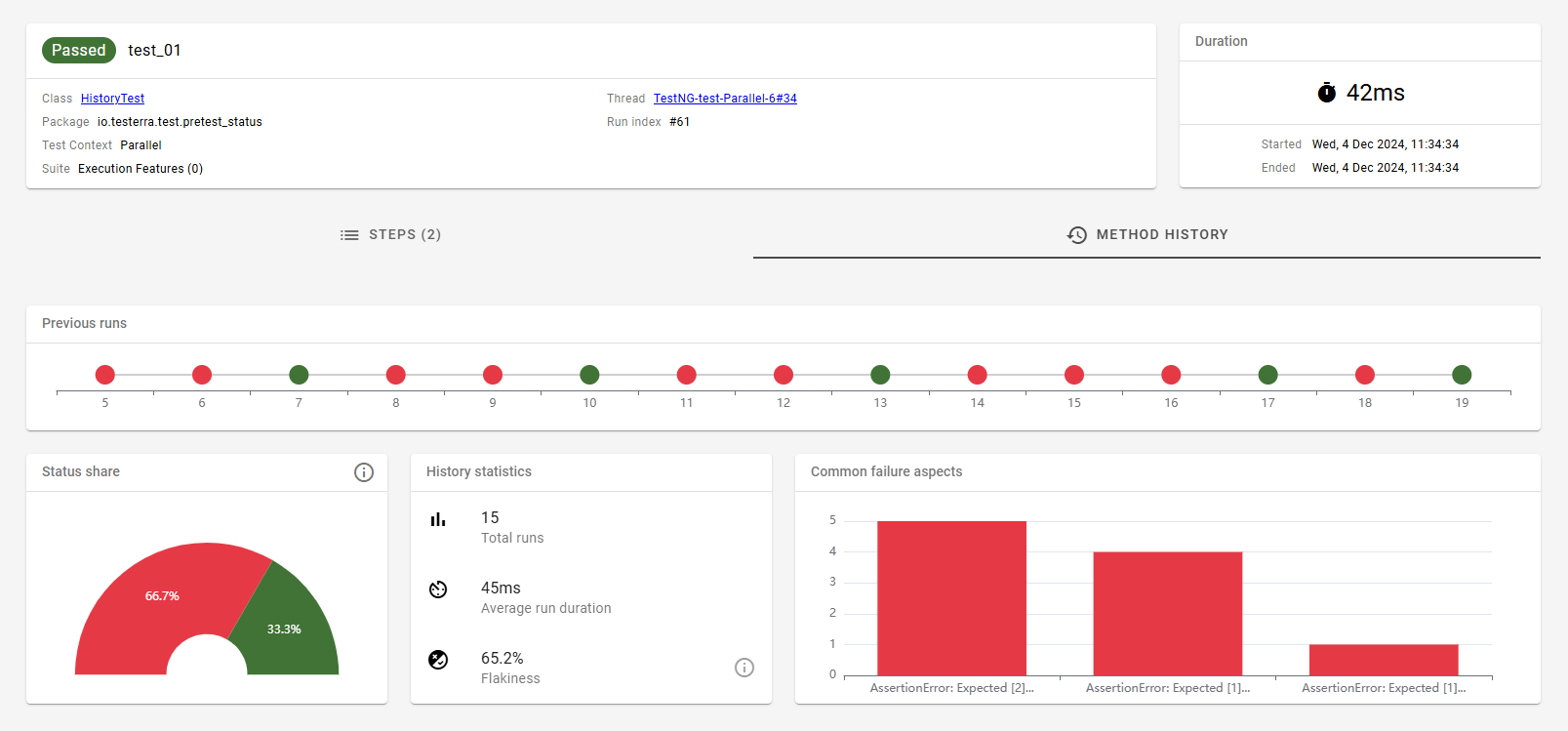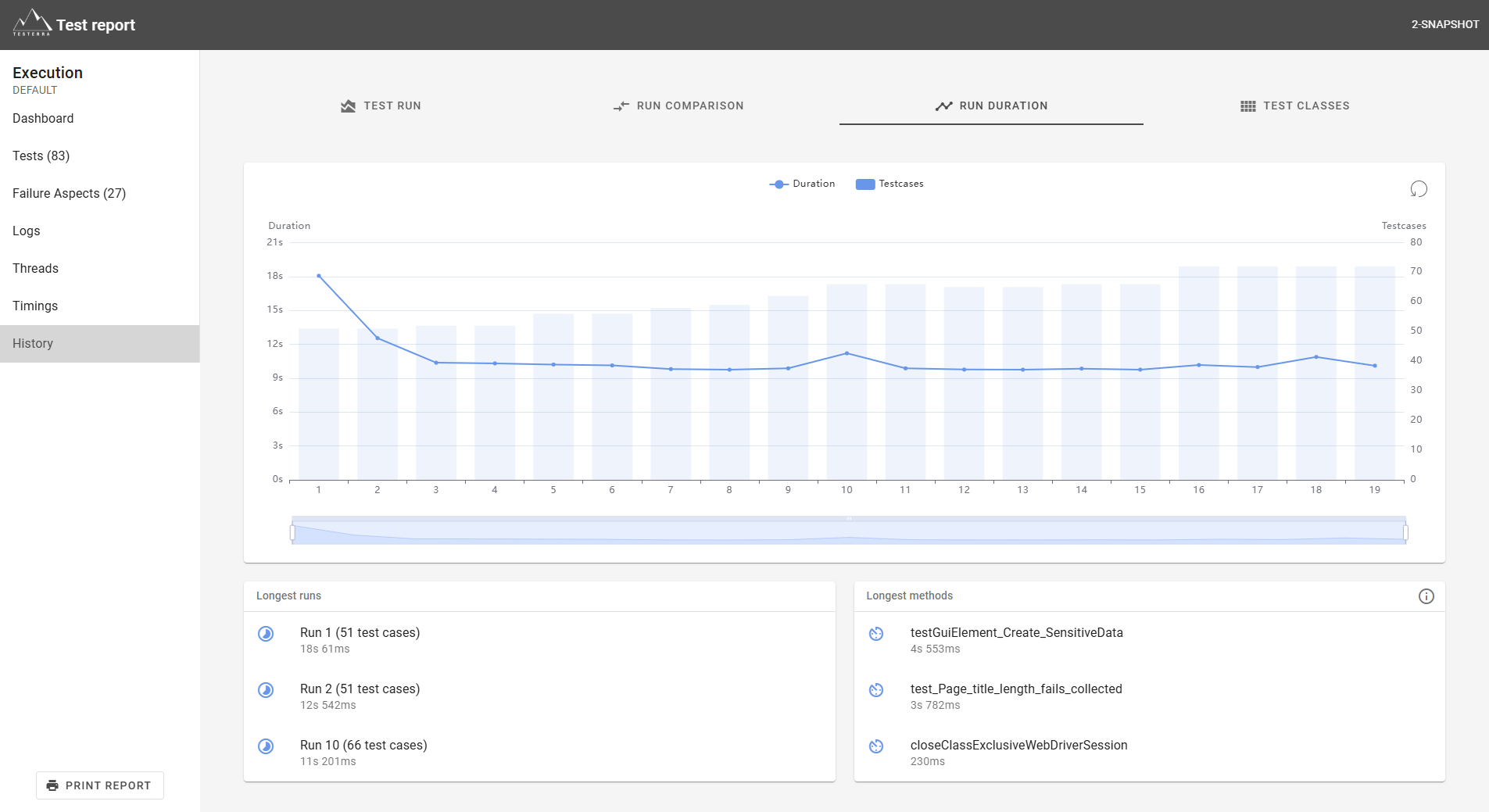Getting Started
1. Create a new project
1.1. System requirements
-
Testerra is based on Java. You need a JDK 11 or later.
-
Execute your tests with Maven or Gradle
1.2. Testerra Skeleton project
We provide a skeleton project to demonstrate the basic features of Testerra.
1.3. Testerra manual setup
1.3.1. Setup
Testerra and all its components are deployed to MavenCentral: https://mvnrepository.com/artifact/io.testerra
For Testerra you need at least the following dependencies.
// build.gradle
apply plugin: 'java-library'
// Its highly recommended to normalize your project to Unicode
compileJava.options.encoding = 'UTF-8'
compileTestJava.options.encoding = "UTF-8"
repositories {
mavenCentral()
}
dependencies {
implementation 'io.testerra:driver-ui-desktop:2.11'
implementation 'io.testerra:report-ng:2.11'
}<!-- pom.xml -->
<project>
<properties>
<maven.compiler.source>11</maven.compiler.source>
<maven.compiler.target>11</maven.compiler.target>
<!-- It's highly recommended to normalize your project to Unicode -->
<project.build.sourceEncoding>UTF-8</project.build.sourceEncoding>
</properties>
<dependencies>
<dependency>
<groupId>io.testerra</groupId>
<artifactId>driver-ui-desktop</artifactId>
<version>2.11</version>
</dependency>
<dependency>
<groupId>io.testerra</groupId>
<artifactId>report-ng</artifactId>
<version>2.11</version>
</dependency>
<!-- These dependency are required to get logging to work in Maven -->
<dependency>
<groupId>org.apache.logging.log4j</groupId>
<artifactId>log4j-slf4j18-impl</artifactId>
<version>2.16.0</version>
</dependency>
<dependency>
<groupId>org.apache.logging.log4j</groupId>
<artifactId>log4j-api</artifactId>
<version>2.16.0</version>
</dependency>
<dependency>
<groupId>org.apache.logging.log4j</groupId>
<artifactId>log4j-core</artifactId>
<version>2.16.0</version>
</dependency>
</dependencies>
</project>1.3.2. Create project structure
Your project structure should comply with these simple constraints.
-
src/mainContains all the code for your project like PageObjects, Models and language specific resources. -
src/testContains all test related code like your Tests, Test-Suites, Test-Data and Testerra related setup.
1.3.3. Create test.properties
Create a new file at src/test/resources with the name test.properties.
# Setting the browser
tt.browser.setting=chrome
# ... or with version
tt.browser.setting=chrome:120
# Setting the start page
tt.baseurl=http://example.org|
All defined properties can be overwritten later by adding system parameters to your command. (e.a -Dtt.browser.setting=firefox)
|
All supported browsers are listed in WebdriverManager properties
The tests will be started using the browser that is installed on the local machine if you do not provide a version in the properties. If you want to use a specific browser version that is not installed, Selenium Manager will automatically download the required version of Firefox or Chrome in the background.
For further information about the Selenium Manager, you can read the corresponding section of the Selenium documentation.
1.3.4. Create Page Class
Now it’s time to create a first simple page class. It should be saved at path src\main\java\<package>. The following example represents the website example.org. It contains one possible link to click and one method to test.
import eu.tsystems.mms.tic.testframework.pageobjects.Page;
import eu.tsystems.mms.tic.testframework.pageobjects.UiElement;
public class ExamplePage extends Page {
@Check
private UiElement moreInformationLink =
find(By.partialLinkText("More information"));
public ExamplePage(WebDriver driver) {
super(driver);
}
public void clickOnMoreInformation() {
moreInformationLink.click();
}
}|
The basic Page class added all the page object functionality of Testerra to your project. See PageObjects chapter for more details. The UiElement describes the elements like links, buttons, etc. on your page. Learn more about UiElements in UiElements. |
1.3.5. Create Test Class and Test Method
The easiest way to create a new test, is by creating a new class in the path of src\test\java\<package> and let it extend from TesterraTest.
If you already have test classes that extend, you can add the TesterraListener manually. Both ways do basically the same.
To stick to the example above, here is a very simple test class which navigates to example.org and clicks on the link defined on the example page. Again, probably imports must be made in IDE.
import eu.tsystems.mms.tic.testframework.testing.TesterraTest;
import eu.tsystems.mms.tic.testframework.testing.PageFactoryProvider;
public class ExampleTest extends TesterraTest implements PageFactoryProvider {
@Test
public void testT01_My_first_test() {
ExamplePage examplePage = PAGE_FACTORY.createPage(ExamplePage.class);
examplePage.clickOnMoreInformation();
}
}|
Be aware of using If you import |
import eu.tsystems.mms.tic.testframework.report.TesterraListener;
import org.testng.annotations.Listeners;
@Listeners(TesterraListener.class)
public class ExampleTest {
}1.3.6. Setup Selenium (optional)
However, if you want to set up a selenium driver by yourself and if you don’t have a remote selenium yet, you can easily install it by the package manager of your choice.
choco install selenium selenium-chrome-driverapt-get install chromium-chromedriverbrew install selenium-server-standalone chromedriverRead here, if you want to set up another Selenium configuration.
1.3.7. Setup a test suite
To customize the executing of your tests, you have to create a TestNG suite file suite.xml and locator it at src/test/resources
<!DOCTYPE suite SYSTEM "https://testng.org/testng-1.0.dtd" >
<suite name="Suite1" verbose="1" thread-count="10" configfailurepolicy="continue" parallel="false">
<test name="Test1" parallel="methods">
<classes>
<class name="ExampleTest"/>
</classes>
</test>
</suite>
If configfailurepolicy is not set to "continue" and a configuration method fails, the test methods will be skipped.
|
1.3.8. Setup test build target
In order to get tests to work, you need to set up a build target test in your project.
// build.gradle
test {
useTestNG() {
suites file('src/test/resources/suite.xml')
}
testLogging {
outputs.upToDateWhen { false }
showStandardStreams = true
}
// Important: Forward all JVM properties like proxy settings to TestNG
options {
systemProperties(System.getProperties())
}
// basically execution returns "GREEN" (framework exits with exit code > 0 if there were failures)
ignoreFailures = true
}<!-- pom.xml -->
<project>
<build>
<plugins>
<plugin>
<artifactId>maven-surefire-plugin</artifactId>
<configuration>
<skip>true</skip>
<testFailureIgnore>true</testFailureIgnore>
</configuration>
</plugin>
</plugins>
</build>
<profiles>
<profile>
<id>mySuite</id>
<activation>
<activeByDefault>true</activeByDefault>
</activation>
<build>
<plugins>
<plugin>
<artifactId>maven-surefire-plugin</artifactId>
<configuration>
<skip>false</skip>
<suiteXmlFiles>
<suiteXmlFile>src/test/resources/suite.xml</suiteXmlFile>
</suiteXmlFiles>
</configuration>
</plugin>
</plugins>
</build>
</profile>
</profiles>
</project>1.4. Using a proxy
There are three ways for setting up a proxy for your test run environment.
-
System proxy settings for the build environment (Maven, Gradle), TestNG, JVM and Selenium
-
Browser proxy settings for the SUT, which is done by capabilities as described here Proxy setup
1.4.1. Command line (recommended)
To setup a proxy for the whole system, including the build environment (Maven, Gradle), the JVM and Testerra, the recommended way is to pass it by command line arguments like
gradle test -Dhttps.proxyHost=your-proxy-host.com -Dhttps.proxyPort=80801.4.2. Property file
You can also put your proxy settings to the system Property files with the following content
https.proxyHost=your-proxy-host.com
https.proxyPort=8080
https.proxyUser=
https.proxyPassword=
https.nonProxyHosts=localhost|192.168.0.1
http.proxyHost=your-proxy-host.com
http.proxyPort=8080
http.proxyUser=
http.proxyPassword=1.4.3. Access the system proxy URL
The system proxy can be accessed by Proxy Utilities
1.4.4. Implicit setup (not recommended)
Since Java 11, it is possible to pass the system’s preconfigured proxy into the JVM.
gradle test -Djava.net.useSystemProxies=trueThis affects all Java internal network connections which uses ProxySelector, but it will not set the environment variables and are transparent to Proxy Utilities and any Browser capabilities.
1.5. Logging
The log configuration prints out to System.out by default.
If you want to have more control over several log levels of classes, add a log4j2.xml to your resources/.
<?xml version="1.0" encoding="UTF-8" ?>
<Configuration packages="eu.tsystems.mms.tic.testframework.logging">
<Appenders>
<Console name="CONSOLE">
<!--
The marker %contextIds gets replaced by internal plugins registered from
plugins packages in the <configuration> node
-->
<PatternLayout pattern="%d{dd.MM.yyyy HH:mm:ss.SSS} [%t][%p]%contextIds: %c{2} - %m{nolookups}%n" />
</Console>
</Appenders>
<Loggers>
<Logger name="org.asynchttpclient" level="info" additivity="false">
<AppenderRef ref="CONSOLE"/>
</Logger>
<Root level="debug">
<AppenderRef ref="CONSOLE"/>
</Root>
</Loggers>
</Configuration>You can also change the root log level from the command line via.
-Dlog4j.level=DEBUG
The shown log4j2.xml sets the INFO level for the package org.asynchttpclient. Otherwise Selenium 4 spams the logs with request/response information.
|
1.5.1. Log own messages
The Loggable interface provide some logging features and always uses the current instance class as logger name.
class MyClass implements Loggable {
public void doSomething() {
log().info("Do something");
}
}Which results in a log message similar to
[main][INFO][MCID:xyz][SCID:abc]: MyClass - Do somethingThe markers MCID and SCID are referencing to the current MethodContext respectively SessionContext ID.
| Important messages can be prompted to the Report. See here for more details. |
Testerra Framework
2. WebDriverManager
2.1. Overview
The WEB_DRIVER_MANAGER is the central component to create and close your WebDriver sessions and becomes available by implementing the WebDriverManagerProvider interface. It uses the standard Selenium Webdriver, but it is easier to configure.
2.2. WebDriver sessions
Before you can use WebDriver sessions, you have to set up a Selenium-compatible server.
2.2.1. Setup remote sessions
For using a remote Selenium server (e.g. a Selenium Grid) you only have to tell Testerra where it can be found.
tt.selenium.server.url=http://localhost:4444/wd/hub| The browser support depends on the remote Selenium setup. |
Manually configure WebDriver binaries
-
Download your WebDriver binary from browser vendor’s website to a local location
-
Make sure the driver version supports your installed browser
-
Since the properties are system properties, you need to put the location of the binaries to the
system.propertiesfile as mentioned in the Property files section.
webdriver.gecko.driver="C:\\absolute\\path\to\\your\\geckodriver.exe"
# or for other browsers
webdriver.chrome.driver=...
webdriver.edge.driver=...
webdriver.ie.driver=...You can also pass the WebDriver by the command line using
-Dwebdriver.gecko.driver=C:\absolute\path\to\your\geckodriver.exe2.2.2. Define browser type and version
Before starting a WebDriver session, you should configure your desired browser like.
# Only browser type
tt.browser.setting=firefox
# ... or with version
tt.browser.setting=firefox:65|
You can also define browser config via the settings If you have different browser configurations in your Selenium grid you have to take care about the correct combination! |
2.2.3. Usage of WebDriver sessions
On the first call of
WebDriver driver = WEB_DRIVER_MANAGER.getWebDriver();Selenium is triggered to open a new Browser windows with the defined URL.
Use remote Selenium server as often as possible, also for development.
So your project is independent of any WebDriver configuration and needed Webdriver binary files.
|
For every other call of getWebDriver() in the same test context WebDriverManager always returns the existing session.
This makes it possible to retrieve the current session in any context and avoids to force the user to pass the instance around.
| Please have a look to best practices of dealing with WebDriver instances |
2.2.4. WebDriver lifecycle
The default behaviour of Testerra’s WebDriverManager is, to create unique WebDrivers for each thread and/or test method.
That prevents issues in mutual interference between multiple threads.
-
Every WebDriver created in a thread, will be closed in this thread after the test method. See Use multiple sessions
-
You can keep a WebDriver in a thread over multiple methods. See Shared sessions in one thread
-
You can reuse WebDrivers by sharing sessions over different threads
2.2.5. Use multiple sessions
The WebDriverManager can handle more than one session in one test context.
Every session has a defined session key.
If no key was set, the default session key is called default.
The following example creates two independent browser sessions:
WebDriver driver = WEB_DRIVER_MANAGER.getWebDriver();
WebDriver driverWindow2 = WEB_DRIVER_MANAGER.getWebDriver("window2");
// Get the session key
String key1 = WEB_DRIVER_MANAGER.getSessionKey(driver); // key1 contains 'default'
String key2 = WEB_DRIVER_MANAGER.getSessionKey(driverWindow2); // key2 contains 'window2'2.2.6. Close a session
In most cases it is not needed to close your session manually. Testerra always closes all open session created in the thread at the end of a test method.
Anyway, to close active sessions manually, do the following:
// Shutdown a session by key
WEB_DRIVER_MANAGER.shutdownSession(String);
// Shutdown an explicit driver
WEB_DRIVER_MANAGER.shutdownSession(WebDriver);
// Close all active session in the current test context.
WEB_DRIVER_MANAGER.shutdownAllThreadSessions();
// Close all active session in all current parallel test threads.
WEB_DRIVER_MANAGER.shutdownAllSessions()|
Please do not use Selenium provided methods to close |
2.2.7. Shared sessions in one thread
You can reuse the WebDriver session over multiple methods in the same thread by setting the following property:
tt.wdm.closewindows.aftertestmethods=falseIn this case, the sessions will not be closed until the very end of the execution.
@Test
public void test1() {
WebDriver driver = WEB_DRIVER_MANAGER.getWebDriver();
}
@Test
public void test2() {
// You get the already opened session from test1
WebDriver driver = WEB_DRIVER_MANAGER.getWebDriver();
}You can implement that behaviour in a slightly different way, by setting up your sessions in @Before methods and close them in @After methods, which gives you more control.
@BeforeMethod
public void setupBrowser() {
DesktopWebDriverRequest request = new DesktopWebDriverRequest();
request.setShutdownAfterTest(false);
WebDriver driver = WEB_DRIVER_MANAGER.getWebDriver(request);
}
@Test
public void test() {
WebDriver driver = WEB_DRIVER_MANAGER.getWebDriver();
}
@AfterMethod(alwaysRun = true)
public void shutdownBrowser() {
WEB_DRIVER_MANAGER.shutdownAllThreadSessions();
}| You can only reuse the session in the current thread. If you run parallel tests, you have no access to the session between parallel test threads. |
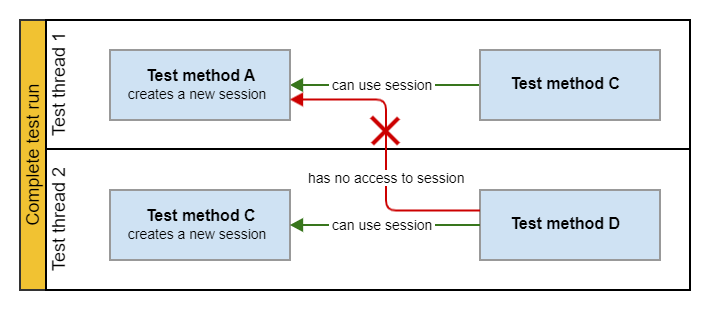
Special behaviour for config methods (deprecated)
When you create a WebDriver in a setup method annotated with @Before… or @After…, the session will not be closed after that method, even when tt.wdm.closewindows.aftertestmethods is true.
@BeforeMethod
public void setupWebDriver() {
// This WebDriver will not be closed, because it's a setup method
WebDriver driver = WEB_DRIVER_MANAGER.getWebDriver();
}
@Test
public void test1() {
// You get the already opened session
WebDriver driver = WEB_DRIVER_MANAGER.getWebDriver();
}
This implicit behaviour is @deprecated and will be removed in future versions.
|
2.2.8. Shared sessions over different threads
To use a WebDriver session over different test threads, you need an exclusive session.
Exclusive sessions are identified by a special uuid, not by the standard session key.
private static String uuid = null;
@Test
public void test1() {
WebDriver driver = WEB_DRIVER_MANAGER.getWebDriver();
uuid = WEB_DRIVER_MANAGER.makeExclusive(driver);
}
@Test
public void test2() {
// Get the exclusive session
WebDriver driver = WEB_DRIVER_MANAGER.getWebDriver(uuid);
}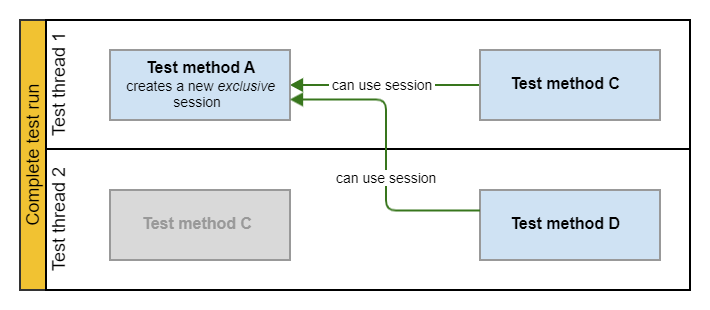
|
An exclusive session has an unlimited lifetime. You need do close this session manually. |
2.3. WebDriver configuration
A global configuration applies to all new sessions created by WebDriverManager. You can set a global configuration by.
-
Setting defaults as Properties
-
Configure the WebDriver on request
2.3.1. Property configuration
The main configuration your WebDriver session is done in test.properties.
The most important properties are:
-
tt.browser.setting(ortt.browser,tt.browser.versionandtt.browser.platform) -
tt.baseurl -
tt.selenium.server.url(ortt.selenium.server.hostandtt.selenium.server.port)
The complete list of WebDriver properties can be found at WebdriverManager properties.
2.3.2. Request configuration
If you only want to change the settings for one session, you can use WebDriverRequest.
All defined attributes overrides the standard configuration.
| If an attribute is not set, the global definition is used. |
DesktopWebDriverRequest myRequest = new DesktopWebDriverRequest();
myRequest.setBaseUrl("http://example.org");
myRequest.setBrowser(Browsers.firefox);
myRequest.setBrowserVersion("66");
myRequest.setSessionKey("mysession");
myRequest.setWindowSize(new Dimension(2560,1440)); // tt.window.size
myRequest.setShutdownAfterTest(false); // applies to all test method results
// tt.wdm.closewindows.aftertestmethods
myRequest.setShutdownAfterTestFailed(false); // applies only to failed test methods
// tt.wdm.closewindows.onfailure
myRequest.setMaximizeBrowser(true); // tt.browser.maximize
WebDriver driver = WEB_DRIVER_MANAGER.getWebDriver(myRequest);Via the SessionContext you can get the current configuration of a WebDriver session:
Optional<SessionContext> sessionContext = WEB_DRIVER_MANAGER.getSessionContext(webDriver);
// In case of a desktop browser you can cast to 'DesktopWebDriverRequest'
// Be careful if you are using other session types like Appium sessions!
DesktopWebDriverRequest webDriverRequest
= (DesktopWebDriverRequest) sessionContext.get().getWebDriverRequest();
With DesktopWebDriverRequest you can also define Browser capabilities.
|
2.4. Working with sessions
2.4.1. Get current session
WebDriver driver = WebDriverManager.getWebDriver();
Optional<SessionContext> sessionContext = WEB_DRIVER_MANAGER.getSessionContext(driver);2.4.2. Switching windows or tabs
In some cases you need to switch to a new browser window or tab which was opened by the application.
// Switch to a window by matching title with 'equals()'
WEB_DRIVER_MANAGER.switchToWindowTitle(WebDriver webDriver, String windowTitle);
// Switch to a given window handle
WEB_DRIVER_MANAGER.switchToWindowHandle(WebDriver webDriver, String windowHandle);
// Switch to a window by a custom condition
boolean switched = WEB_DRIVER_MANAGER
.switchToWindow(WebDriver webDriver, webDriver -> webDriver.getCurrentUrl().contains("login"));
Assert.assertTrue(switched, "Login window not found");You can also handle a delayed switch of a window by using CONTROL.
int secondsForRetry = 6;
CONTROL.retryFor(secondsForRetry, () -> {
WEB_DRIVER_MANAGER.switchToWindowTitle(webDriver, "MyWindowTitle");
});
// Using a predicate you have to check the result of switching
CONTROL.retryFor(secondsForRetry, () -> {
boolean result = WEB_DRIVER_MANAGER
.switchToWindow(webDriver, driver -> driver.getTitle().contains("MyWindowTitle"));
Assert.assertTrue(result);
});3. Browser capabilities
You can customize your WebDriver session by setting capabilities in the following ways:
-
Global capabilities that affect every WebDriver session created and can be set by User agent configuration
-
Request capabilities that affect only WebDrivers for a given request
When creating a new WebDriver, these capabilities get merged together in this exact order.
3.1. User agent configuration
The user agent configuration is most precise, because it provides explicit browser options based on the Selenium driver.
The setting applies to all created sessions for a browser type (global).
import eu.tsystems.mms.tic.testframework.useragents.FirefoxConfig;
WEB_DRIVER_MANAGER.setUserAgentConfig(Browsers.firefox, (FirefoxConfig) options -> {
options.addPreference("intl.accept_languages", "de-DE");
});Non-standard capabilities need a vendor prefix and can be set as follows:
Map<String, Object> customCaps = new HashMap<>();
customCaps.put("foo", "bar");
WEB_DRIVER_MANAGER.setUserAgentConfig(Browsers.firefox, (FirefoxConfig) options -> {
options.setCapability("custom:caps", customCaps);
});
|
3.2. Request capabilities
Some WebDriverRequests support setting capabilities, like the DesktopWebDriverRequest. It’s used to specify a single WebDriver session.
DesktopWebDriverRequest request = new DesktopWebDriverRequest();
MutableCapabilities caps = request.getMutableCapabilities();
caps.setCapability(CapabilityType.ACCEPT_INSECURE_CERTS, true);
// Start your session with the DesktopWebDriverRequest object
WebDriver webDriver = WEB_DRIVER_MANAGER.getWebDriver(request);
|
3.3. Global capabilities with WEB_DRIVER_MANAGER (@deprecated)
| This feature is deprecated, please use User agent configuration |
You can customize your browser session by setting capabilities for every browser type.
Be in mind that not every browser could handle all types of capabilities.
WEB_DRIVER_MANAGER.setGlobalCapability(CapabilityType.ACCEPT_INSECURE_CERTS, true);
WEB_DRIVER_MANAGER.removeGlobalCapability(CapabilityType.ACCEPT_INSECURE_CERTS);|
Do NOT set browser capabilities with WebDriverManager. This will added to the capabilities to all browser types! |
3.4. Proxy setup
If you want that the browser uses a proxy for the SUT, you can just configure that by default Selenium capabilities.
| Make sure that your WebDriver supports the Proxy-Capability. For example the MicrosoftWebDriver for Legacy Edge does not support proxy setup (see Edge WebDriver Capabilities). |
| If you want to setup a proxy for the runtime environment but the browser, you have to follow the instructions at Using a proxy |
The following code setups a proxy based on the System’s proxy configuration and a custom proxy.
import org.testng.annotations.BeforeSuite;
import eu.tsystems.mms.tic.testframework.webdrivermanager.WebDriverManagerUtils;
import eu.tsystems.mms.tic.testframework.webdrivermanager.WebDriverProxyUtils;
import org.openqa.selenium.Proxy;
public abstract class AbstractTest extends TesterraTest {
@BeforeSuite
public void proxySetup() {
WebDriverProxyUtils utils = new WebDriverProxyUtils();
Proxy otherProxy = utils.createHttpProxyFromUrl(
new URL("http://proxyUser:secretPassword@my-proxy:3128")
);
WEB_DRIVER_MANAGER.setUserAgentConfig(Browsers.chrome, (ChromeConfig) options -> {
options.setProxy(otherProxy);
});
}
}
WebDriverProxyUtils.getDefaultHttpProxy() only returns the proxy configuration for HTTP, HTTPS and non-proxy connections.
|
4. UiElements
4.1. Overview
UiElements are representations of elements of the tested website, like buttons, search fields, checkboxes or even just DOM elements.
UiElements are not, but based on the Selenium WebElement and add more functionality to them. Since a UiElement is just a pointer to a locator, it’s using the same definition as WebElements By (Selenium docs).
UiElements are self refreshing: Every action on it will trigger a find call, so the current state is always up to date when the requested action takes place. There is de facto no StaleElementReferenceException on UiElements like it could be when using vanilla WebElements.
4.2. Creation
4.2.1. Create default UiElement
For every UiElement you need an implementation of the UiElementFinder interface (like PageObjects) and a locator (Selenium docs).
UiElement myElement = find(By.id("elementId"));
UiElement button1 = find(By.name("button"));
UiElement textOutputField = find(By.xpath("//p[@id='99']"));| A GuiElement always points to the first element found by the given locator. Even when your locator would return multiple elements, it just represents one. You can make your locators to force uniqueness or use element lists. |
4.2.2. Create SubElements
The UiElement also implements UiElementFinder. Elements will only be searched in the DOM tree below the given parent element on which the method was called.
UiElement upper = find(By.name("upperElement"));
// Create the sub elements
UiElement lower = upper.find(By.name("lowerElement"));
UiElement lower = upper.find(By.xpath(".//p[@id='element']")); (1)
UiElement lower = upper.find(By.xpath("//p[@id='element']")); (2)
UiElement lower = upper.find(By.xpath("./p[@id='element']")); (3)| 1 | Find any matching descendant |
| 2 | Corrects the selector prefix to './/' |
| 3 | Find any matching child |
4.2.3. Implement UiElementFinder
When you don’t want to use the PageObject pattern, you can instantiate an UiElementFinder on your own.
import eu.tsystems.mms.tic.testframework.pageobjects.UiElementFinder;
import eu.tsystems.mms.tic.testframework.testing.TesterraTest;
import eu.tsystems.mms.tic.testframework.testing.UiElementFinderFactoryProvider;
import eu.tsystems.mms.tic.testframework.testing.WebDriverManagerProvider;
class MyTest extends TesterraTest implements
UiElementFinderFactoryProvider,
WebDriverManagerProvider
{
protected UiElementFinder createFinder() {
return UI_ELEMENT_FINDER_FACTORY.create(WEB_DRIVER_MANAGER.getWebDriver());
}
@Test
public void test() {
UiElementFinder finder = createFinder();
UiElement myElement = finder.find(By.id("elementId"));
UiElement button1 = finder.find(By.name("button"));
UiElement textOutputField = finder.find(By.xpath("//p[@id='99']"));
}
}4.2.4. Advanced UiElement locating
The UiElementFinder extends the LocatorFactoryProvider interface, which provides a LOCATE factory that supports more features than standard Selenium By.
Locate unique elements
If you want to make sure, that your element is unique.
UiElement myElement = find(LOCATE.by(By.id("elementId")).unique());This will throw an exception, if not exact one WebElement has been found.
Locate displayed items only
UiElement myElement = find(LOCATE.by(By.xpath(".//button")).displayed());Prepared xpath expressions
Using prepared expressions makes complex selectors more readable.
PreparedLocator byText = LOCATE.prepare("//button[text()='%s'])");
PreparedLocator byClass = LOCATE.prepare("//%s[contains(@class, '%s')][%d]");
UiElement loginButton = find(byText.with("Login"));
UiElement logoutButton = find(byClass.with("button", "btn-logout", 1));Filtering elements
You can also filter elements during find.
Locator byText = LOCATE.by(By.xpath("//button"))
.filter(webElement -> webElement.getText().equals("Open again"));
UiElement buttonContainsText = find(byText);4.2.5. UiElements inside frames
Accessing WebElements inside frames requires changing the active frame before any action. UiElements do that automatically as long you identify every <frame> or <iframe> as own element.
UiElement frame1 = find(By.id("frame1"));
// frame2 is child of frame1
UiElement frame2 = frame1.find(By.id("frame2"));
// target is child of frame2 which is child of frame1,
UiElement target = frame2.find(By.id("target"));And easier way is to use the findDeep method, which search for the element recursive in the frame hierarchy every time.
// in this case the frames are searched recurse automatically
UiElement target = findDeep(By.id("target"));4.2.6. Element lists
The UiElement is like a pointer to the first element of the given locator. But if you want to retrieve a list of all found elements by the given locator, you can use the UiElementList like the following.
<div>First</div>
<div>Second</div>
<div>Third</div>UiElement div = find(By.tagName("div"));
div.list().first().expect().text("First");
div.list().last().expect().text("Third");They can also be iterated and streamed.
div.list().forEach(uiElement -> {});
div.list().stream().forEach(uiElement -> {});4.2.7. Empty elements
To prevent null pointers or any other exception that will break you program flow, you can use and empty UiElement using createEmpty() of UiElementFinder.
UiElement empty = createEmpty(Locator);All interactive operations on this element will do nothing, all wait methods will be false and all assertions will fail.
4.2.8. Sensitive Data
Sensitive data, such as passwords, can be displayed obfuscated in the logs during the actions type and sendKeys.
UiElement sensitiveElement = findById("secret").sensitiveData();Only the placeholder * is logged in the report instead of the real value.
4.2.9. Trace elements hierarchy
In most cases, elements are part of a view hierarchy. The Nameable interface provides some methods to retrieve this information.
Nameable parent = element.getParent();A parent could be any PageObject like UiElement, Component or Page.
Be aware that getParent() could return NULL, when the element has been created without a hierarchy or the element is a Page. So you should always perform a null or instanceof check.
|
If you want to trace the hierarchy beginning from top-down, you can use the traceAncestors() method.
element.traceAncestors(ancestor -> true);When the given Predicate return FALSE, the tracing will stop.
| This will not supply the calling element. |
4.3. XPath builder
The static XPath class helps you to build failsafe xPathes optimized for HTML. But it’s restricted to search elements top-down.
This is what the basic syntax looks like
UiElement div = find(XPath.from("div"));But it supports many other features you need when you select elements from the DOM, like first and last element.
XPath.from("tr", 1);
XPath.from("tr", -1);The xPath is generated greedy by default. When you create an xPath like
XPath.from("body").select("div");this equivalent result would be //body//div
If you want to restrict the selection to a child element, use the / prefix:
XPath.from("/body").select("/div");which equivalent would be /body/div
It is also possible to pass groups in the from method only:
XPath.from("(//iframe|//frame)");Or use functions:
XPath.from("*").attribute("local-name()", "svg");4.3.1. Elements that have classes
XPath.from("div").classes("navigation", "header");This will find elements like
<div class="header large navigation">but not
<div class="navigation-header">4.3.2. Select an element that encloses another element
XPath.from("nav")
.classes("mobile")
.enclose("/div")
.classes("navigation", "header");This will find the <nav> element
<nav class="mobile">
<div class="navigation header"></div>
</nav>4.3.3. Select an element by its text
XPath.from("*").text().hasWords("Login", "here");
XPath.from("*").text().contains("first");
XPath.from("*").text().endsWith("here ");This will find elements like
<a> Login first
here </a>4.4. Assertions
UiElements provide many kinds of assertion methods to verify your elements.
If an assertion fails, it will make the whole test fail and abort. You can control that by using a TestController
4.4.1. UiElement checks
Checks are assertions which verify the condition of an UiElement.
Checks if the element is present in the DOM
element.expect().present(boolean);Checks if the element is present in the Viewport,
if it is visible by it’s display and visibility style properties and if it’s width and height are both greater than 0.
element.expect().displayed(boolean);Checks if the element is displayed and if it’s partially or fully visible in the scroll area of the viewport.
element.expect().visiblePartial(boolean);
element.expect().visibleFull(boolean);
It doesn’t relate to opacity or z-index style properties. If you need to test the perceptually visibility to the human eye, you should consider to implement an image based Layout Check.
|
Some more WebElement checks
// The following methods are calling the standard webelement method
element.expect().enabled(boolean);
element.expect().selected(boolean);
// Tries to find out if an element could be selected.
element.expect().selectable(boolean);4.4.2. Assertions of UiElement attributes
UiElement element = find(By.id("button"));
// Expect the element text
element.expect().text("Hello World");
element.expect().text().contains("World").is(boolean);
element.expect().text().isContaining("World"); // Short form
element.expect().text().map(String::trim).startsWith("Hello").is(boolean);
// Expect the existence of an attribute
element.expect().attribute(Attribute.DISABLED).isNot(null);
// Expect the value of an input element matches an regular expression
element.expect().value().matches("^hello\\s.orld").is(boolean);
// CSS property checks
element.expect().css("display").is("none");
// CSS class checks
element.expect().hasClasses("active", "button").is(boolean);
// Visibility checks
element.expect().visiblePartial(boolean);
element.expect().visibleFull(boolean);4.4.3. Layout assertions
UiElement can be checked for their relative layouts.
UiElement left = find(By.id("left"));
UiElement right = find(By.id("right"));
left.expect().bounds().leftOf(right).is(true);
UiElement image1 = find(By.xpath("//..."));
UiElement image2 = find(By.xpath("//..."));
UiElement image3 = find(By.xpath("//..."));
// Assertions are true
image1.expect().bounds().leftOf(image2).is(true);
image1.expect().bounds().fromTop().toTopOf(image2).is(0);
image1.expect().bounds().fromBottom().toBottomOf(image3).is(0);
// Assertions are false
image1.expect().bounds().fromBottom().toBottomOf(image2).is(0);4.4.4. Custom assertion message
Testerra generates a readable assertion message with name of UiElement, page and checked attribute.
public class DragAndDropPage extends Page {
...
private UiElement columnA = find(By.id("column-a"));
public TestableUiElement getColumnA() {
return this.columnA;
}
}
...
public MyTest extends TesterraTest implements PageFactoryProvider {
@Test
public void myTest() {
DragAndDropPage page = PAGE_FACTORY.createPage(DragAndDropPage.class);
page.getColumnA().expect().displayed().is(false); (1)
page.getColumnB().expect().displayed().is(false, "Foo"); (2)
}
}| 1 | Error message: UiElementAssertionError: Expected that DragAndDropPage → columnB displayed is false |
| 2 | Error message: UiElementAssertionError: Expected that Foo is false |
4.5. Actions
An UiElement provides a variety of action methods. Beside the known WebElement methods there are some more useful methods to interact with the web site.
4.5.1. Click on elements
UiElement element = find(By.id("button"));
element.click();
element.doubleClick();
element.contextClick();| If you have troubles using these methods, take a look to the fallback solution Desktop WebDriver utilities. |
4.5.2. Enter text
UiElement element = find(By.id("input"));
// Enters the given text in a input or textfield.
// Any old values are automatically deleted before input.
// The type method has a value check. If the given string is NULL or empty, the method does nothing.
element.type("my text");
// The standard Selenium method is used.
// You can also use the Selenim Keys class to enter special keys.
element.sendKeys("my text");
element.sendKeys("my text" + Keys.ENTER);
// Delete the content of an input field.
element.clear();4.5.3. Use select boxes
UiElement element = find(By.id("select"));
// Get the Select WebElement of a UiElement
element.findWebElement(webElement -> {
Select select = new Select(webElement);
// You can use all Selenium Select methods to interact.
select.selectByIndex(2);
select.selectByVisibleText("option");
List<WebElements> list = select.getAllSelectedOptions();
});4.5.4. Use check boxes
UiElement element = find(By.id("checkbox"));
// Check and uncheck the check box
element.select();
element.deselect();
// true = check, false = uncheck
element.select(boolean);4.5.5. Scrolling
You can scroll the browser viewport until the element is in the middle viewport if possible.
element.scrollIntoView();
// Lets offset pixel distance from the top of the viewport
element.scrollIntoView(new Point(0, -20))4.5.6. Mouse over
You can simulate the mouse pointer is moved over an element.
element.hover();| If you have troubles using this method, take a look to the fallback solution Desktop WebDriver utilities. |
4.5.7. Drag and drop actions
With the utils class MouseActions you can execute a drag-and-drop actions.
Source and target UiElements can be located in different frames.
UiElement source = find(By.id("elem1"));
UiElement target = find(By.id("elem2"));
MouseActions.dragAndDropJS(source, target);
// You can add one or more DragAndDropActions
MouseActions.dragAndDropJS(source, target, DragAndDropOption.CLICK_AFTER_RELEASE);
// This method provides a swipe of an element to a relative position from the element.
int offsetX = 50; // Pixel
int offsetY = 125; // Pixel
MouseActions.swipeElement(source, offsetX, offsetY);4.6. Waiters
In testing practice the test automation code must tolerate delays caused e.g. by page loading or javascript activities when checking conditions on UiElements.
If the condition (which is checked continuously) is met within the timeout then the wait methods return true.
Otherwise, after the timeout has passed they return false without any further action or assertion.
boolean result;
result = element.waitFor().displayed(boolean);
// Overrides preconfigured internal timeout
result = element.waitFor(int seconds).displayed(boolean);4.7. Properties
4.7.1. Use the getActual()
The values of most properties of a UiElement can be returned by the getActual() method.
<a href="newpage.html" class="foolink" style="font-size: 20px;">My link</a>UiElement element = find(By.xpath("//a"));
String text = element.waitFor().text().getActual(); // returns "My link"
String href = element.waitFor().attribute("href").getActual(); // returns "newpage.html"
String tag = element.waitFor().tagName().getActual(); // returns "a"
String classes = element.waitFor().classes().getActual(); // returns "foolink"
String css = element.waitFor().css("font-size").getActual(); // returns "20px"4.7.2. Access the WebElement
UiElement provides all Selenium methods when retrieving the WebElement. You have access to some more properties.
<a href="newpage.html" style="font-size: 20px;">My link</a>UiElement element = find(By.xpath("//a"));
element.findWebElement(webElement -> {
Point point = webElement.getLocation(); // returns the top left corner of the element
Dimension dim = webElement.getSize(); // returns width and heigth of the element
Rectangle rect = webElement.getRect(); // returns rectangle with location and size
});|
Testerra’s UiElement does not support a public method like We absolutely do not recommend to create you own Selenium WebElement by |
4.8. Internals
The find mechanism for a UiElement in Testerra works different as in plain Selenium.
When using a constructor for a UiElement instantiation, Testerra internally will add some facades / decorators to make things easier.
The most important decorator that is added by default is the GuiElementCoreSequenceDecorator -which adds a sequence to all method calls against a GuiElement.
Example: When calling the isPresent() method on a UiElement the added GuiElementSequenceDecorator will fire up an internal find() call to the GuiElement and therefore a find() call to the underlying Selenium WebElement.
But instead of calling the find() method once, it will execute this call in a default sequence every 500ms.
Therefor the property tt.element.timeout.seconds defined in test.properties will be used as a hard timeout for this sequence.
If the find() does not run successfully after the defined timeout it will fail.
5. PageObjects
5.1. Overview
5.1.1. What is a page object?
A page objects represents a HTML pages and or a subpage. It contains UiElements with describe the actual page and methods to provide actions on them.
In your test you only uses the provided actions of your page like an API. The page object himself uses the UiElements as an API to interact with the website.
We recommend the usage of page objects:
-
They are easy to maintain.
-
They improve the readability of test scripts.
-
They reduce or eliminate duplicity of code.
-
The pages are reusable.
5.1.2. Navigation Principle
In a regular Web Application there is a defined navigation flow. This means there are pages with actions on it that let you navigate to other pages.
In the example below we have a search dialog with a search action on it that lets you navigate to a ResultPage with the search result.
When a search is performed the browser will navigate to the ResultPage. In your page you create a new object of your next page.
This new page object is used for the next steps in your test.

5.1.3. Example
The following page contains two UiElements and one method for a user action 'search a string'.
Within the method search the defined UiElements are used to execute a search.
The annotation Check marks the UiElements as mandatory for the page. Testerra automatically verifies these elements when this page is instantiated (Check Annotations).
public class SearchPage extends Page {
@Check
private final UiElement searchButton = find(By.name("searchButton"));
@Check
private final UiElement inputField = find(By.name("inputField"));
// constructor
public SearchPage(WebDriver driver) {
super(driver);
}
// search action on page
public ResultPage search(String text) {
inputField.type(text);
searchButton.click();
return createPage(ResultPage.class);
}
}The following lines demonstrate how to use page objects in your test method.
public class TestClass extends TesterraTest implements PageFactoryProvider {
@Test
public void myTest() {
HomePage homePage = PAGE_FACTORY.createPage(HomePage.class);
SearchPage searchPage = homePage.openSearch();
ResultPage resultPage = searchPage.search("search text");
resultPage.assertResultSetIsNotEmpty();
homePage = resultPage.close();
}
}|
The method This could mean that the usage of the |
5.2. Instantiation
5.2.1. PageFactory
Pages need to be created initially via. PageFactory interface, which will be provided by the PageFactoryProvider as PAGE_FACTORY instance.
When the page is instantiated, Testerra automatically checks its annotated elements.
HomePage homePage = PAGE_FACTORY.createPage(HomePage.class);
// Or use an explicit WebDriver
HomePage homePage = PAGE_FACTORY.createPage(HomePage.class, WebDriver otherWebDriver);5.2.2. Inline creating
Once you created a page, you can create other pages directly from this page, to keep track of the same WebDriver.
OtherPage otherPage = homePage.createPage(OtherPage.class);5.2.3. Optional pages
You can also try to create a page, when you want to handle unexpected redirects at some point.
homePage.waitForPage(OtherPage.class).ifPresent(otherPage -> {});
homePage.waitForPage(OtherPage.class, int seconds).ifPresent(otherPage -> {});5.2.4. Lifecycle
When a page has been created and all Check Annotations have been performed, the pageLoaded() method will be called, which can be used to perform some additional initializing without any test related interaction.
class MyPage extends Page {
@Override
protected void pageLoaded() {
super.pageLoaded();
// additional actions
}
}5.2.5. Page Prefixes (deprecated)
Using page prefixes is an uncommon feature and therefore marked as @deprecated
|
Page Prefixes can influence which concrete classes get instantiated by the PageFactory. They work together with a inheritance scheme of page classes. This can be useful if there is a base page which can come in different concrete variations. Example:
There is a BaseClass which inherits from the Page class and contains the basic functionality of a page.
Then the Page can come in 2 different variations.
We can represent this as Variation1BaseClass and Variation2BaseClass.
They both inherit from BaseClass.
Before instantiation, we can set the prefix using the PageFactory.
Then we instantiate it and we can get our variation of the base class.
PAGE_FACTORY.setGlobalPagesPrefix("Variation1");
//this actualy creates a Variation1BaseClass
BaseClass baseClass = PAGE_FACTORY.createPage(BaseClass.class);Default is no prefix.
Usage:
// Set a global Prefix
PAGE_FACTORY.setGlobalPagesPrefix("prefix");
// Set a thread local prefix. See next row about cleaning this prefix.
PAGE_FACTORY.setThreadLocalPagesPrefix("prefix");
// The thread local pages prefix is not cleared automatically,
// be sure to always set the correct one or clear it after using.
PAGE_FACTORY.removeThreadLocalPagePrefix();5.3. Components
You can improve your PageObjects by using components. Components are like they are in actual web development environments: Containers with functionality. With components, you don’t need to try to create reusable PageObjects in a complex inheritance hierarchy, you can follow the pattern that composition before polymorphism.
In Testerra, components are hybrids of both UiElements and PageObjects. They can contain more UiElements and even Components, but they don’t provide features restricted to Pages or UiElements and their finder API is restricted to its root container element by default.
5.3.1. Create a component
The following HTML snippet is given:
..
<div id="container">
<input type="text" id="mytext">
<button id="button">Send</button>
</div>
..The component should contain all elements of the div element.
import eu.tsystems.mms.tic.testframework.pageobjects.AbstractComponent;
public class MyComponent extends AbstractComponent<MyComponent> {
@Check
UiElement input = find(By.id("mytext"));
@Check
UiElement button = find(By.id("button"));
public MyComponent(UiElement rootElement) {
super(rootElement);
}
}To instantiate components, use the createComponent() method the same way as you create pages.
The second parameter is the root element of your component (here the div element).
public class MyPage extends Page {
MyComponent component = createComponent(MyComponent.class, find(By.id("container")));
}|
All UiElements of your component are always sub elements of the root element! The button element of the example is found like |
5.3.2. Component lists
Since components are hybrid UiElements, they can also act as lists.
UiElement table = find(By.tagName("table"));
TableRow rows = createComponent(TableRow.class, table.find(By.tagName("tr")));
rows.list().forEach(row -> {
row.getNameColumn().text().contains("Hello").is(true);
});5.3.3. Break out from components
Some website components have no unique root element because some elements were added dynamically to the end of the DOM at runtime.
In that case your UiElements are no subelements of your component’s root element. You can access outside elements as follows:
public class MyComponent extends AbstractComponent<MyComponent>
implements UiElementFinderFactoryProvider {
// This element is a subelement from component's root element
private UiElement input = find(By.id("mytext"));
// This element can be outside
private UiElement button = this.getExternalElement(By.id("button"));
public MyComponent(UiElement rootElement) {
super(rootElement);
}
private UiElement getExternalElement(By by) {
UiElementFinder uiElementFinder = UI_ELEMENT_FINDER_FACTORY.create(this.getWebDriver());
UiElement uiElement = uiElementFinder.find(by);
if (uiElement instanceof NameableChild) {
((NameableChild<?>) uiElement).setParent(this);
}
return uiElement;
}
}|
Setting the parent of the outside UiElement is optional, but in case of Assertion errors the error message is well formatted like |
5.4. Check Annotations
The @Check annotation is used to verify the actual presence of an element on the site.
All UiElements that are marked with the @Check annotation are automatically checked when instantiated by the PageFactory.
In the example, the first UiElement has the @Check annotation, the second doesn’t.
The result is, that the presence of the first element will be checked by the constructor, the second won’t.
If a checked element is not found, the constructor will throw a PageFactoryException.
@Check
private UiElement checked = find(By.name("checked"));
//no @Check here
private UiElement unchecked = find(By.name("unchecked"));The @Check annotation will use the default CheckRule defined in test.properties.
It is also possible to overwrite the default CheckRule for a single @Check annotation.
@Check(checkRule = CheckRule.IS_PRESENT)
private UiElement uiElement;Change the check rules for the whole project (global) with the following:
tt.guielement.checkrule=IS_PRESENTAvailable CheckRules are
-
IS_DISPLAYED
-
IS_NOT_DISPLAYED
-
IS_PRESENT
-
IS_NOT_PRESENT
The default is IS_DISPLAYED.
With the optional attribute, the check only adds an optional assertion to the report.
The test will not be interrupted at this position. See Optional assertions for more details.
@Check(optional = true)
private UiElement uiElement;With the collect attribute you can collect all checks. The test will not be interrupted, but if failes at the end. See Collected assertions for more details.
@Check(collect = true)
private UiElement uiElement;
It does not make sense to set optional and collect at the same UiElement!Because optional is also a kind of collect, the collect attribute will be ignored.
|
You can also define a special error message with the prioritizedErrorMessage attribute.
@Check(prioritizedErrorMessage = "My error message.")
private UiElement uiElement;Use the timeout attribute to define a specific timeout only for that element to optimize check timeouts on Page instantiation. This overrides the Page timeout setting.
@Check(timeout = 60)
private UiElement uiElement;5.5. Page loaded callback
You can add a custom action if a page was loaded successfully.
public class MyPage extends Page {
...
@Override
protected void pageLoaded() {
super.pageLoaded();
// Add here your custom action
}
}5.6. Timeout Setting
The checks are performed with a timeout. The default timeout is set by the tt.element.timeout.seconds property.
With the following annotation, the check can be optimized for all UiElements during page instantiation:
@PageOptions(elementTimeoutInSeconds = 60)
public class ExamplePage extends Page {
// insert your code
}5.7. Information hiding
The PageObject pattern encapsulates UiElements for all activities on the page. That’s why every element should be private accessible by the page only. But for testing purposes, it could be useful to allow access to some elements. In this case, you can create public methods and return the element casting to TestableUiElement.
public class MyPage extends Page {
private UiElement saveButton = find(By.tagName("button"));
public void performSave() {
saveButton.click();
}
public TestableUiElement getSaveButton() {
return saveButton;
}
}In the test, you can perform assertions without breaking the PageObject pattern.
@Test
public void testSaveFunctionality() {
MyPage page = getPage();
page.performSave();
page.getSaveButton().expect().text("Saved");
}Excecution and controlling
6. Regular Assertions
When implementing the AssertProvider interface, you get an instance named ASSERT, which provides more features than standard TestNG Assert
You can use this interface for assertions they cannot be covered by the UiElement.
import eu.tsystems.mms.tic.testframework.testing.AssertProvider;
public class MyTest extends TesterraTest implements AssertProvider {
@Test
public void test() {
ASSERT.assertContains("Hello world", "planet");
}
}This will throw an AssertionError with the message Expected [Hello world] contains [planet].
You can also add some more detailed information to the subject.
ASSERT.assertContains("Hello world", "planet", "the greeting");Which will result in Expected that the greeting [Hello world] contains [planet]
Please take a look into the Assertion interface for a full feature overview.
7. Test controlling
The TestControllerProvider interface provides the TestController instance CONTROL for controlling the test and assertion flow.
7.1. Collected assertions
Collecting assertion means, that a failing assertion will not abort the test method, but it will throw an assertion error at the end of the test method. So you have a chance to validate many more aspects in one test run.
CONTROL.collectAssertions(() -> {
element.expect().text("Hello World");
page.performLogin();
ASSERT.assertEquals("hello", "world");
});
Assertions can only be collected by using Regular Assertions or expect()/assertThat() of UiElements.CONTROL.collectAssertions(…) does not work with org.testng.Assert.
|
See here how collected assertions are presented in Report-NG.
7.2. Optional assertions
Optional asserts do not let the test fail, but the assertion message will be added to the log with loglevel WARN and will result in an minor failure aspect.
CONTROL.optionalAssertions(() -> {
element.expect().text("Hello World");
page.performLogin();
ASSERT.assertEquals("hello", "world");
});
Assertions can only be optional by using Regular Assertions or expect()/assertThat() of UiElements.CONTROL.optionalAssertions(…) does not work with org.testng.Assert.
|
See here how optional assertions are presented in Report-NG.
7.3. Change internal timeout
To change the timeout for internal assertions, you can override it for a specified block.
CONTROL.withTimeout(int seconds, () -> {
element.expect().text("Hello World");
}Please mind that you also can pass already implemented methods.
@Test
public void test_something_fast() {
CONTROL.withTimeout(0, this::test_something);
}
withTimeout() overrides all internal timeouts except the explicit set timeout in waitFor(int seconds) methods.
|
7.4. Retries
In some situations you cannot rely on single assertions or waits anymore and need to continue trying something out before performing an alternative solution. Use control methods for repeating a couple of actions within a loop until a timeout has reached.
For example, this retry block tries to click a button until it’s disabled.
CONTROL.retryFor(int seconds, () -> {
button.click();
button.expect().enabled(false);
});Or if you want to retry something multiple times.
CONTROL.retryTimes(int times, () -> {
button.click();
button.expect().enabled(false);
});You can also perform something when the retry block fails.
CONTROL.retryFor(int seconds,() -> {
element.expect().text(String);
}, () -> {
element.getWebDriver().reload();
});You can also combine these control features.
CONTROL.retryFor(int seconds, () -> {
CONTROL.withTimeout(int seconds, () -> {
button.click();
uiElement.scrollIntoView();
uiElement.expect().visiblePartial(boolean);
}
);7.5. Waits
If you need to wait for something to happen. You can use the control method waitFor which does the same as retryFor but without throwing any exception.
boolean loginOpened = CONTROL.waitFor(int seconds, () -> {
WEB_DRIVER_MANAGER.switchToWindowTitle("Login");
});Or use waitTimes similar to retryTimes.
boolean loginOpened = CONTROL.waitTimes(int times, () -> {
WEB_DRIVER_MANAGER.switchToWindowTitle("Login");
});8. Test execution
Testerra has several features to handle and adjust a test execution, which are described in the following paragraphs.
8.1. Conditional behaviour
For managing the execution behaviour of tests in suites there are means to skip tests and avoid closing browser windows after failures.
# all browser windows remain open after first failure, default = false
tt.on.state.testfailed.skip.shutdown=true
# skip all tests after first failure, default = false
tt.on.state.testfailed.skip.following.tests=true8.2. Failure Corridor
This mechanism is used to define the test goal of test runs so that it only fails with an invalid failure corridor.
This feature is enabled by default with the following property.
tt.failure.corridor.active=trueWith an enabled failure corridor, you need to define the maximum amount of failures per weight:
tt.failure.corridor.allowed.failed.tests.high=0
tt.failure.corridor.allowed.failed.tests.mid=1
tt.failure.corridor.allowed.failed.tests.low=2|
If you do not define any failure corridor, the default value |
To change the weight for each test, just annotate it with @FailureCorridor, where High is default.
// This testcase is marked with a high weight.
@FailureCorridor.High
@Test
public void test1() throws Exception {
Assert.fail();
}
// This testcase is not marked, but the default weight is high.
@Test
public void test2() throws Exception {
Assert.fail();
}
// This testcase is marked with a middle weight.
@FailureCorridor.Mid
@Test
public void test3() throws Exception {
Assert.fail();
}
// This testcase is additional marked with @Fails.
// So the test result is ignored by the Failure corridor.
@Fails
@FailureCorridor.Mid
@Test
public void test4() throws Exception {
Assert.fail();
}
// This testcase is marked with a low weight.
@FailureCorridor.Low
@Test
public void test5() throws Exception {
Assert.fail();
}8.3. Element Highlighting
8.3.1. Demo mode
In the demo mode actions on pages are marked with distinctive coloured frames around the element of the action. This mechanism is set by a property:
# activate demo mode, default = false
tt.demomode=trueThe following colours are used for highlighting
-
red: failed visibility checks and asserts
-
green: successful visibility checks and asserts
-
yellow: mouseOver
-
blue: click
The highlighting is removed after a timeout of 2000 ms. You can set a custom timeout:
# Set a custom timeout in ms
# 0 -> infinite timeout
# default is 2000
tt.demomode.timeout=50008.4. Expected Fails
For known issues on the SUT the annotation @Fails can used to mark a test method as failing. These test cases are marked as Expected failed separately in the report.
If tests are passed again, you get a note in the report to remove the Fails annotation.
@Test
@Fails()
public void testItWillFail() {
Assert.assertTrue(false);
}|
The result is technically still a failure and only visually elevated to facilitate the evaluation of the report. Please keep in mind that
|
8.4.1. Add additional information
You can add additional information to describe the cause in more detail. All information are added to the report.
@Test
@Fails(description="This test fails for reasons")
public void testItWillFail() {
Assert.assertTrue(false);
}| Attribute | Description |
|---|---|
description |
Give more details about the failure. |
ticketString |
Define a bug ticket ID or URL as a String value. |
intoReport |
If |
validator |
Define a method that checks if the expected failure is valid. |
validatorClass |
Define a class for the |
8.4.2. Defining a validator
With expected fails validators, you can define if the Expected Failed state is valid or not.
When the validator returns true, the expected failed status is valid, otherwise, the test will result in a regular Failed.
You can use that feature to mark a test as expecting to fail for known circumstances, like browser or environment configurations.
You define a validator the following way:
public boolean browserCouldFail(MethodContext methodContext) {
return methodContext.readSessionContexts()
.map(SessionContext::getActualBrowserName)
.anyMatch(s -> s.contains("internet explorer"));
}
@Test
@Fails(validator = "browserCouldFail")
public void testSomething() {
// Perform your tests here
}Or as a class:
public class FailsValidator {
public boolean expectedFailIsValid(MethodContext methodContext) {
return true;
}
}@Test
@Fails(validatorClass = FailsValidator.class, validator = "expectedFailIsValid")
public void testSomething() {
// Perform your tests here
}Example for expected fails on a specific Exceptions:
public class FailsValidator {
public boolean expectedFailOnCertainException(MethodContext methodContext) {
// of course it's possible to check for more things inside the throwable
return methodContext.getTestNgResult().isPresent()
&& methodContext.getTestNgResult().get().getThrowable()
instanceof CertainException;
}
}@Test
@Fails(validatorClass = FailsValidator.class, validator = "expectedFailOnCertainException")
public void test_customFails() throws CertainException {
throw new CertainException();
}8.5. Retry analyzer
Testerra provides an adjustable mechanism to automatically retry failed tests.
The default retry count is 1. Each failed method is executed exactly one more time, when matching the retry criteria.
Retried methods are shown in the section Retried of the report.
You can change the default with the following property.
tt.failed.tests.max.retries=1| The retry mechanism always ignores testcases with a valid Fails annotation. |
8.5.1. Specific retry count for test methods
You can change the retry count for specific test methods.
@Test()
@Retry(maxRetries = 2)
public void testMethod() {
// ...
}8.5.2. Default retries
The following default retry analyzers are registered from modules:
-
driver-uiregisteresWebDriverRetryAnalyzerwhich retries tests on specific internal WebDriver exceptions they look like temporary communication problems. -
driver-ui-desktopregisteresSeleniumRetryAnalyzerwhich retries tests on general Selenium communication problems with requested Desktop user agents:-
org.openqa.selenium.json.JsonException -
org.openqa.selenium.remote.UnreachableBrowserException
-
8.5.3. Specific retries
Testerra can also retry failed methods when matching certain criteria. The filtering process contains of checks of classes and messages matching the thrown Exception, which are set within the test.properties file.
# Set additional classes that engage a retry,
tt.failed.tests.if.throwable.classes=java.sql.SQLRecoverableException
# Set additional messages of Throwable that engage a retry,
tt.failed.tests.if.throwable.messages=failed to connect, error communicating with database8.5.4. Customize retry behaviour
For further adjustment additional analyzers can be registered expanding the default behaviour.
InstantiationException// custom Retryanalyzers need to implement the functional interface AdditionalRetryAnalyzer
public class InstantiationExceptionRetryAnalyzer implements AdditionalRetryAnalyzer {
final String message = "failed instantiation";
@Override
public Optional<Throwable> analyzeThrowable(Throwable throwable) {
String tMessage = throwable.getMessage();
if (throwable instanceof InstantiationException) {
if (tMessage != null) {
final String tMessageLC = tMessage.toLowerCase();
boolean match = tMessageLC.contains(message);
if (match) {
return Optional.of(throwable);
}
}
}
return Optional.empty();
}
}public class AbstractTest extends TesterraTest {
static {
// register the additional Analyzer,
// which checks for "InstantiationException" and the message "failed instantiation"
RetryAnalyzer.registerAdditionalRetryAnalyzer(new InstantiationExceptionRetryAnalyzer());
}
}8.5.5. @NoRetry
With this annotation the Retry Analyzer won’t retry these methods if previously failed. This is characteristically shown in the report by the badge NoRetry.
You can customize the NoRetry annotation with the attributes name and color.
| Attribute | Description |
|---|---|
name |
Changes the shown text in the report. Default is |
color |
Change the background color of the shown text. Default is
|
NoRetry@Test()
@NoRetry(name = "No retry because it's not allowed.", color="rgb(255, 236, 139)")
public void testMethod() {
...
}8.6. WebDriverWatchDog
The WebDriverWatchDog is your vigilant pet watching the test execution and reacting on blocked tasks. With two properties it is set up.
# activate watchdog, default = false
tt.watchdog.enable = true
# timeout in seconds after the test execution is terminated, default = 300
tt.watchdog.timeout.seconds = 5008.6.1. How does it work?
With the first Usage of WedDriverManager the WebDriverWatchDog is initiated.
It internally starts a Thread running in parallel to the current test execution checking the stacktrace every ten seconds for
stacktrace entries with thread name "Forwarding" containing an Element "java.net.SocketInputStream".
These potentially blocking stacktrace entries are updated every time found.
Upon reaching the maximum timeout of 500 seconds the whole test execution is terminated with exit code 99 and a readable error output in your log.
| A valid report is always generated. |
8.7. Annotations for Report adjustment
To improve the readability and clarity of the report there are several annotations for marking the test class and test methods, which are described in the following paragraph as well as in @Fails, @Retry and @NoRetry.
8.7.1. @TestClassContext
With this annotation you can set the test context for the given test class. There two attributes for adjustments.
-
name: name of the context, default =
"" -
mode:
TestClassContext.Mode.ONE_FOR_ALLorTestClassContext.Mode.ONE_FOR_EACH, default =TestClassContext.Mode.ONE_FOR_ALL
The Executed tests are then shown in the classes overview of the report as a entry labeled with name from @TestClassContext.
8.8. Dry Run
8.8.1. Overview
With this execution mode all methods marked with TestNG Annotations are only called but their code isn’t executed, hence the name dry run. It’s designed to simply check the callstack of TestNG related methods without executing their logic, e.g. to find missing method calls in your test setup. For using this you just need to set the following property.
# activate the dry run, default = false
tt.dryrun=trueThe report indicates a dry run with the suffix Dry Run in the headlines of each section.
| The rest is visually identical to a normal run. |
All called methods are shown, but probably as passed. With a closer look into the report details you will just notice a really low test duration, something below one second.
Testerra Features
9. Reporting with Report-NG
9.1. Overview
Testerra provides an advanced reporting of the test results with the Report-NG module.
A report generated with Report-NG consists of these different views:
-
Dashboard - a general overview of the test run
-
Tests - a detailed list of the individual tests
-
Failure Aspects - a summary of the different types of failures
-
Logs - a panel that contains detailed logging information
-
Threads - a graphical view of the thread activities during the parallel test execution
-
Timings - a detailed overview of the execution time of test cases and loading time of sessions
-
History - an overview of past test runs, highlighting issues, their durations, and the ability to compare runs
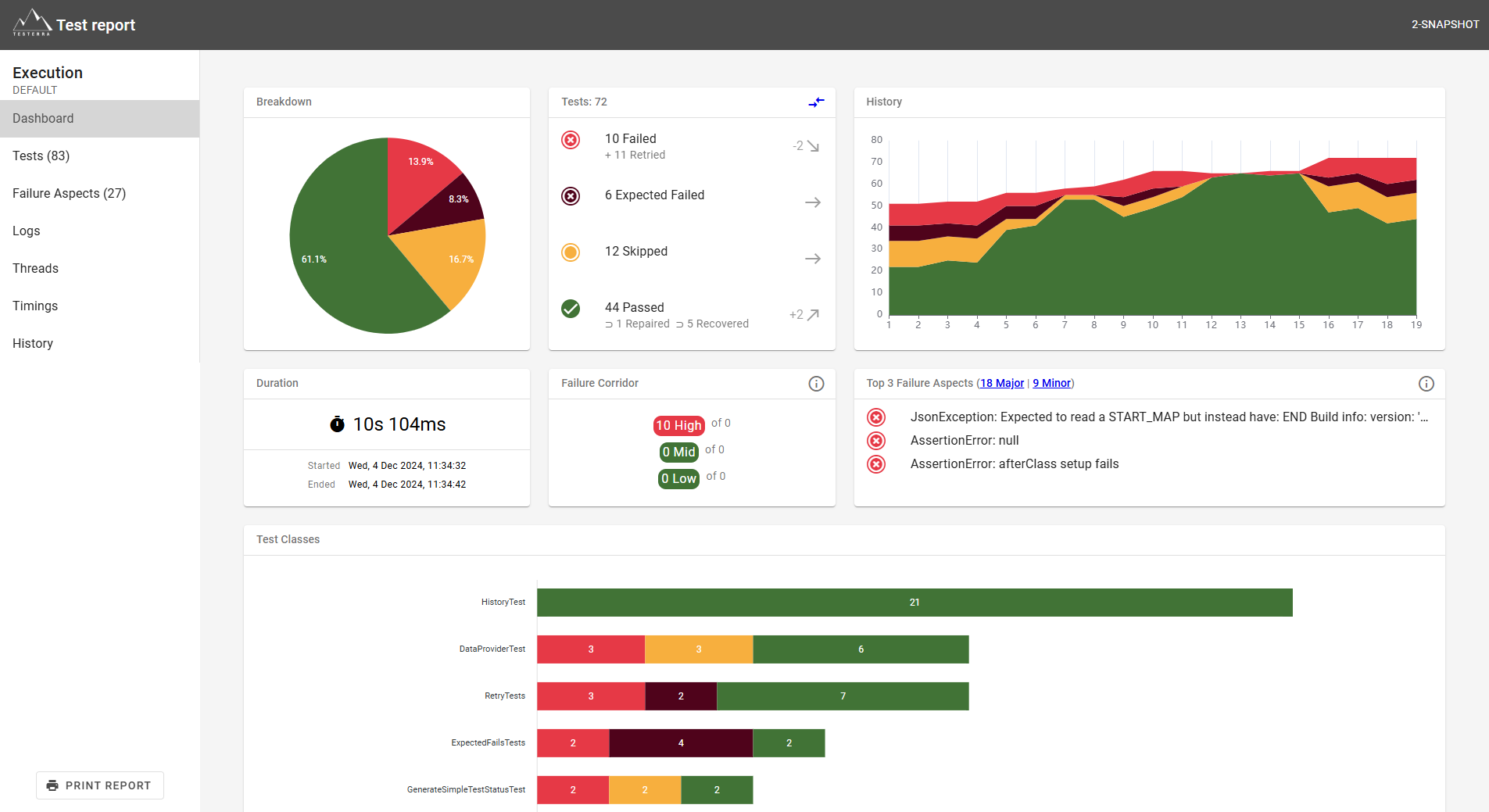
The report is generated after the test execution and can be viewed with this html file:
test-report/report-ng/index.html|
Unfortunately, because the report is a highly dynamic application based on java script, the security settings of most browsers do not allow to directly view the report in your local folder. In this case you can use one of the simple http servers from this list to serve the files and to access the report. |
9.2. Setup
The simplest way to add Report-NG test reports to your project is to use the Testerra project skeleton as a foundation. See Testerra Skeleton project how to start with it. You can use Report-NG instantly because there it is already configured for use with Maven as well as Gradle.
If you are not using the Testerra skeleton, checkout the Maven and Gradle build files in chapter Testerra manual setup.
9.3. History
The Testerra report can display historical data from previous test runs. By default, results from up to 50 executions are stored and displayed. This limit can be adjusted by setting the tt.report.history.maxtestruns property to a different value. If the limit is exceeded, the oldest results are automatically deleted.
9.3.1. How to use the history?
When executing a test set for the first time, placeholders are shown because there is no previous run available yet. You need to execute the test set at least twice to view historical data in the report. Testerra uses the locally saved test results, stored in the report directory (which can be configured via the tt.report.dir property), to build the history. Therefore, ensure that previous test results are locally available to enable history features.
9.4. Dashboard View
9.4.1. Overview
The dashboard view provides an overview of the latest test execution. It displays the total number of executed tests, along with counts of passed, skipped, and failed tests.
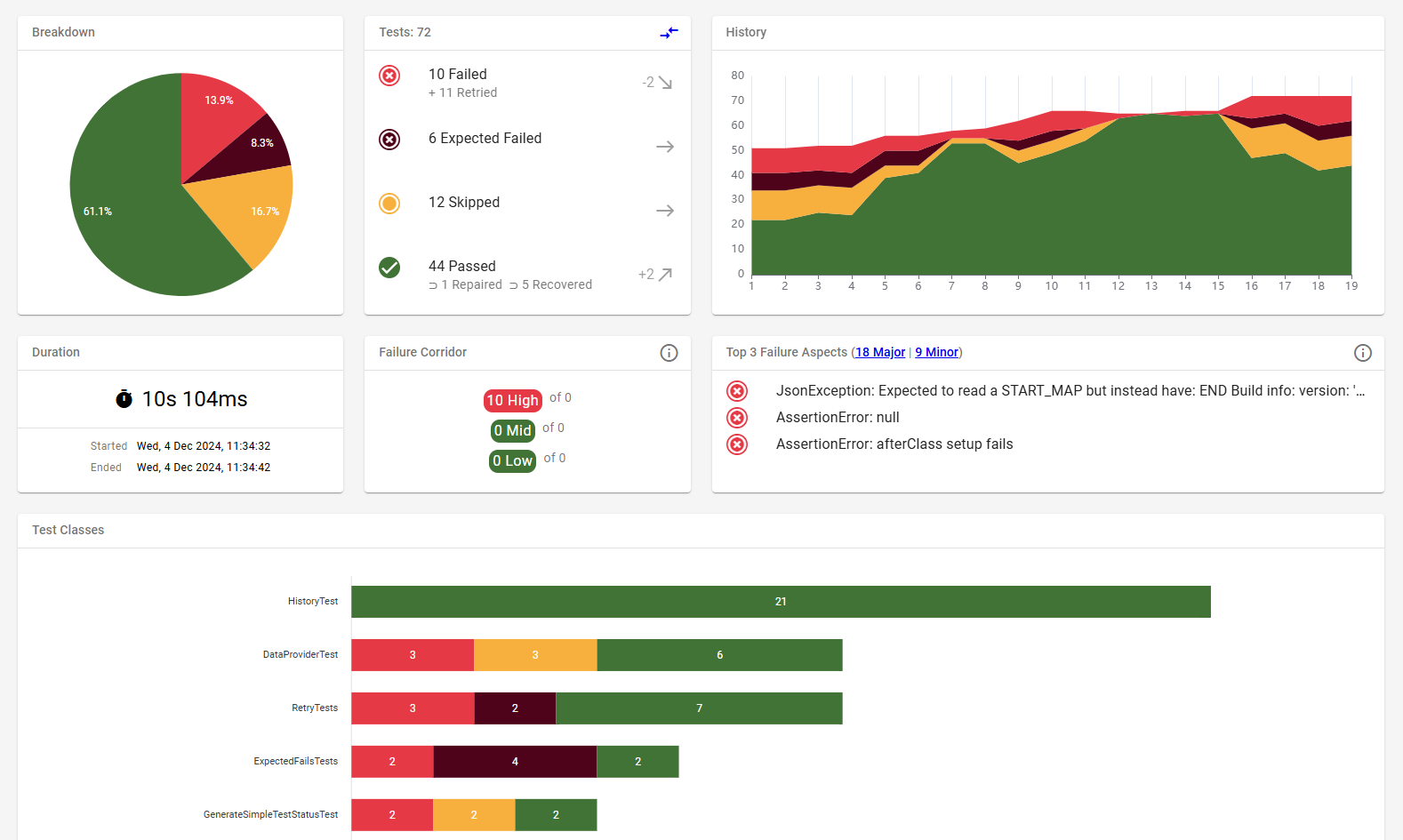
The Breakdown panel includes a pie chart showing the proportions of test results, color-coded by test status.
Directly below the pie chart, a panel displays detailed information about test execution duration, as well as start and end times. Beneath that, another panel lists the executed test classes, showing how many tests passed, failed, or were skipped within each class.
9.4.2. Status definitions
Testerra defines the following final 4 statuses which describe the final test result:
| Test Status | Description |
|---|---|

|
The test was successful. |

|
The test was failed. |

|
The test was not executed because a precondition failed like a configuration method, a data provider or an another test. |

|
The test failed as expected and the test method is annotated with @Fails because of a known bug or problem. |
Additional to the statuses above Testerra defines some more sub statuses:
| Test Status | Description |
|---|---|

|
The test failed at it’s first try. Testerra executed that test again if the RetryAnalyzer was active. |

|
The test was passed at it’s second (third…) execution if the RetryAnalyzer was active. |

|
The test was passed but it is still annotated with |
|
9.5. Test Details View
9.5.1. Overview
The report provides a list of all executed tests that can be filtered according to the status, the class or the name of the test. If you want to include the setup and configuration methods in this list you must activate the switch on the right side:

When you click on the name of a test case in this list, you can see all details of its last execution.
On the top you will find general status information, test timing information and if a screenshot was taken during the test execution it can be viewed here as well.
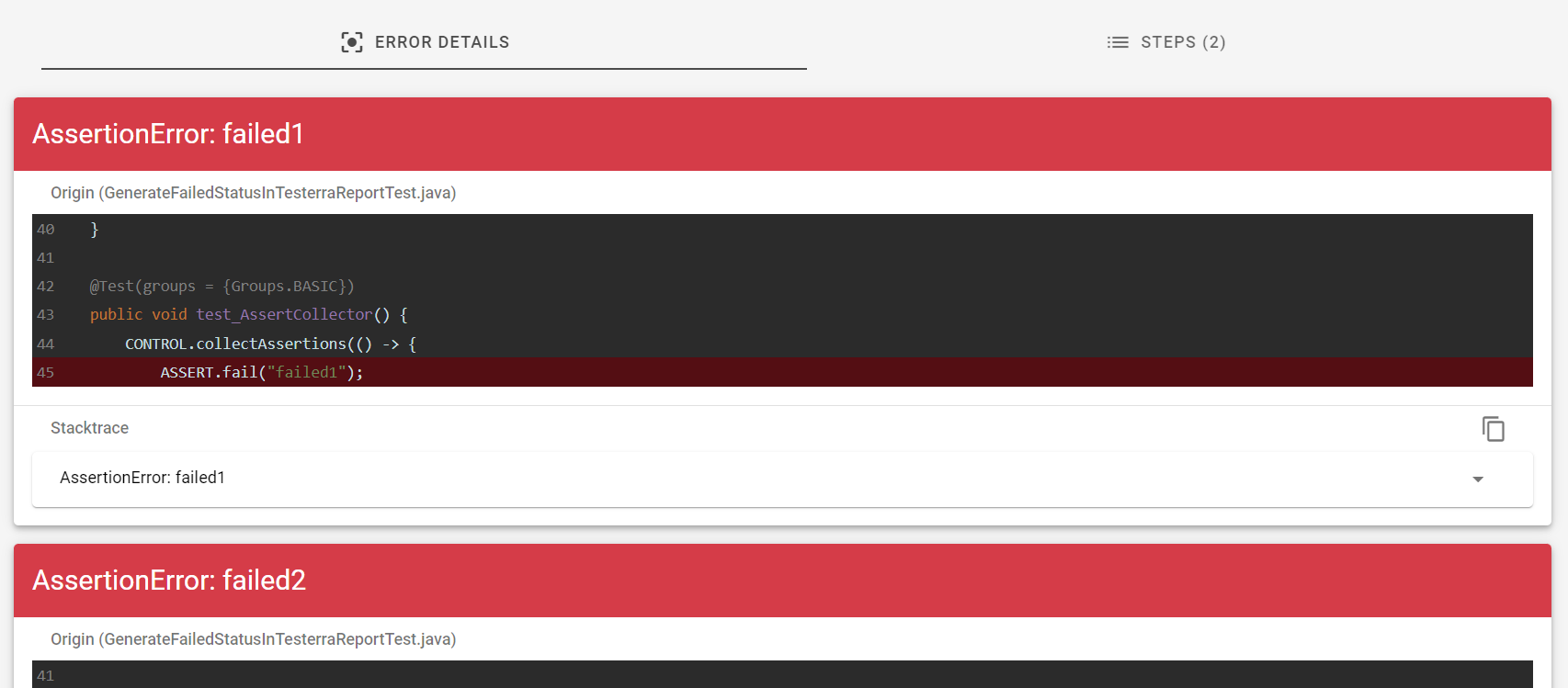
Below this section different tab panes provide more information:
-
Error Details - a tab pane that is present when the test failed which shows the type (aspect) of the failure, the lines of test code causing it and a stack trace.
-
Steps - a tab pane which lists all test steps of the test execution in detail, which is further described here.
-
Sessions - a tab pane which shows the web driver sessions with its capabilities when a web driver session was active.
-
Dependencies - a tab pane that shows the dependencies of this test case in case there are any.
-
Method History – a tab showing previous runs the method, along with additional statistics.
9.5.3. Video tab pane
| If you are using the (Testerra Selenoid connector) and a (Selenoid grid), you can add recorded video streams to your report. |
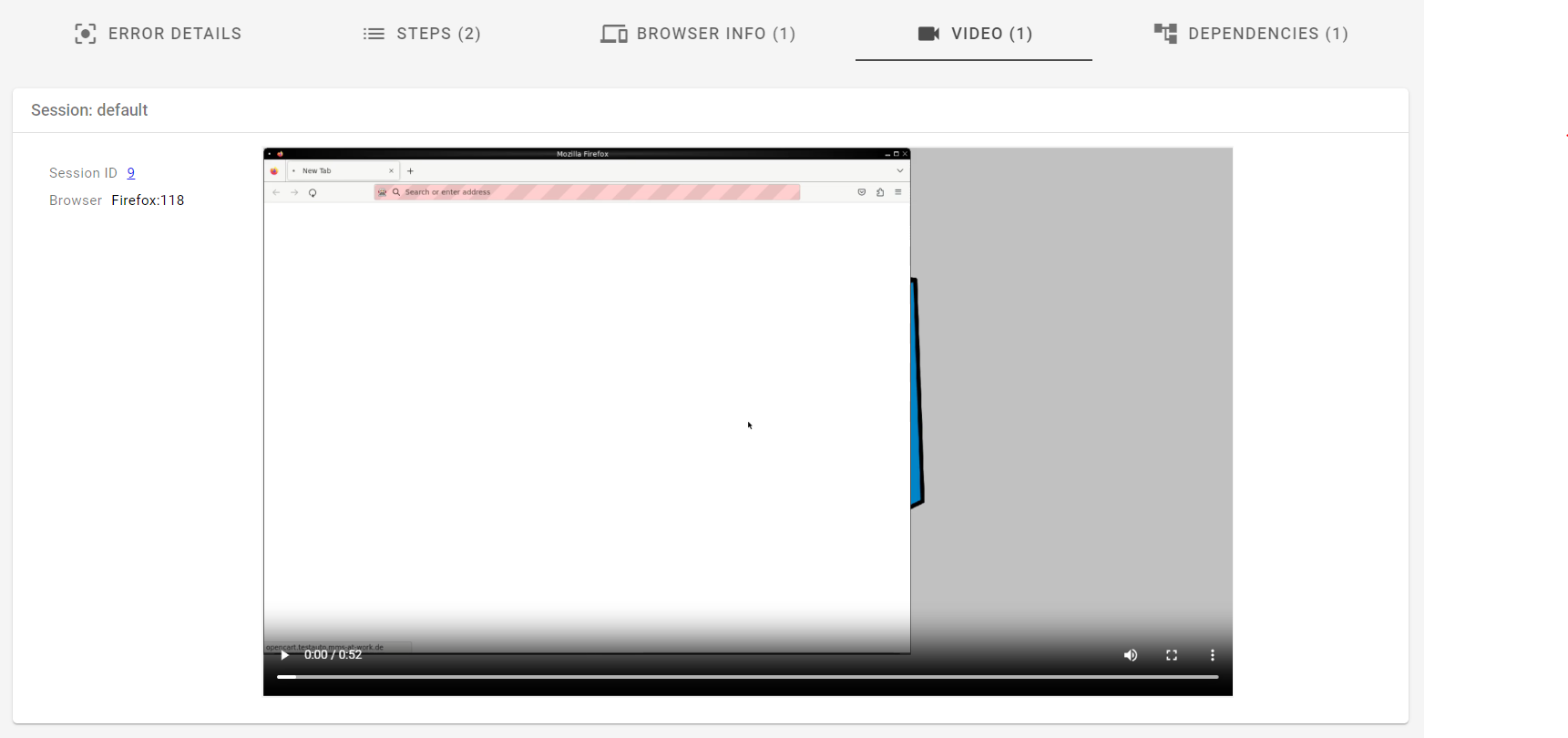
9.6. Failure Aspects View
In case of many failures it is important to be able to find out the most severe failure reasons (aspects) that caused the most failed tests cases.
For this the Failure Aspect View was designed.
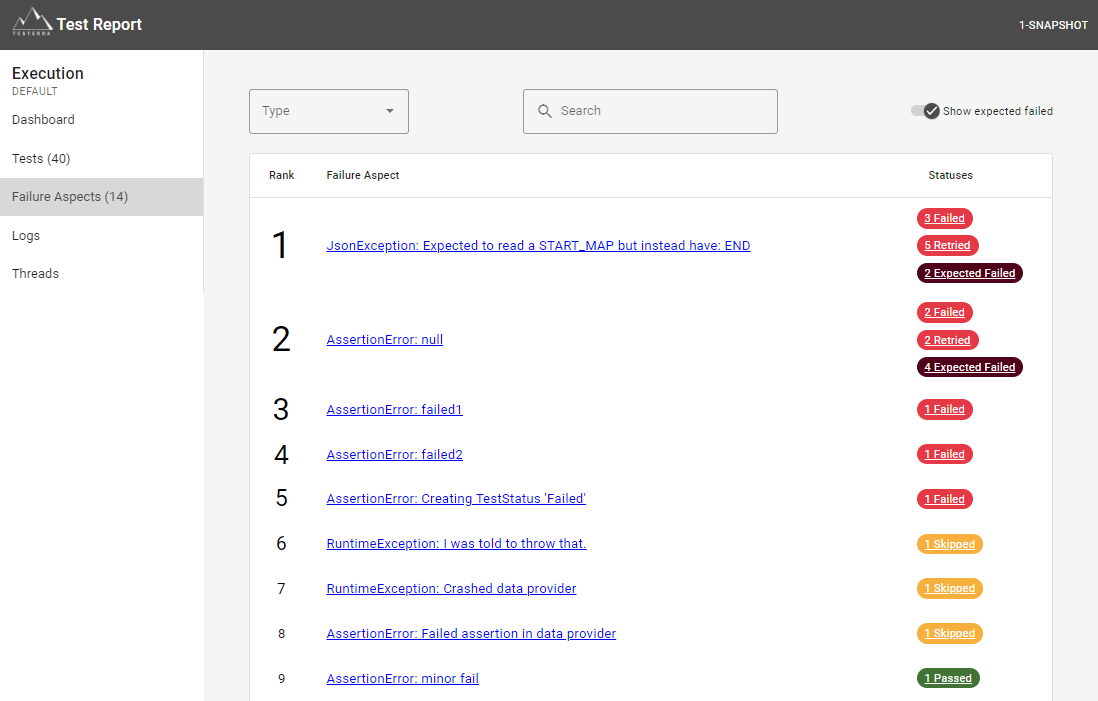
It comes with a filter as well and shows the most occurred problems on the top with the number of tests that they caused to fail.
9.7. Log View
The Log View shows all log information that were recorded during test execution. It allows to filter by message log level and to search log messages according to a given search term or keyword.
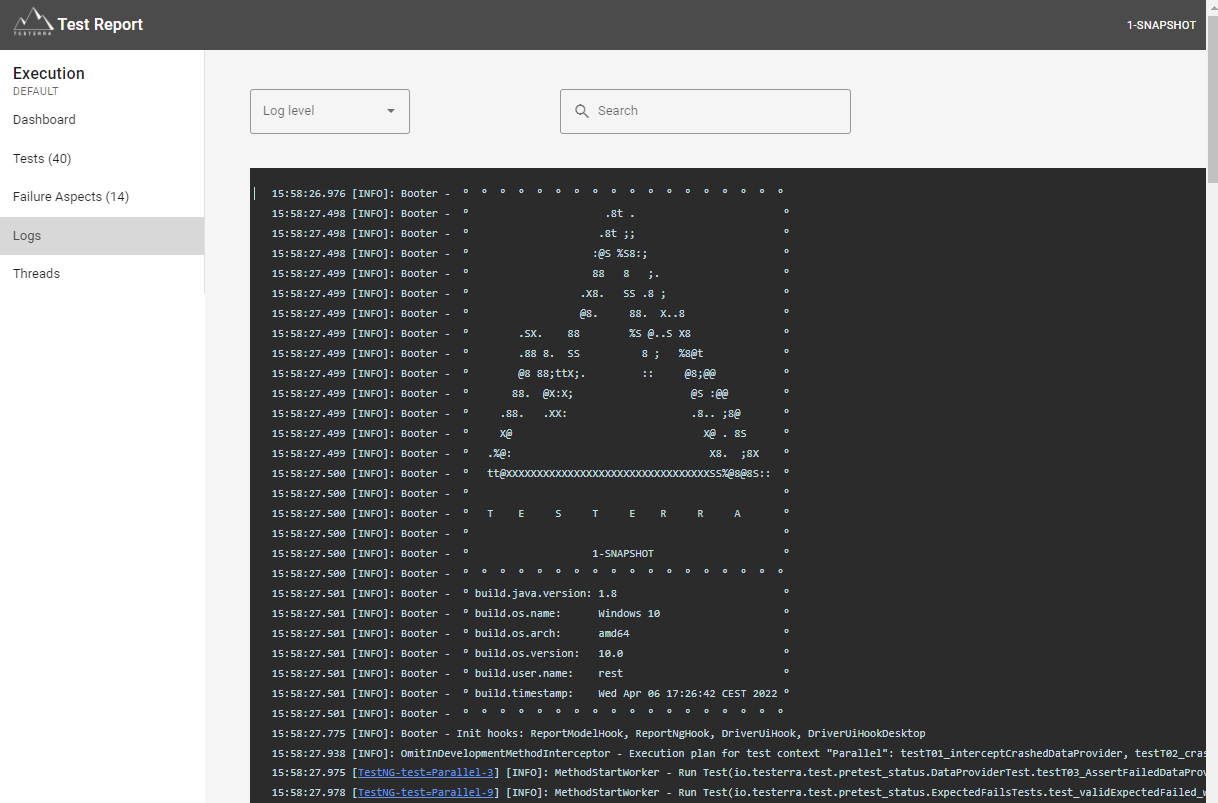
9.8. Threads View
The Threads View displays all activities on the individual worker threads in a gantt chart. The y-axis delineates the thread names, while the x-axis portrays the timeline. Test cases are visualized within the respective threads where they were executed. For details hover over a test case to view a tooltip showing the name, its Run-Index, Start- and End-time and the duration.
Navigation:
-
Use the mouse wheel to zoom in or out on the time axis.
-
Click the left button while moving the mouse to scroll horizontally.
-
Use the scroll bar on the right to scroll vertically.
Filter:
-
Use the status filter to focus on all test cases with the selected status.
-
Use the method input field to zoom in on a specific test case.
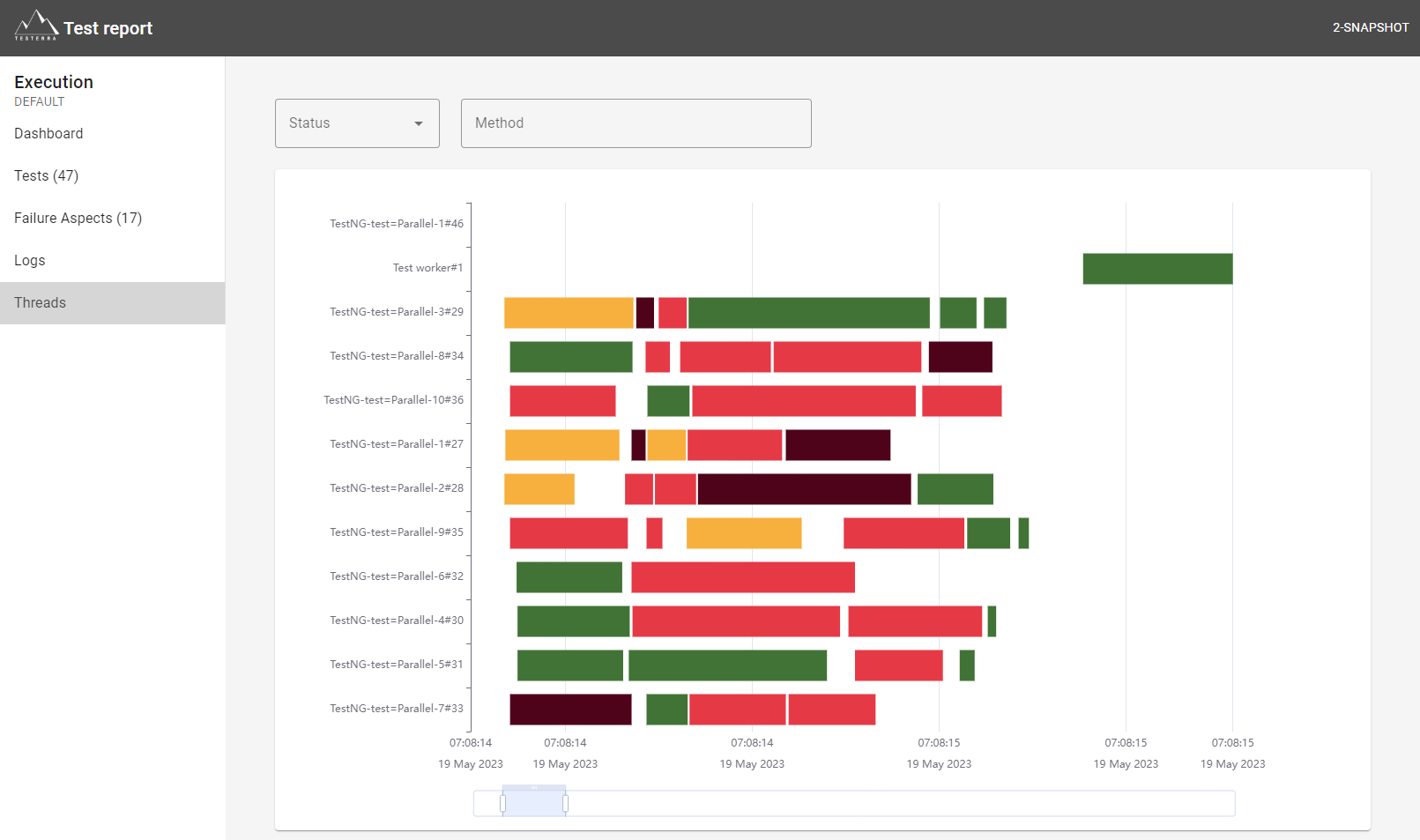
9.9. Timings View
9.9.1. Tests tab pane
All executed test cases are included in a bar chart, grouped in ranges by their execution time. By hovering over a bar the methods within this range are listed in a tooltip.
It is possible to adjust the number of method ranges by selecting a value of 5, 10, 15 or 20 in the corresponding drop-down menu. This way you can adjust the resolution of the chart.
You can also search for a specific method by entering the name of the test case in the searchbar. The corresponding bar is then highlighted.
By default, only the test methods themselves are included. However, it is possible to incorporate the configuration methods by toggling the switch located in the top right corner of the view.

9.9.2. Sessions tab pane
In the scatter chart you can see every session that was started in the test execution. On the x-axis, the starting time of session is indicated, while the loading duration is represented on the y-axis.
When hovering over any of the dots, a tooltip appears providing details regarding the browser and its version, the session name and ID, along with the test cases executed within that session.
If a base URL is configured, the load duration and timestamp of the base URL are also displayed. In this scenario, the two dots are linked, as the base URL is consistently loaded at session startup. Note that setting up a base URL is optional. If both dots exist, the hover effect will clarify which base URL dot corresponds to each session dot.
Navigation:
-
Use the mouse wheel to zoom in or out on the y-axis.
-
Move the mouse while holding the left button to scroll vertically.
-
It is also possible to use the buttons in the upper right corner to zoom into a specific area, reset the zoom and restore the chart.

9.10. History View
9.10.1. Test Run tab pane
The Test Run view provides an overview of the most important aspects of the history and highlights test cases with problematic behavior:
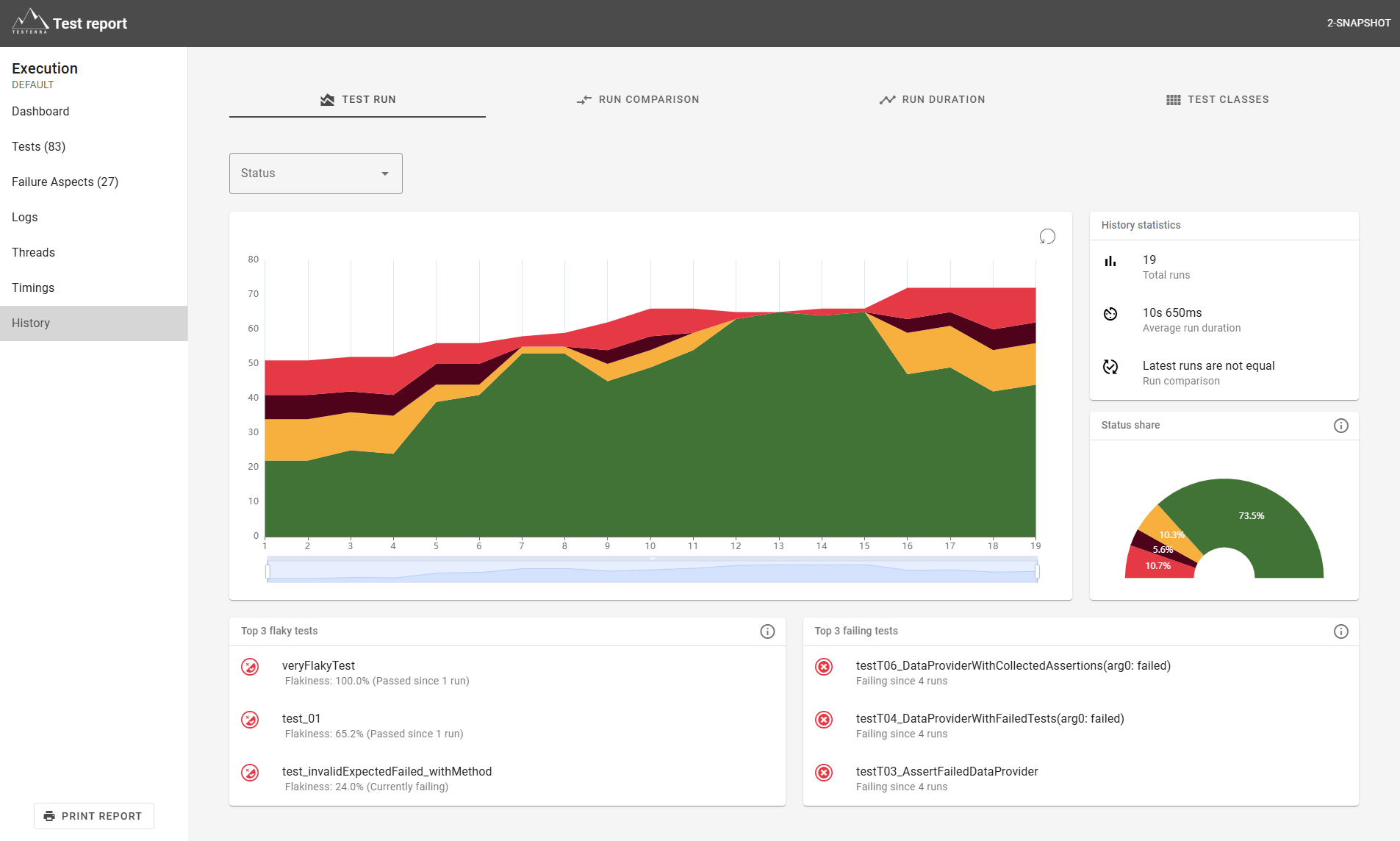
9.10.2. Run Comparison tab pane
You can compare any previous run with the current one in the Run Comparison tab:

9.11. Test Steps
It is a good and recommended practice to use test steps to increase the transparency of the test. In case of failures it is easier to understand their context.
Test steps are defined within the test code by marking their begin as demonstrated in this example test of the Testerra skeleton project:
@Test
public void testT04_TableEntryNotPresent() {
final UserModel userNonExisting = userModelFactory.createNonExisting();
TestStep.begin("Init driver and first page");
StartPage startPage = PAGE_FACTORY.createPage(StartPage.class);
TestStep.begin("Navigate to tables");
TablePage tablePage = startPage.goToTablePage();
TestStep.begin("Assert user shown.");
Assert.assertTrue(tablePage.isUserShown(userNonExisting));
}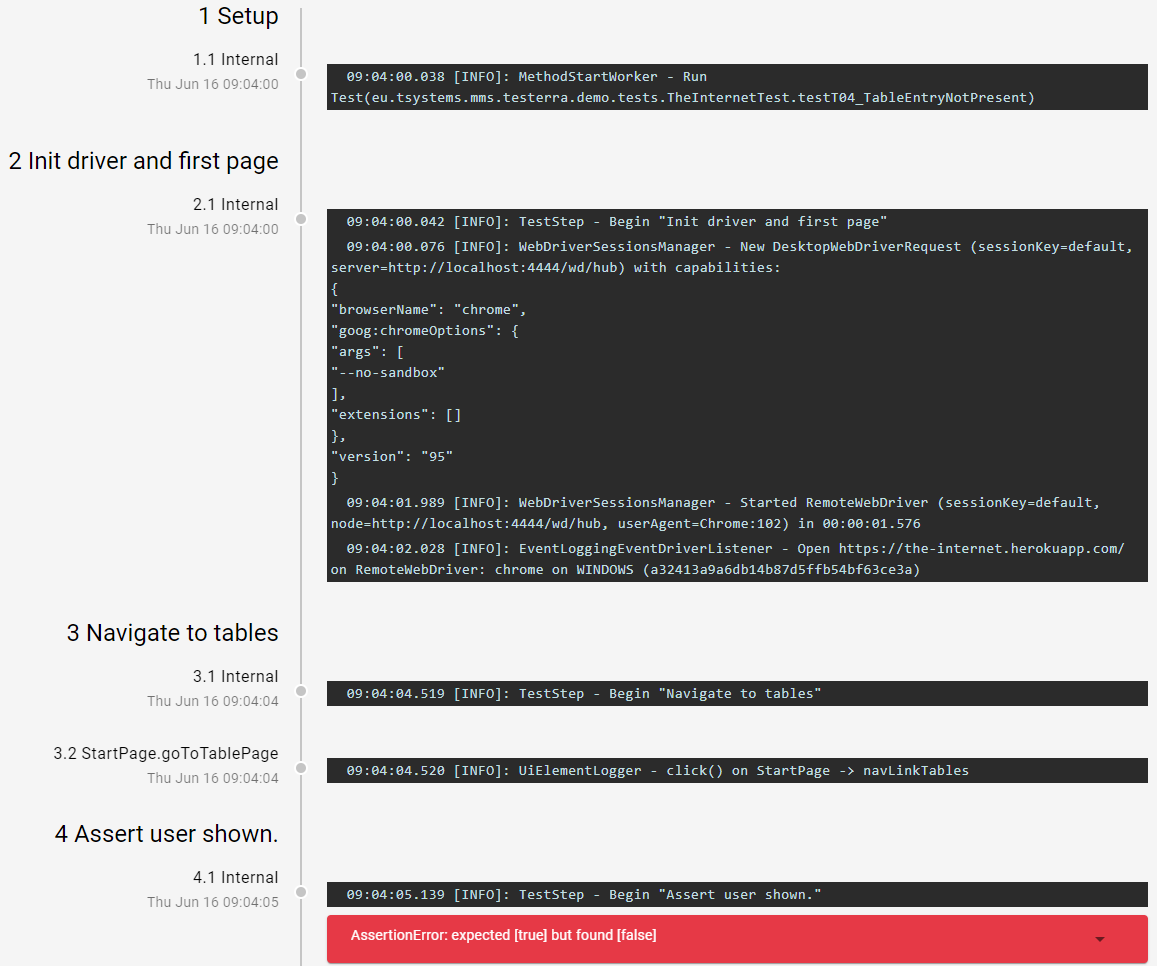
All steps are numbered automatically. The step Setup is added by Testerra.
|
9.12. Priority Messages
9.12.1. For test methods
In case you would like to have some log messages displayed on a prominent place on the test details page, you can log priority messages like this:
public class MyTestClass extends TesterraTest implements Loggable {
@Test
public void testT01_PriorityMessages() {
log().info("It's gonna be ok.", Loggable.prompt);
// some test activities ...
log().warn("Warn me!", Loggable.prompt);
// some test activities ...
log().error("Tell me more!", Loggable.prompt);
}
}As a result the information, warnings and errors are visible on the priority message panel in the center of the test detail page:
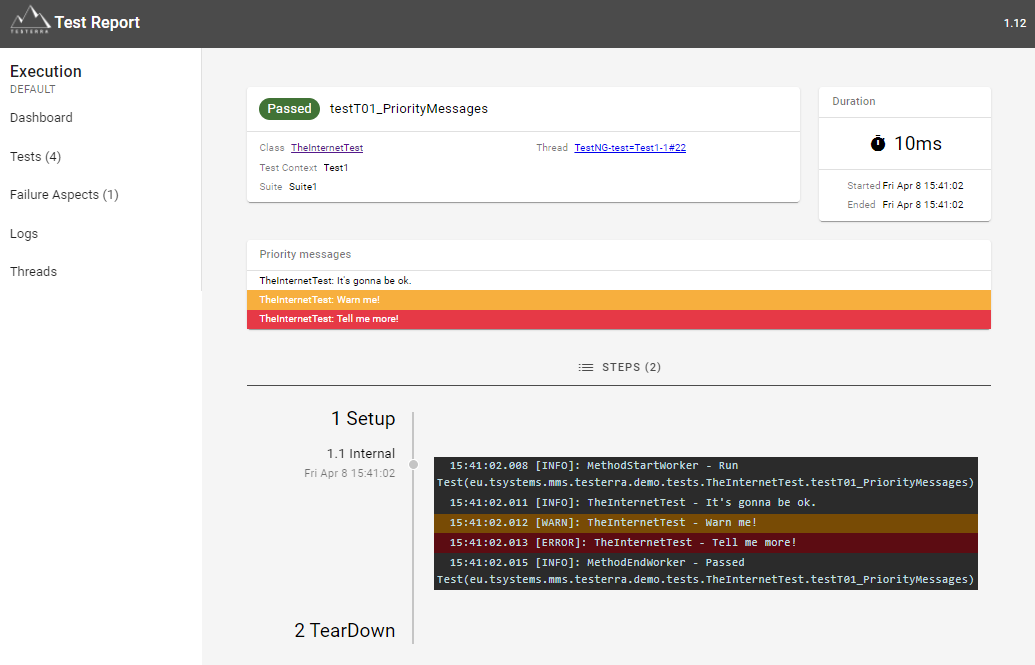
9.12.2. For global context
Priority messages can also be used to enrich the dashboard with test run specific information (e.g. the environment it was executed in. In this case log the priority message as following:
@Test(groups = "LOGS")
public void test_promptOutSideMethodContext() {
new Thread(() -> log().info("Prompt outside method context", Loggable.prompt)).start();
}The priority message is displayed on the priority message panel above the Test Classes bar chart:
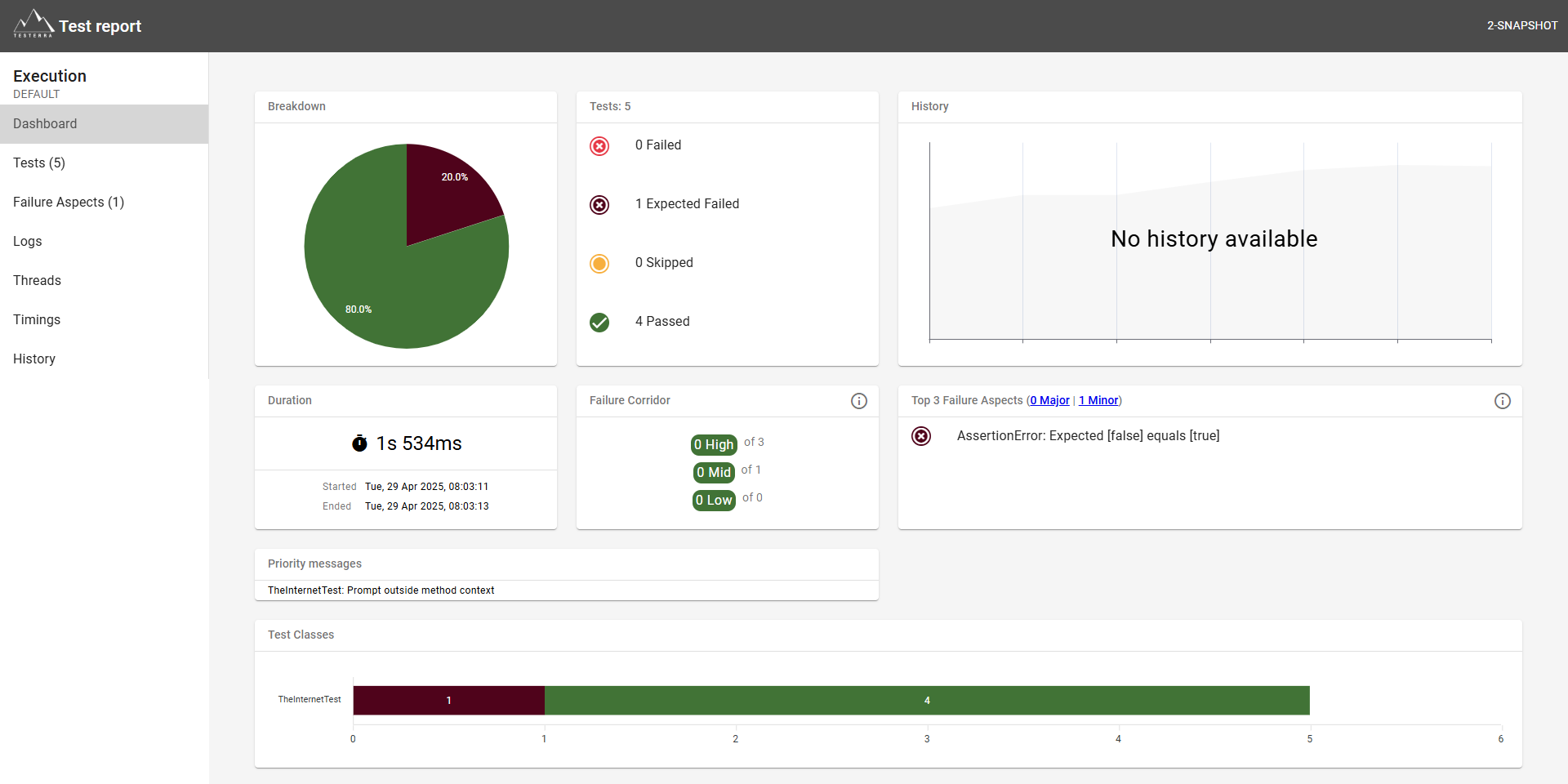
9.13. Layout Checks
In case you are using Layout Checks Report-NG provides special features to analyze failed layout tests.
9.13.1. Comparison by Image Size
When a layout test failed because there is a difference of the image size
between the actual screenshot and the reference image,
Report-NG will add a failure aspect to the test details panel:

9.13.2. Comparison by Pixel Distance
When a layout test failed because the percentage of the pixels that are different is too high (pixel distance) Report-NG will also add a failure aspect to the test details panel:

Furthermore, Report-NG provides a special dialog to compare the actual screenshot and the
reference image to actually identify the mismatching pixels. It can be opened by clicking one of the three thumbnail images. The pixel comparison dialog provides a diamond shaped slider to change the size of the left and right part of the pixel comparison area. You can also select what is displayed on the left and right part, the actual screenshot, the reference image or the pixel difference:
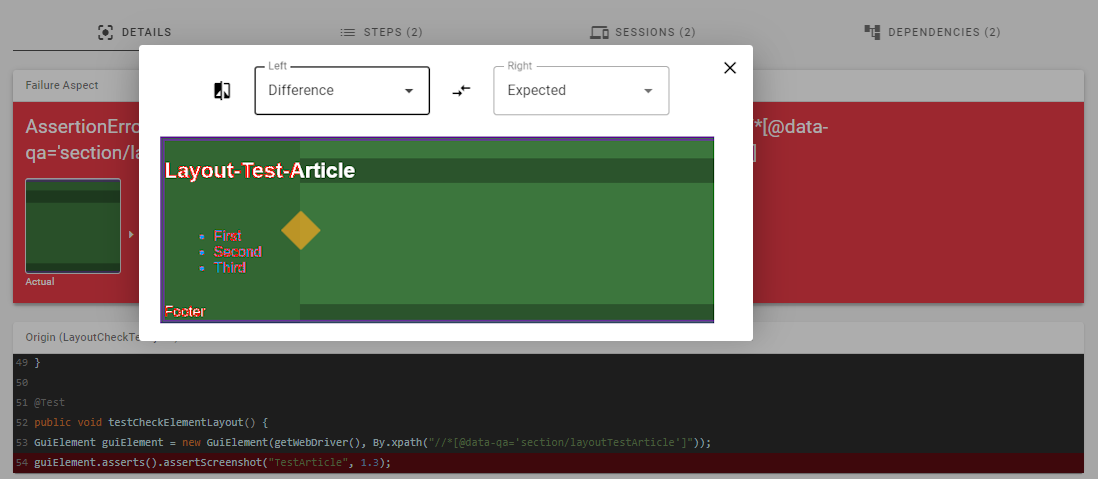
9.14. More on Assertions
9.14.1. Collected assertions
When Collected assertions are used and some of its assertions fail the test is not aborted, but it will be marked as failure in Report-NG:


The failures are marked in the step view:
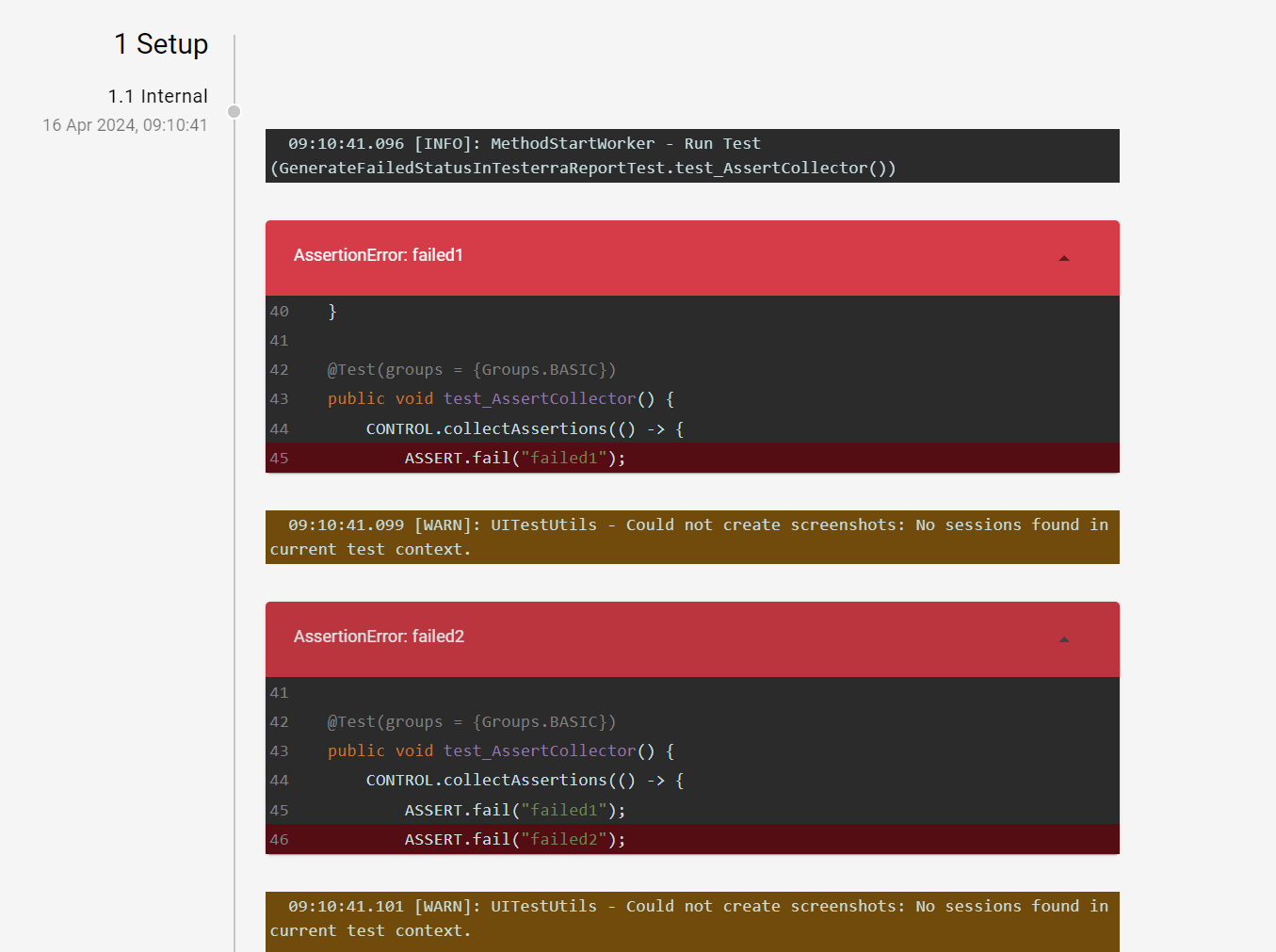
9.14.2. Optional assertions
When Optional assertions fail, the test will also be fully executed and will be marked as passed.

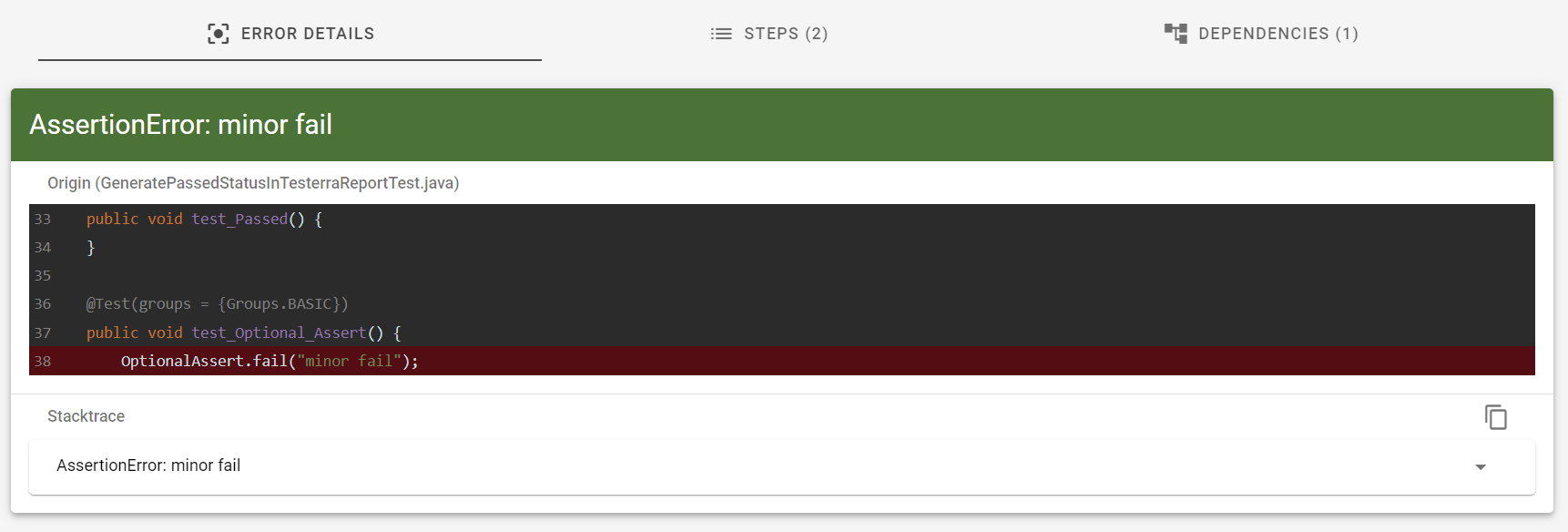
The failed optional asserts will be displayed as warnings:
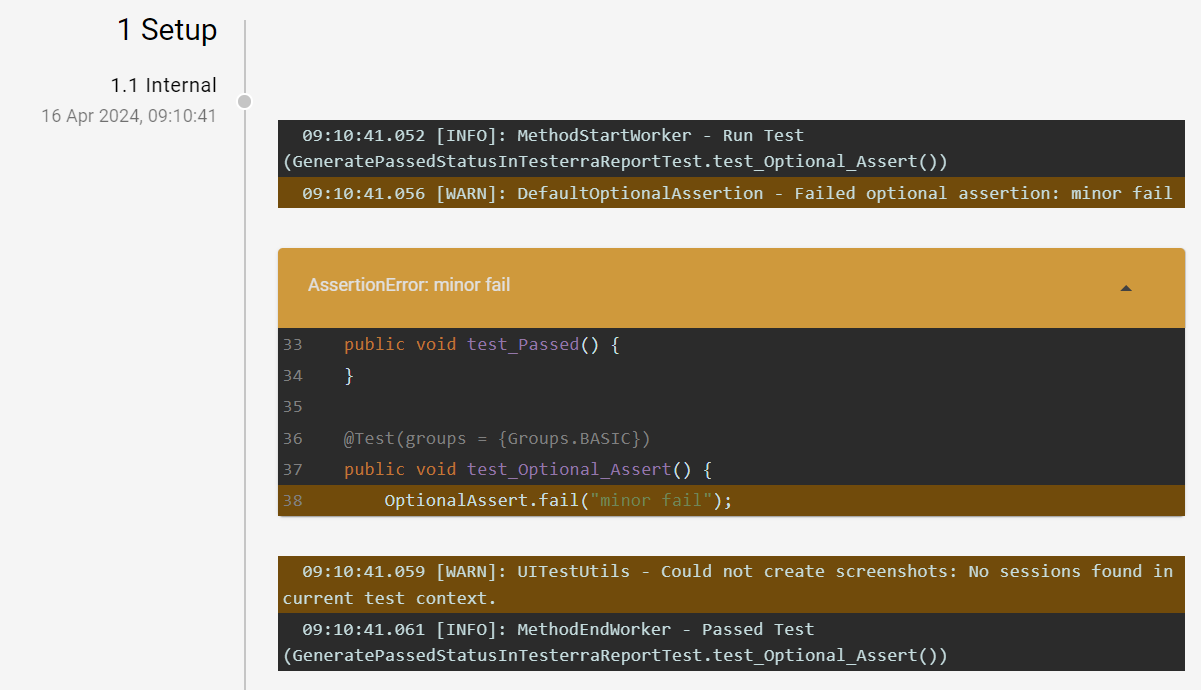
9.15. Report customizing
Some aspects of ReportNG can be customized. Have a look for the complete list of all properties.
9.15.1. Code snippet in method details
In case of using helper methods for assert test aspects it could be useful to get the source code line of the calling method, not the helper method itself.
You can exclude packages or classes with a regex definition:
# Exclude all packages or classes which names contain 'abstract' or 'foo', ignoring case sensitives
tt.report.source.exclusion.regex=(?i:abstract|foo)The following image shows the differences between default (left) and tt.report.source.exclusion.regex=AbstractSourceCodeTests (right).

| Setting this value as a local test property will be ignored because source code snippets are only collected at the end of the whole test. |
9.16. Report of aborted test runs
In case of unexpected abortion of a test execution the report is generated, too. Due to abortion of still running test methods some information can be missing, like result states or execution time.
Testerra additionally provides a mechanism to implicitly create a test report when an unexpected exit of the current execution occurred. All existing information created until the moment of the abortion are collected to generate a report. This might lead to missing as information like the execution time, result states and screenshots might be abandoned if running test methods have been interrupted.
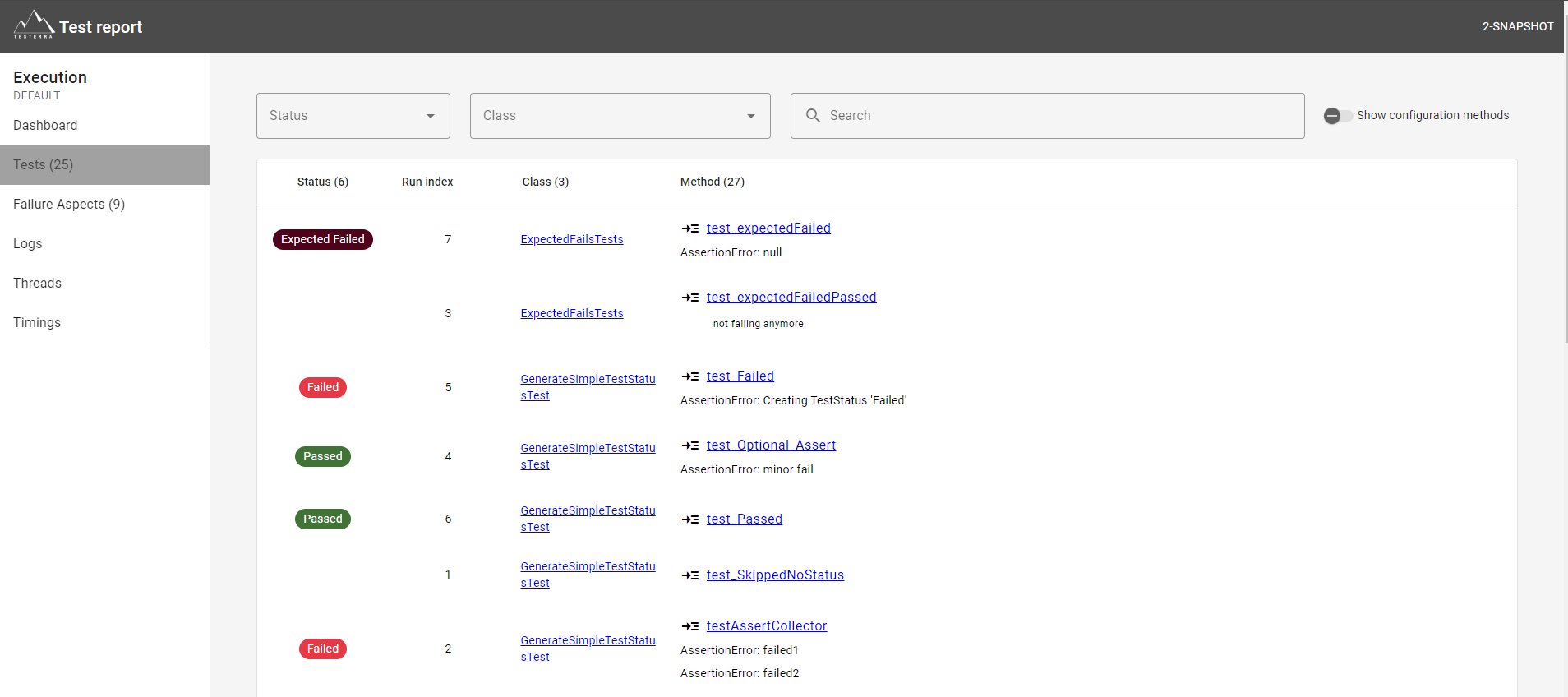
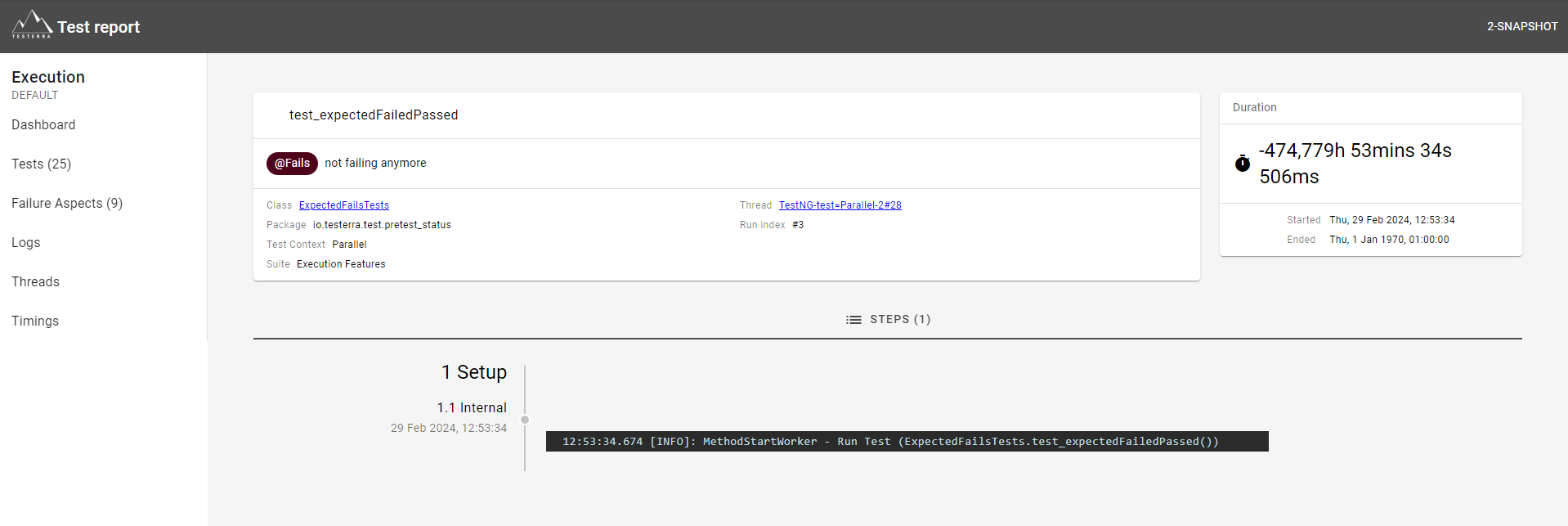
A hint indicating the possibly incomplete state of the report is shown as a warning in the section 'priority messages'. The report generation in case of abortion of the test execution is described in detail in the paragraph JVMExitHook.

9.17. Print preview
If you want to consolidate all report information into a single PDF file or print it directly, the "Print Report" feature can be accessed by clicking the button located at the bottom of the navigation drawer.
On the left side, a preview shows how the printed report might appear. It includes an indicator displaying the estimated page count as you scroll through the content.
On the right side, you will find various settings that allow you to customize the contents of the preview. By clicking the "Print" button, the final version will be sent to the browser’s print dialog, where you can print the report or download it as a PDF file.
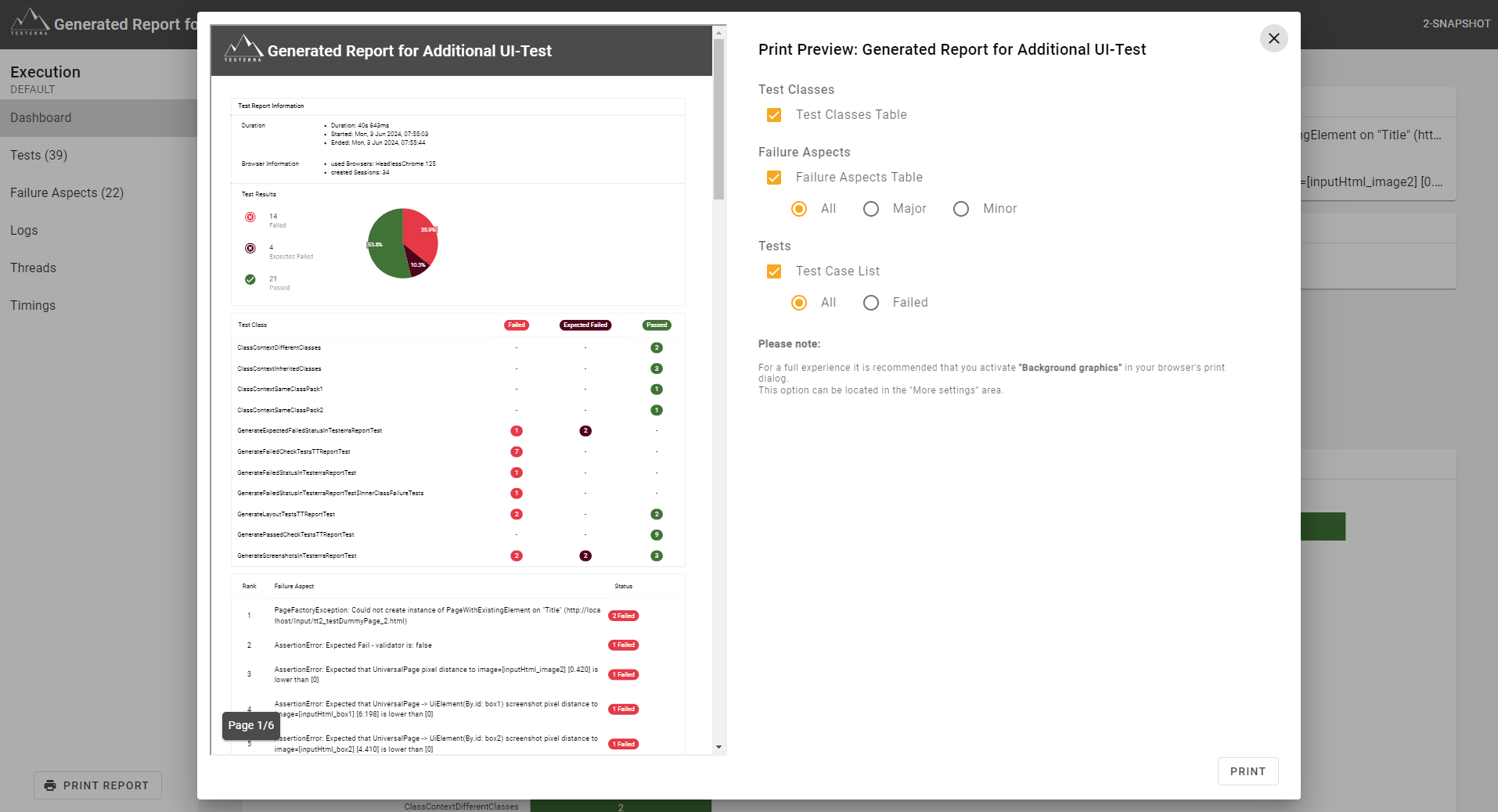
10. Modules
10.1. Layout Check
Layout tests always mean checking whether a GUI is designed according to the guidelines.
10.1.1. Introduction
Are the position, size, color and shape of the elements correct? Are distances maintained? Perhaps even certain elements are missing? In test automation, functionality is primarily tested. Here it is actually irrelevant how a button is designed and where it is positioned. The main thing is that the element can be uniquely recognized via XPath or CSS selectors.
However, in some frontends such as content management systems with a high level of relevance to end users (certain portal solutions, shops) the management is also extremely important. However, testing this with Selenium’s previous means is not in any relation between effort and benefit. Manual visual inspection is usually still the fastest way to do this.
Although, manual inspection can never be pixel-accurate. An inspection of perhaps more than 100 elements is too costly. Smaller shifts or colour deviations are easily overlooked.
At this point an automatic comparison of reference screenshots can help. This test is to be seen in addition to the functional tests, but cannot replace them. In a test case, it would also be conceivable to combine the check of function and layout.
10.1.2. How it works
A layout test with the Testerra utilities is actually a comparison between a reference and the actual state. This is done via the screenshot functionality of Selenium, in which both screenshots (reference and actual) are compared pixel by pixel from top to bottom. In this comparison, a third image is created in which differences (ReferencePixel != ActualPixel) are marked in red.

There are two different ways in which Testerra handles different sized images.
Using the property tt.layoutcheck.pixel.count.hard.assertion, you can customize the handling of such cases.
If the property is set to false (default) Testerra reports this as an Optional assertion. Only the common pixels of both images as considered as 100% for the calculation. Pixels that are outside of one or the other image are not included in the error calculation.
With the property set to true, the size difference of the two images is included in the calculation so that all pixels that appear in only one image counted as incorrect ones.
In both scenarios, all pixels outside one or the other image are marked in blue in the generated distance image.

Prerequisites
The following prerequisites must be met
-
Concrete execution environment: Layout tests should run in a concrete browser environment to ensure the comparability of the screenshots.
-
Size of browser window: Define fixed size to exclude different sizes of the images at different screen resolutions.
-
Screen resolution: Make sure you have the same screen resolution on each presentation device.
-
Scaling: The scaling should always be set to 100%. Using a different scaling causes variations in the positions of the elements on the website. For more details, see this Selenium issue.
10.1.3. Configuration
In order to get the layout check to work, you need at least a reference image and a place where it’s located.
tt.layoutcheck.reference.path=src/test/resources/layout-references/{tt.browser}
tt.layoutcheck.reference.nametemplate=%s.png
# Highly recommended to disable full screen for browser
tt.browser.maximize=false
# Highly recommended to switch of the demo mode for layout tests
tt.demomode=falseThe directory for reference image may result in src/test/resources/layout-references/chrome/WelcomePage.png for example.
The comparison is generally carried out over the entire reference image. In this case, it is a prerequisite that the reference screenshot and the screenshot created during the test runtime have the same resolution (height and width are identical).
10.1.4. Check the whole page
// 1% of the pixels are allowed to be different
float pixelDistanceToleranceThresholdPercent = 1.0;
page.expect().screenshot().pixelDistance("WelcomePage").isLowerThan(pixelDistanceToleranceThresholdPercent);
To organize the reference screenshots in subfolders you can add the relative structure to the name like my/additional/folder/WelcomePage.
|
10.1.5. Check a single UiElement
To check the layout of a single UiElement only, you can use the standard asserts implementation.
// 10% of the pixels are allowed to be different
float pixelDistanceToleranceThresholdPercent = 10.0;
uiElement.expect().screenshot().pixelDistance("HeaderComponent").isLowerThan(pixelDistanceToleranceThresholdPercent);10.1.6. Check images with RGB deviation
The property tt.layoutcheck.pixel.rgb.deviation.percent controls, which color difference in percentage of a single pixel is count as a match. You can use that value to handle slightly changes in color or alpha values.
Especially for photo checks it should be helpful in case of different kinds of image formats and compression algorithms.
tt.layoutcheck.pixel.rgb.deviation.percent=0.0 |
tt.layoutcheck.pixel.rgb.deviation.percent=2.0 |
|---|---|
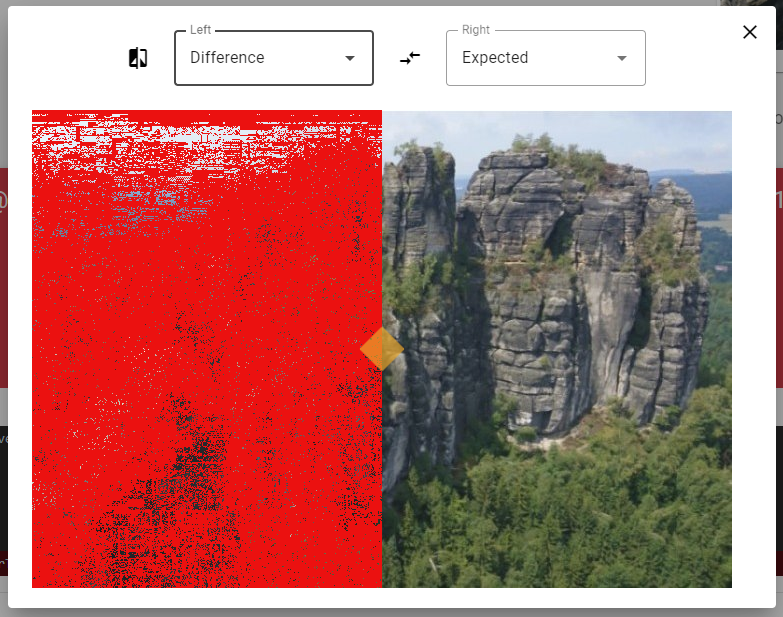
|
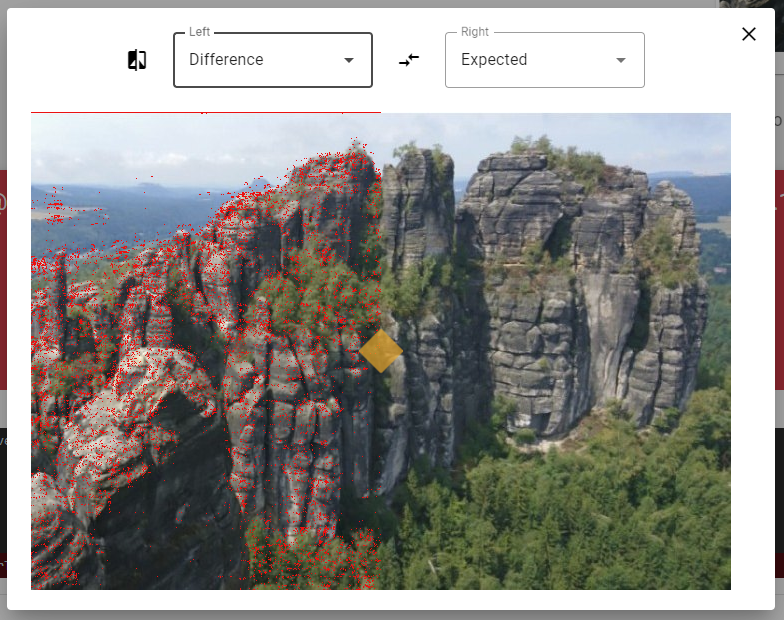
|
10.1.7. Check image files
In case you don’t want to check a screenshot of the browser but rather a pre-existing image, there is also a way to do that.
The assertImage method requires the File object of the actual image and executes a layout check.
// 5% of the pixels are allowed to be different
float pixelDistanceToleranceThresholdPercent = 5.0;
File absoluteFile = FileUtils.getResourceFile("images/actual.png");
LayoutCheck.assertImage(absoluteFile, "reference", pixelDistanceToleranceThresholdPercent);10.1.8. Take reference screenshots on first run
When you have configured the reference screenshots location and implemented the tests, you can now set the option
tt.layoutcheck.takereference=trueto enable taking automatically screenshots based on the current browser and size configuration and storing them to the reference image’s location.
All concrete distance values in this tt.layoutcheck.takereference-mode will return 0 (zero) and always pass the tests.
|
10.1.9. Reporting
Report-NG provides a good presentation of the results of layout checks. See here for more details.
10.2. Localization
Websites come in many languages, where the functionality may not change, but labels of buttons, input or other interactive elements.
Testerra provides an easy and simple way to support the localization of UiElements based on Locale.
10.2.1. Enable Unicode for your project
In build environments, where Unicode is not default, you should force to use it in your project by setting the Java compile options.
compileJava.options.encoding = 'UTF-8'
compileTestJava.options.encoding = "UTF-8"<project.build.sourceEncoding>UTF-8</project.build.sourceEncoding>For Gradle, you should also set your system-wide or local gradle.properties.
systemProp.file.encoding=utf-810.2.2. Add localization resource bundle
The localization is based on Unicode .properties files loaded during runtime.
To add such files, create a new resource bundle lang in src/main/resources and add all required locales.
BTN_LOGIN=LoginBTN_LOGIN=Anmelden
You can change the default encoding for .properties files in IntellJ at File → Settings → File Encodings
|

10.2.3. Access localization text
Now you can instance UiElements by localized strings.
import eu.tsystems.mms.tic.testframework.l10n.SimpleLocalization;
UiElement loginBtn = find(By.linkText(SimpleLocalization.getText("BTN_LOGIN")));SimpleLocalization uses Locale.getDefault() by default, but
you can switch the default locale the following way.
LocalizedBundle defaultBundle = SimpleLocalization.setDefault(Locale.GERMAN);10.2.4. Session based localization
For thread-safe localization, you can use session based localization by initializing your localized bundles based on the session’s locale.
Locale sessionLocale = WebDriverManager.getSessionLocale(WebDriver).orElse(Locale.getDefault());
LocalizedBundle sessionBundle = new LocalizedBundle("testdata", sessionLocale);
sessionBundle.getString("TEST_KEY");When the SUT locale changes, you should also set the session’s locale:
public class LocalizedPage extends Page {
public void switchLocale(Locale locale) {
// Implement your language switch here
// ...
// Don't forget to set the sessions locale
WebDriverManager.setSessionLocale(getWebDriver(), locale);
}
}10.2.5. Change locale from command line (recommended)
The best way to change the locale for your tests is, to pass the language property as command line argument.
gradle test -Duser.language=deFor Maven, you need some extra configuration
<project>
<properties>
<user.language>de</user.language>
<user.country>DE</user.country>
<argLine>-Duser.language=${user.language} -Duser.country=${user.country}</argLine>
</properties>
</project>before running the command
mvn test -Duser.language=de -Duser.country=DE10.2.6. Change locale from property
When you want to change the locale from a property. Do the following
String testLanguage = PROPERTY_MANAGER.getProperty("test.language", "de");
Locale.setDefault(Locale.forLanguageTag(testLanguage));10.2.7. Change locale for the user agent
The WebDriver API official doesn’t support changing the language of a browser session. But there exists non-standard or experimental ways on Stackoverflow to change your browser locale.
Anyways, it’s currently the better way to visit your SUT with a predefined language and change it there (with a language switcher).
10.3. Mail connector
The module mail-connector allows you to send and receive/read emails as well as solve mail surrounding tasks like encoding or encrypting.
The Mail connector uses Jakarta Mail 2.
10.3.1. Project setup
// build.gradle
compile 'io.testerra:mail-connector:2.11'<!-- pom.xml -->
<dependencies>
<dependency>
<groupId>io.testerra</groupId>
<artifactId>mail-connector</artifactId>
<version>2.11</version>
</dependency>
</dependencies>Configuration Parameters
All MailConnector classes need parameters to connect to the corresponding server. These are set within the mailconnection.properties file or by system properties. The following parameters must be set.
#SMTP
SMTP_SERVER=smtp.mailserver.com
SMTP_SERVER_PORT=25
SMTP_USERNAME=user
SMTP_PASSWORD=password
#POP3
POP3_SERVER=pop.mailserver.com
POP3_SERVER_PORT=110
POP3_FOLDER_INBOX=inbox
POP3_USERNAME=user
POP3_PASSWORD=password
# IMAP
IMAP_SERVER=imap.mailserver.com
IMAP_SERVER_PORT=143
IMAP_FOLDER_INBOX=INBOX
IMAP_USERNAME=user
IMAP_PASSWORD=password
# TIMING for POP3 and IMAP
# sets the timeout between polls, default = 50s
POLLING_TIMER_SECONDS=10
# sets the maximum number of polls, default = 20
MAX_READ_TRIES=20If you want to use an SSL-encrypted connection, you need to set SMTP_SSL_ENABLED / POP3_SSL_ENABLED to true. The ports must then be adjusted according to the server.
The actual connection to the mail server is implicitly opened within each MailConnector class.
10.3.2. Common notes
Please note that Jakarta Mail 2 changed some packages. If you update to the latest Mail connector you have to change your imports:
// Jakarta Mail 1.6.x
import javax.mail.Message;
import javax.mail.internet.MimeBodyPart;
import javax.mail.search.AndTerm;
import javax.mail.search.SearchTerm;
...
// Jakarta Mail 2.x
import jakarta.mail.Message;
import jakarta.mail.internet.MimeBodyPart;
import jakarta.mail.search.AndTerm;
import jakarta.mail.search.SearchTerm;
...10.3.3. POP3MailConnector
The POP3MailConnector provides access to a POP3 server. Emails are read and processed by using methods of the superclass AbstractInboxConnector. Specific mails can be extracted with serverside filtering by matching given criteria expressed with SearchTerm (see Jakarta Mail API)
POP3MailConnector pop3MailConnector = new POP3MailConnector();
// wait until the email with subject 'test' arrived in the InboxFolder
SubjectTerm subjectTerm = new SubjectTerm(subject);
EmailQuery query = new EmailQuery().setSearchTerm(subjectTerm);
Email email = pop3MailConnector.query(query).findFirst().get();
// delete all emails with this subject from the server while setting timeout and max number of polls explicitly
query.setRetryCount(5);
query.setPauseMs(2000);
Email email = pop3MailConnector.query(query).findFirst().get();
// delete mails matching the given criteria
String recipient = email.getRecipients().get(0));
SearchTerm searchTerm = new AndTerm(new SearchTerm[]{
subjectTerm,
new RecipientTerm(RecipientType.TO, new InternetAddress(recipient))
});
pop3MailConnector.deleteMessage(searchTerm);// wait until the email with subject 'test' arrived in the InboxFolder
EmailQuery query = new EmailQuery().setSearchTerm(new SubjectTerm(subject));
Email email = pop3MailConnector.query(query).findFirst().get();
try {
Multipart content = (Multipart) email.getMessage().getContent();
int contentCnt = content.getCount();
String attachmentFileName = null;
for (int i = 0; i < contentCnt; i++) {
Part part = content.getBodyPart(i);
// Retrieve attachment
if (part.getDisposition().equals(Part.ATTACHMENT)) {
attachmentFileName = part.getFileName();
}
}
} catch (IOException e) {
e.printStackTrace();
} catch (MessagingException e) {
e.printStackTrace();
}10.3.4. SMTPMailConnector
This entity allows sending emails via the SMTP protocol.
SMTPMailConnector smtpMailConnector = new SMTPMailConnector();
// send a created message
MimeMessage createdMessage = new MimeMessage(session);
try {
msg.addRecipients(RecipientType.TO, RECIPIENT);
msg.addFrom(new Address[]{new InternetAddress(SENDER)});
msg.setSubject("testerra");
msg.setText("mail text");
} catch (MessagingException e) {
LOGGER.error(e.toString());
}
smtpMailConnector.sendMessage(createdMessage);
// send an existing message
MimeMessage existingMessage = MailUtils.loadEmailFile("test-mail.eml");
smtpMailConnector.sendMessage(existingMessage);10.3.5. ImapMailConnector
The ImapMailConnector operates like the POP3MailConnector with an additional method to mark all mails as seen.
ImapMailConnector imapMailConnector = new ImapMailConnector();
EmailQuery query = new EmailQuery().setSearchTerm(new SubjectTerm(subject));
imapMailConnector.query(query).findFirst().ifPresent(email -> {
// EMail found
});
// mark all mails in inbox as seen
imapMailConnector.markAllMailsAsSeen();
// delete all mails in inbox
imapMailConnector.deleteAllMessages();10.3.6. Get simply the message count
You can get the message count for the inbox, of a specified folder name.
connector.getMessageCount();
connector.getMessageCount("FolderName");10.3.7. SSL settings and trusting hosts for self-signed certificates
SSL is enabled per default for POP3 and IMAP and can be configured via. properties.
IMAP_SSL_ENABLED=false
POP3_SSL_ENABLED=false
SMTP_SSL_ENABLED=trueThe MailConnector uses Certificate Utilities for trusting hosts.
10.3.8. Custom configuration
You can set properties to the JavaMail framework like:
connector.configureSessionProperties(properties -> {
properties.put("mail.imaps.auth.ntlm.disable", true);
});See the original documentation for more information:
10.3.9. Debugging the MailConnector
Enable the debug mode programatically
connector.getSession().setDebug(true);or via Properties
DEBUG_SETTING=true10.3.10. Best Practices
Combine search terms
You can combine search terms the following way
EmailQuery query = new EmailQuery();
query.withAllOfSearchTerms(
new SubjectTerm("My Subject"),
new ReceivedDateTerm(DateTerm.EQ, new Date())
);
// or
SearchTerm oneOf = new OrTerm(
new SubjectTerm("My Subject"),
new SubjectTerm("PetsOverNight.com"),
);
query.setSearchTerm(oneOf);
// or
List<SearchTerm> searchTerms = new ArrayList<>();
searchTerms.add(oneOf);
searchTerms.add(new ReceivedDateTerm(DateTerm.EQ, new Date()));
query.withAllOfSearchTerms(searchTerms);Find emails by specified date
To find emails for a specified date, you should combine the SentDateTerm and an explicit filter, because the internal library is not able to filter by exact
date with the IMAP protocol.
EmailQuery query = new EmailQuery();
Date now = new Date();
// Query emails that arrived today
query.setSearchTerm(new SentDateTerm(ComparisonTerm.GE, now));
connector.query(query)
.filter(email -> email.getSentDate().after(now))
.forEach(email -> {
// EMail found
});10.3.11. MailUtils
This helper class contains methods which facilitate reoccurring tasks when working with mails, e.g. encrypting, decrypting and comparing mails.
String pahtKeyStore = "your/path/to/cacert.p12";
String password = "123456";
String subject = "test";
String sentContent = "Testerra Testmail"
SMTPMailConnector smtpMailConnector = new SMTPMailConnector();
Session session = smtpMailConnector.getSession();
MimeMessage sentMessage = new MimeMessage(session);
sentMessage.setText(sentContent);
sentMessage.setSubject(subject);
// encrypt message
MimeMessage encryptedMsg = MailUtils.encryptMessageWithKeystore(sentMessage, session, pahtKeyStore, password);
smtpMailConnector.sendMessage(encryptedMsg);
Email receivedMsg = waitForMessage(subject);
// compare Mails and verify difference due to encryption
boolean areContentsEqual = MailUtils.compareSentAndReceivedEmailContents(sentMessage, receivedMsg);
Assert.assertFalse(areContentsEqual);
// decrypt message
MimeMessage decryptedMsg = MailUtils.decryptMessageWithKeystore(encryptedMsg, session, pahtKeyStore, password);
// verify receivedContent is equal to sentContent
String receivedContent = ((Multipart) decryptedMsg.getContent()).getBodyPart(0).getContent().toString();
Assert.assertEquals(receivedContent, sentContent);10.4. PropertyManager
The PropertyManagerProvider interface provides a PROPERTY_MANAGER instance of IPropertyManager
String property = PROPERTY_MANAGER.getProperty("my.property", "default");
Long longProperty = PROPERTY_MANAGER.getLongProperty("my.long", 200L);
Double doubleProperty = PROPERTY_MANAGER.getDoubleProperty("my.double", 200.0);
Boolean booleanProperty = PROPERTY_MANAGER.getBooleanProperty("my.boolean", false);It will look for the property definition appearance in the following order:
-
System.getProperties()(system.properties) -
Property files (
test.properties)
When it’s still not defined, it will fall back to the given default value.
10.4.1. Property files
Testerra supports to load .properties files located under test/resources.
The following files are loaded automatically at Testerra start (in that order):
-
test.properties -
system.properties
The test.properties is called the Test Configuration and contains everything required by the test, like Browser setup, SUT credentials or Layout test thresholds.
You can load additional properties files at any time.
PROPERTY_MANAGER.loadProperties("my.property.file");| This will override already defined properties. |
10.4.2. System properties
When a system.properties exists, Testerra loads and sets the given properties via System.setProperty() if they are not present already.
| This will not override already defined system properties given by the command line. |
The path of this file can be changed by tt.system.settings.file and will be automatically loaded with the following message
common.PropertyManager - Load system properties: /path/to/your/system.properties
10.5. Connectors
While using the framework some external connectors could be useful. The maintainers provide some of them in separate repositories. Please take a look at the following list if there is a connector mapping your need.
| Name | Description |
|---|---|
Uses the open source standard Appium to run web tests based on Testerra on mobile devices. |
|
Automatic test result synchronization for Microsoft AzureDevOps platform. |
|
Provides the opportunity to use Cucumber and Gherkin to specify |
|
Automatic test result synchronization to HP Application Lifecycle Management, former called HP QualityCenter. |
|
Using a Selenium Grid based on Selenoid this module provides access to videos and VNC streams. |
|
A simple notification service for Jetbrains TeamCity. |
|
Automatic test result synchronization Jira XRay. |
11. Utilities
11.1. Assert Utilities (deprecated)
This class has been replaced by the Assertion interface, therefore marked as @deprecated and should not be used anymore.
|
This class provides some extra assertion methods for TestNG:
AssertUtils.assertContains("Hello World", "Martin", "Greeting");
// Greeting [Hello World] contains [Martin] expected [true] but found [false]
AssertUtils.assertContainsNot("Hello World", "World", "Greeting");
// Greeting [Hello World] contains [World] expected [false] but found [true]
AssertUtils.assertGreaterEqualThan(new BigDecimal(2), new BigDecimal(4), "High number");
// High number [2] is greater or equal than [4] expected [true] but found [false]
AssertUtils.assertLowerThan(new BigDecimal(2), new BigDecimal(-1), "Low number");
// Low number [2] is lower than [-1] expected [true] but found [false]11.2. Certificate Utilities
You can trust specified hosts in a whitespace separated list like
tt.cert.trusted.hosts=example.com google.comOr just trust any (not recommended)
tt.cert.trusted.hosts=*You can also configure this programatically like
CertUtils certUtils = CertUtils.getInstance();
String trustedHosts[] = {"t-systems.com"};
certUtils.setTrustedHosts(trustedHosts);
certUtils.setTrustAllHosts();This will configure accepting certificates where possible:
-
User agents
ACCEPT_INSECURE_CERTScapability -
All internal APIs that use
HttpsURLConnectionlikeFileDownloaderorMailConnector
You can also set defaults for all created SSLSocketFactory and HostnameVerifier.
// Trust all certificates in the current Java VM instance.
certUtils.makeDefault();11.3. Desktop WebDriver utilities
This utility class provides some additional methods to interact with web elements.
|
Please consider this utility class as a fallback solution. It could be useful if elements are hidden or not reachable by Selenium. |
11.3.1. Supported actions
UiElement element = find(By.id("label"));
DesktopWebDriverUtils utils = new DesktopWebDriverUtils();
utils.clickJS(element);The following methods are supported:
-
clickJS()
-
rightClickJS()
-
doubleClickJS()
-
mouseOverJS()
-
clickAbsolute()
-
mouseOverAbsolute2Axis()
-
clickByImage()
-
mouseOverByImage()
See Mouse over for more details about the mouseOverAbsolute2Axis method.
11.3.2. mouseOver vs. mouseOverAbsolute2Axis
The mouseOverAbsolute2Axis method does not move the mouse pointer relativly from the last position.
The following graphic shows 2 different mouse pointer paths beginning at the upper right image to the button 1.
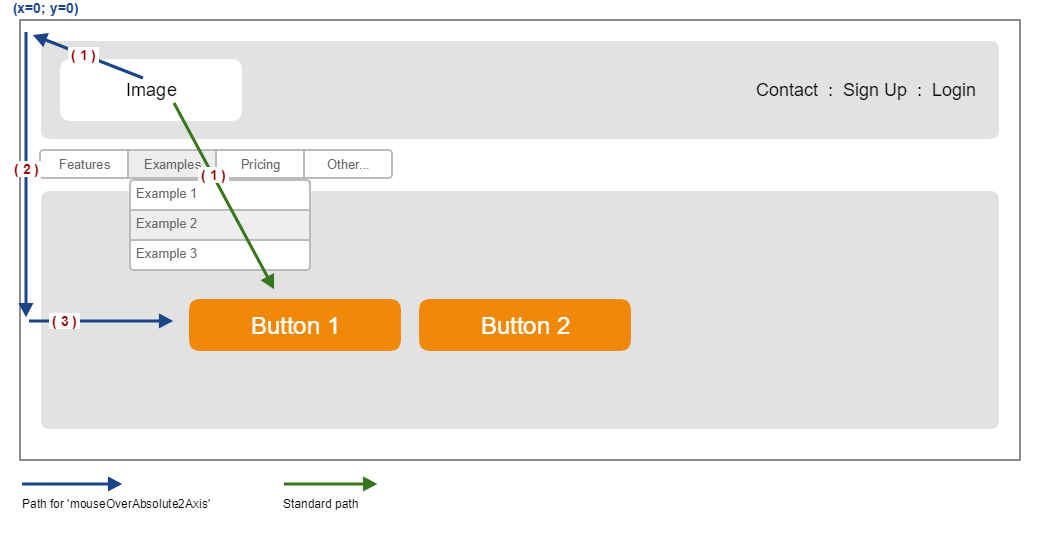
The standard path (green) goes over a menu with hover effects. This could hide your target element. The blue path variant always goes first to the point (0,0) of the viewport, then in x and y direction the the target element.
11.3.3. By-image-utils
The clickByImage and mouseOverByImage methods use the image recognition technology of sikuli-api to locate a part of the current web page using a screenshot placed in the src/test/resources/ directory.
After the referenced element was found, the operation is performed (either click or mouseOver) at the corresponding location, the center of the found screen region, using Selenium actions.
These methods are useful, if some elements can not be accessed in the usual way, for example if they are inside a canvas or svg element.
The following graphic shows the report-ng threads view with a selected testcase in the method filter, which is visible on the page but cannot be accessed since the chart is a canvas element.
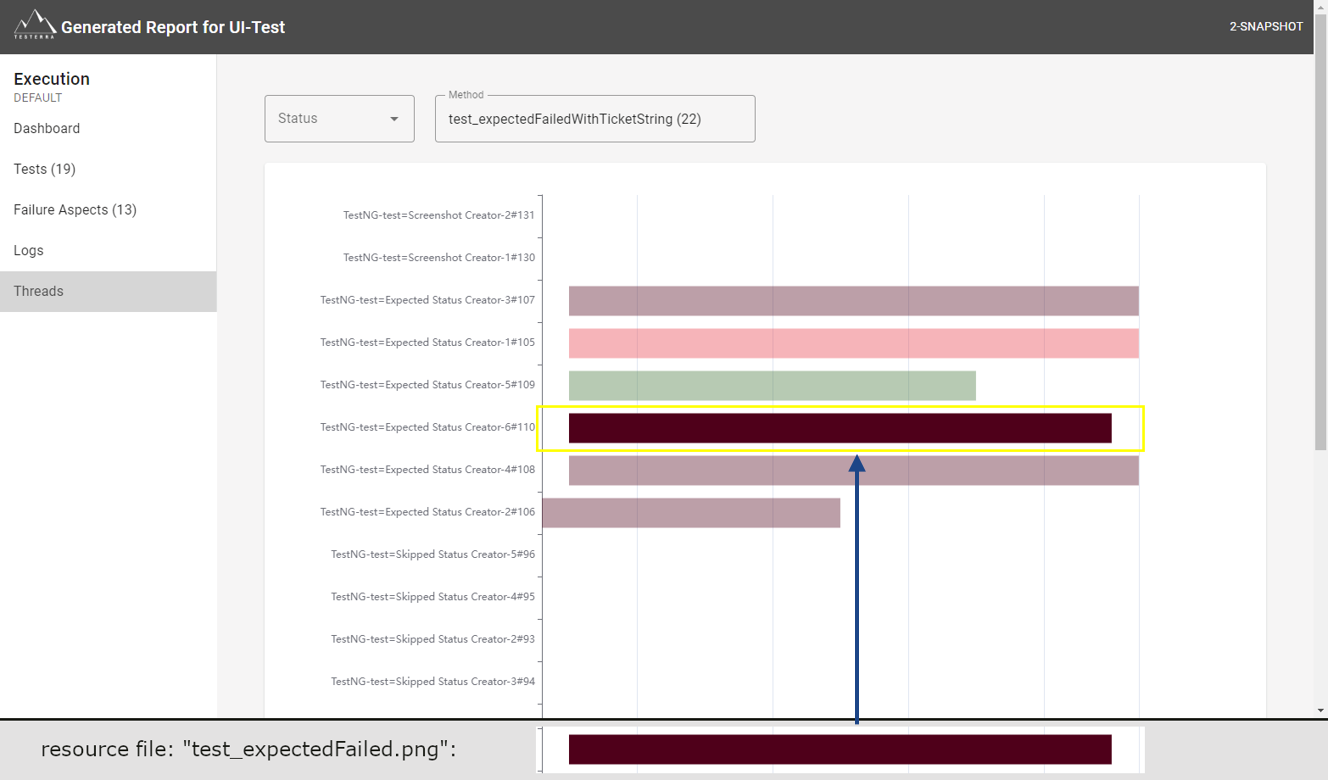
With a screenshot of this method, in this case "test_expectedFailed.png", the by-image-utils can be used to find this element and perform a mouseOver or click action in the center of the test method bar.
11.4. JavaScript Utilities
JSUtils provide some helper methods to inject and execute JavaScript code via WebDriver.
11.4.1. Execute JavaScript
Sometimes in automated testing for web applications you want to access your system under test by JavaScript or you just want to implement a code snippet to run custom validations. For example, Testerras Demo mode will use this behaviour to highlight elements while asserting or typing to visualize current actions.
UiElement hiddenUploadField = findById("hidden-upload-field");
hiddenUploadField.expect().present(true);
hiddenUploadField.findWebElement(webElement -> {
// will change style to display a hidden element
JSUtils.executeScript(hiddenUploadField.getWebDriver(), "arguments[0].setAttribute('style', 'display:block; opacity: 1')", webElement);
});11.4.2. Inject JavaScript (deprecated)
Content Security Policies disallow injection JavaScript into the DOM. Therefore, the following feature is @deprecated.
|
For executing more than a single line of JavaScript code it is recommended to write a JavaScript file and store it in src/main/resources or src/test/resources directory.
Then you can inject the full JavaScript file with following method.
// WebDriver, Path to resource file, id of the script-tag
JSUtils.implementJavascriptOnPage(driver, "js/inject/custom.js", "customJs");Testerra will then inject your resource file into the current DOM of your WebDriver instance according to the template.
<script id="customJs" type="text/javascript">
// your javascript code here.
</script>11.5. Download Utilities
11.5.1. FileDownloader
The FileDownloader utility provides methods for downloading resources from web sites. It uses the default proxy configuration.
// define the url where to download the resource from
String downloadUrl = "https://upload.wikimedia.org/wikipedia/commons/thumb/0/0a/"+
"S%C3%A5g_med_arm_av_valn%C3%B6t_-_Skoklosters_slott_-_92588.tif/"+
"lossy-page1-1024px-S%C3%A5g_med_arm_av_valn%C3%B6t_-_Skoklosters_slott_-_92588.tif.jpg";
// construct the downloader
FileDownloader downloader = new FileDownloader();
// perform the download
File downloadFile = downloader.download(downloadUrl);
System.out.println("downloaded file exists:" + downloadFile.exists());CertUtils certUtils = new CertUtils();
certUtils.setTrustAllHosts(true);
DefaultConnectionConfigurator connectionConfigurator = new DefaultConnectionConfigurator();
connectionConfigurator.useCertUtils(certUtils);
connectionConfigurator.immitateCookiesFrom(WebDriver)
FileDownloader downloader = new FileDownloader();
downloader.setConnectionConfigurator(connectionConfigurator);
downloader.setDownloadLocation("/some/directory");
downloader.setProxy(new Proxy(Proxy.Type.HTTP, new InetSocketAddress("123.0.0.1", 8080)));downloader.cleanup();11.6. PDF Utilities
This is a utility class for handling and retrieving information from PDF files, such as text content or the amount of pages.
11.6.1. Extracting text
It is possible to extract text content of whole PDF documents or just one specific page for verifications.
// reads text from a file given by a filename (absolute path of file).
String textFromPdf = PdfUtils.getStringFromPdf(String pdfFileLocation);//reads text from only one page of a pdf given as input steam.
String textFromPdf = PdfUtils.getStringFromPdf(InputStream stream, int pageNumber);11.6.2. Exporting images
It is also possible to use methods of this class to render an image for one specific page of the PDF or export the entire document to multiple images.
That way you can save reference images and use them for visual comparison of PDF files by using the assertImage method of Layout Check.
int dpi = 150;
String absoluteFilePath = FileUtils.getAbsoluteFilePath("testfiles/TestDocument.pdf");
int pageNumber = 2;
/*
The image files are saved under the name of the PDF-document with the corresponding page number appended,
in this case the second page will be saved as "TestDocument.pdf_page2.png"
*/
File savedImage = PdfUtils.getImageFromPdf(absoluteFilePath, dpi, confidenceThreshold);In the following example all pages of the locally saved PDF "TestDocument.pdf" are testet with a layout check.
int dpi = 150;
int confidenceThreshold = 5;
String absoluteFilePath = FileUtils.getAbsoluteFilePath("testfiles/TestDocument.pdf");
List<File> actualImages = PdfUtils.getImageFromPdf(absoluteFilePath, dpi);
for (File image : actualImages) {
String referenceName = FilenameUtils.removeExtension(image.getName());
LayoutCheck.assertImage(image, referenceName, confidenceThreshold);
}Using the PdfUtils, images of all pages are rendered with a resolution of 150 dpi.
The received list of files allows to iterate through it and call the assertImage method to visually check each page.
In this case, the reference images are named in the same way as the actual images, so that the whole document can be easily checked in a simple loop.
11.7. Proxy Utilities
This is a static helper class based for reading the proxy configuration via PropertyManager.
For specifying proxy settings in system.properties see also an example here. See details about handling of system.properties here.
import java.net.URL;
import eu.tsystems.mms.tic.testframework.utils.ProxyUtils;
// Format e.g.: http://{http.proxyHost}:{http.proxyPort}
URL httpProxyUrl = ProxyUtils.getSystemHttpProxyUrl();
URL httpsProxyUrl = ProxyUtils.getSystemHttpsProxyUrl();
You can overwrite the values in system.properties with JVM parameter like-Dhttps.proxyHost=yourproxy.com.
|
11.8. UITest Utilities
The UITestUtils supports you to generate additional screenshots.
You can add the screenshots into the report to the method steps.
@Test
public void testDemo() {
UITestUtils.takeScreenshot(WebDriverManager.getWebDriver(), true);
}class ExamplePage extends Page {
public void doAnything() {
UITestUtils.takeScreenshot(this.getWebDriver(), true);
}
}@Test
public void testDemo() {
WEB_DRIVER_MANAGER.getWebDriver("session1");
WEB_DRIVER_MANAGER.getWebDriver("session2");
// Screenshots from 'session1' and 'session2' are created
UITestUtils.takeScreenshots();
}
UITestUtils.takeScreenshots() takes only screenshot from WebDriver instances you have used in your current test.
|
You can also store a simple screenshot to your project directory.
@Test
public void testDemo() {
...
// FileSystems.getDefault() returns the current working directory
File path = FileSystems.getDefault().getPath("screen.png").toFile();
UITestUtils.takeWebDriverScreenshotToFile(WebDriverManager.getWebDriver(), path);
...
}| Screenshots are always saved in the PNG image format. |
11.9. Timer Utilities
The timer utilities provide some useful time related classes.
11.9.1. Sleepy interface
The Sleepy interface provides for proper sleep logging.
import eu.tsystems.mms.tic.testframework.utils.Sleepy;
class MyWorkflow implements Sleepy {
public void doSomething() {
sleep(); // Sleeps for an internal default timeout
sleep(long); // Sleeps for milliseconds
}
}This will log something like
MyWorkflow - sleep(200ms) on MyWorkflow@62b635fe11.9.2. TimerUtils
If you want to pause your current test execution, because you may have to wait for something or need a hard timeout you can use the TimerUtils.
// Will pause current thread for 1 second.
TimerUtils.sleep(1000);
// You can pass a comment as well
TimerUtils.sleep(5000, "Wait for something to happen.");Both of these methods calls of sleep() will produce a log message.
If you want to sleep without a message, TimerUtils of Testerra provides a method sleepSilent().
11.9.3. Timer (deprecated)
Timings can be controlled using TestController, therefore this class is marked as @deprecated and should not be used anymore.
|
The Timer provides a basic timer feature, if you have to execute the same snippet of code in a defined interval. It stops after timeout or your sequence code was executed without any exceptions. If your sequence code was not successful the Timer will occur a TimeoutException.
final Timer timer = new Timer(500, 15_000);
timer.executeSequence(new Timer.Sequence<Boolean>() {
@Override
public void run() throws Throwable {
// sequence code here
}
});|
With this approach you will block your current thread, mostly your main thread. If you want to execute your |
You can also return an object. In that case no TimeoutException will occur. Therefor you have to verify your returning object.
public MyObject runTimer() {
final Timer timer = new Timer(500, 15_000);
ThrowablePackedResponse<MyObject> myObjectResponse
= timer.executeSequenceThread(new Timer.Sequence<MyObject>() {
@Override
public void run() throws Throwable {
// sequence code here
setPassState(boolean); // exit the sequence if your condition is true before timeout
setReturningObject(new MyObject());
}
});
return myObjectResponse.getResponse();
}11.10. WebDriver Utilities
11.10.1. Keep a session alive
Sometimes when interacting with a remote selenium grid provider you will get in touch with the given session timeout of the provider. If your session is idle, the grid provider will close your session due to resource reasons after a timeout set by the provider itself. This is a helpful feature for selenium grid providers, but maybe you just want to set your WebDriver session on hold, because you are interacting with some other WebDriver session in the same thread.
To keep a session alive while processing some other tasks in the main thread you have to send some interactions. For this you can use the managed methods in Testerra framework. This will help you to get your things done and will ensure that you can’t keep sessions alive forever to avoid grid abuse.
WebDriver driver = WEB_DRIVER_MANAGER.getWebDriver();
// Do some test stuff with session your session
// Starting a second session for example to test concurrent interactions.
WebDriver driverWithOtherUser = WEB_DRIVER_MANAGER.getWebDriver("Session2");
// Keep alive driver while doing actions on driverWithOtherUser for 90 seconds, while refreshing all 10 seconds
WEB_DRIVER_MANAGER.keepAlive(driver, 10, 90);
// Do your things with your second driver
// NOTE: Please release your WebDriverKeepAliveSequence as you dont need the lock
WEB_DRIVER_MANAGER.stopKeepingAlive(driver);11.11. JVM Utilities
This is an utility class that gives you access to the jvm system performance indicators.
// the jvm's performance indicators
int cpuPercent = JVMUtils.getCPUUsagePercent();
int memoryPercent = JVMUtils.getMemoryUsagePercent();
long usedMemory = JVMUtils.getUsedMemory();
long maximumMemory = JVMUtils.getUsedMemory();
System.out.println("cpu usage: " + cpuPercent + " %");
System.out.println("memory usage: " + memoryPercent + " %");
System.out.println("used memory: " + usedMemory);
System.out.println("maximum memory: " + maximumMemory);
// a typical output of these utility methods would be:
//
// cpu usage: 33 %
// memory usage: 20 %
// used memory: 370
// maximum memory: 37012. Selenium 4
12.1. Testerra and Selenium 4
Since version 2.4 Testerra includes Selenium 4. It brings some new features like support of Chrome developer tools, but also some breaking changes.
12.2. Important changes
The Selenium devs provide a short migration guide for Selenium 4.
The following subsections describes how the changes affect Testerra.
12.2.1. Custom capabilities
Any capability that not in the standard of W3C needs a vendor prefix.
Otherwise, the session could not created and Selenium returns
...
WARNING: Support for Legacy Capabilities is deprecated; You are sending the following invalid capabilities: [foo]; Please update to W3C Syntax: https://www.selenium.dev/blog/2022/legacy-protocol-support/
...
java.lang.IllegalArgumentException: Illegal key values seen in w3c capabilities: [foo]
...DesktopWebDriverRequest request = new DesktopWebDriverRequest();
MutableCapabilities caps = request.getMutableCapabilities();
// The custom caps have to packaged into an additional map and added to the request with a vendor prefix.
Map<String, Object> customCaps = Map.of("foo", "bar");
caps.setCapability("custom:caps", customCaps);
WebDriver driver = WEB_DRIVER_MANAGER.getWebDriver(request);12.3. Support of WebDriver BiDi API
The WebDriver bidirectional protocol allows to communicate via websocket with the browser. Webdriver BiDi gives more control about your session and you are able to access to the developer tools of Chrome, Firefox or Edge.
12.3.1. Listen to console logs with LogInspector
The browser console window shows different types of logging information. You have to know which kind of logs you need.
| Type of log entries | Class for LogInspector |
|---|---|
Console logs |
|
JavaScript exceptions |
|
Console logs and JS exceptions |
|
|
The created consumer for all listeners will be executed in an additional thread. If you use an Assert this will be no impact to the main thread.
|
public class WebDriverBiDiTests extends TesterraTest implements
Loggable,
WebDriverManagerProvider,
UiElementFinderFactoryProvider {
@Test
public void testT01_LogListener_ConsoleLogs() throws MalformedURLException {
DesktopWebDriverRequest request = new DesktopWebDriverRequest();
request.setBrowser(Browsers.chrome);
request.setBaseUrl(
"https://www.selenium.dev/selenium/web/bidi/logEntryAdded.html"
);
// Important to activate websocket communication
request.getMutableCapabilities().setCapability("webSocketUrl", true);
WebDriver webDriver = WEB_DRIVER_MANAGER.getWebDriver(request);
UiElementFinder uiElementFinder
= UI_ELEMENT_FINDER_FACTORY.create(webDriver);
// You need the RemoteWebDriver or the ChromeDriver instance
// Testerra generates a driver instance of type EventFiringWebDriver
// which does not work for LogInspector
Augmenter augmenter = new Augmenter();
RemoteWebDriver remoteWebDriver
= WEB_DRIVER_MANAGER.unwrapWebDriver(webDriver, RemoteWebDriver.class).get();
WebDriver remoteDriver = augmenter.augment(remoteWebDriver);
LogInspector logInspector = new LogInspector(remoteDriver);
// Look for the type of log entries you want to catch
List<LogEntry> logEntryList = new ArrayList<>();
logInspector.onConsoleEntry(logEntryList::add);
uiElementFinder.find(By.id("consoleLog")).click();
uiElementFinder.find(By.id("consoleError")).click();
uiElementFinder.find(By.id("jsException")).click();
uiElementFinder.find(By.id("logWithStacktrace")).click();
// To make sure we have at least 4 elements in our list
CONTROL.retryTimes(5, () -> {
ASSERT.assertTrue(logEntryList.size() >= 4);
TimerUtils.sleepSilent(1000);
});
logEntryList.forEach(logEntry -> {
AtomicReference<GenericLogEntry> genericLogEntry = new AtomicReference<>();
// 'LogEntry' is only a container for different types of logs.
logEntry.getConsoleLogEntry().ifPresent(genericLogEntry::set);
logEntry.getJavascriptLogEntry().ifPresent(genericLogEntry::set);
log().info("LOG_ENTRY: {} {} {} {} - {}",
genericLogEntry.get().getTimestamp(),
genericLogEntry.get().getType(),
genericLogEntry.get().getLevel(),
genericLogEntry.get().getType(),
genericLogEntry.get().getText()
);
});
ASSERT.assertEquals(logEntryList.size(), 4, "LogEntry list");
}
}12.4. Support of Chrome developer tools (CDP)
Selenium 4 supports the access to the Chrome developer tools. Testerra provides a simple API to interact with CDP.
You can find some more examples at https://www.selenium.dev/documentation/webdriver/bidirectional/chrome_devtools/.
|
12.4.1. Set basic authentication
import org.openqa.selenium.UsernameAndPassword;
...
public class ChromeDevToolsTests extends TesterraTest implements
ChromeDevToolsProvider,
WebDriverManagerProvider,
UiElementFinderFactoryProvider {
@Test
public void test_CDP_BasicAuthentication() {
WebDriver webDriver = WEB_DRIVER_MANAGER.getWebDriver();
UiElementFinder uiElementFinder = UI_ELEMENT_FINDER_FACTORY.create(webDriver);
// Credentials are used for all further website calls in your webdriver session
CHROME_DEV_TOOLS
.setBasicAuthentication(webDriver, UsernameAndPassword.of("admin", "admin"));
webDriver.get("https://the-internet.herokuapp.com/basic_auth");
uiElementFinder.find(By.tagName("p"))
.assertThat().text().isContaining("Congratulations");
}
}You can restrict the basic authentication to special hosts.
CHROME_DEV_TOOLS
.setBasicAuthentication(
webDriver,
UsernameAndPassword.of("admin", "admin"),
"herokuapp.com",
"example.com");12.4.2. Change geolocation
public class ChromeDevToolsTests extends TesterraTest implements
ChromeDevToolsProvider,
WebDriverManagerProvider,
UiElementFinderFactoryProvider {
@Test
public void test_CDP_GeoLocation() {
WebDriver webDriver = WEB_DRIVER_MANAGER.getWebDriver();
UiElementFinder uiElementFinder = UI_ELEMENT_FINDER_FACTORY.create(webDriver);
CHROME_DEV_TOOLS.setGeoLocation(
webDriver,
52.52084, // latitude
13.40943, // longitude
1); // accuracy
webDriver.get("https://my-location.org/");
uiElementFinder.find(By.xpath("//button[@aria-label = 'Consent']"))
.click(); // Cookie disclaimer
uiElementFinder.find(By.id("latitude"))
.assertThat().text().isContaining("52.52084");
uiElementFinder.find(By.id("longitude"))
.assertThat().text().isContaining("13.40943");
}
}12.4.3. Listen to browser console
The browser console window shows different types of logging information. You have to know which kind of logs you need.
|
The created consumer for all listeners will be executed in an additional thread. If you use an Assert this will be no impact to the main thread.
|
import org.openqa.selenium.devtools.events.ConsoleEvent;
...
public class ChromeDevToolsTests extends TesterraTest implements
ChromeDevToolsProvider,
Loggable,
WebDriverManagerProvider,
UiElementFinderFactoryProvider {
@Test
public void test_CDP_LogListener_JsLogs() throws MalformedURLException {
DesktopWebDriverRequest request = new DesktopWebDriverRequest();
request
.setBaseUrl("https://www.selenium.dev/selenium/web/bidi/logEntryAdded.html");
WebDriver webDriver = WEB_DRIVER_MANAGER.getWebDriver(request);
DevTools devTools = CHROME_DEV_TOOLS.getRawDevTools(webDriver);
// Create a list for console events
List<ConsoleEvent> consoleEvents = new ArrayList<>();
// Create a consumer and add them to a listener
Consumer<ConsoleEvent> addEntry = consoleEvents::add;
devTools.getDomains().events().addConsoleListener(addEntry);
UiElementFinder uiElementFinder = UI_ELEMENT_FINDER_FACTORY.create(webDriver);
uiElementFinder.find(By.id("consoleLog")).click();
uiElementFinder.find(By.id("consoleError")).click();
consoleEvents.forEach(event ->
log().info(
"JS_LOGS: {} {} - {}",
event.getTimestamp(),
event.getType(),
event.getMessages().toString())
);
}
}import org.openqa.selenium.JavascriptException;
...
public class ChromeDevToolsTests extends TesterraTest implements
ChromeDevToolsProvider,
Loggable,
WebDriverManagerProvider,
UiElementFinderFactoryProvider {
@Test
public void testT_CDP_LogListener_JsExceptions() throws MalformedURLException {
DesktopWebDriverRequest request = new DesktopWebDriverRequest();
request
.setBaseUrl("https://www.selenium.dev/selenium/web/bidi/logEntryAdded.html");
WebDriver webDriver = WEB_DRIVER_MANAGER.getWebDriver(request);
DevTools devTools = CHROME_DEV_TOOLS.getRawDevTools(webDriver);
// Create a list for JS exceptions
List<JavascriptException> jsExceptionsList = new ArrayList<>();
Consumer<JavascriptException> addEntry = jsExceptionsList::add;
devTools.getDomains().events().addJavascriptExceptionListener(addEntry);
UiElementFinder uiElementFinder = UI_ELEMENT_FINDER_FACTORY.create(webDriver);
uiElementFinder.find(By.id("jsException")).click();
uiElementFinder.find(By.id("logWithStacktrace")).click();
jsExceptionsList.forEach(jsException ->
log().info(
"JS_EXCEPTION: {} {}",
jsException.getMessage(),
jsException.getSystemInformation()
)
);
}
}import org.openqa.selenium.devtools.v137.log.model.LogEntry;
...
public class ChromeDevToolsTests extends TesterraTest implements
ChromeDevToolsProvider,
Loggable,
WebDriverManagerProvider {
@Test
public void test_CDP_LogListener_BrokenImages() {
WebDriver webDriver = WEB_DRIVER_MANAGER.getWebDriver();
DevTools devTools = CHROME_DEV_TOOLS.getRawDevTools(webDriver);
devTools.send(Log.enable());
List<LogEntry> logEntries = new ArrayList<>();
Consumer<LogEntry> addedLog = logEntries::add;
devTools.addListener(Log.entryAdded(), addedLog);
webDriver.get("http://the-internet.herokuapp.com/broken_images");
TimerUtils.sleep(1000); // Short wait to get delayed logs
logEntries.forEach(logEntry ->
log().info(
"LOG_ENTRY: {} {} {} - {} ({})",
logEntry.getTimestamp(),
logEntry.getLevel(),
logEntry.getSource(),
logEntry.getText(),
logEntry.getUrl()
)
);
}
}12.4.4. Listen to Network logs
import org.openqa.selenium.devtools.v137.network.Network;
import org.openqa.selenium.devtools.v137.network.model.RequestWillBeSent;
import org.openqa.selenium.devtools.v137.network.model.ResponseReceived;
...
public class ChromeDevToolsTests extends TesterraTest implements
ChromeDevToolsProvider,
Loggable,
WebDriverManagerProvider {
@Test
public void test_CDP_NetworkListener() {
WebDriver webDriver = WEB_DRIVER_MANAGER.getWebDriver();
DevTools devTools = CHROME_DEV_TOOLS.getRawDevTools(webDriver);
devTools.send(Network.enable(Optional.empty(), Optional.empty(), Optional.empty()));
// Create lists for requests and responses
List<ResponseReceived> responseList = new ArrayList<>();
List<RequestWillBeSent> requestList = new ArrayList<>();
devTools.addListener(Network.responseReceived(), response -> responseList.add(response));
devTools.addListener(Network.requestWillBeSent(), request -> requestList.add(request));
webDriver.get("https://the-internet.herokuapp.com/broken_images");
requestList.forEach(request ->
log().info(
"Request: {} {} - {}",
request.getRequestId().toString(),
request.getRequest().getMethod(),
request.getRequest().getUrl()
)
);
responseList.forEach(response ->
log().info(
"Response: {} {} - {}",
response.getRequestId().toString(),
response.getResponse().getStatus(),
response.getResponse().getStatusText()
)
);
}
}12.4.5. Set device emulation
There is a simple implementation to emulate mobile devices.
public class ChromeDevToolsTests extends TesterraTest implements
ChromeDevToolsProvider,
WebDriverManagerProvider {
@Test
public void test_CDP_GeoLocation() {
WebDriver webDriver = WEB_DRIVER_MANAGER.getWebDriver();
CHROME_DEV_TOOLS.setDevice(
webDriver,
new Dimension(400, 900), // resolution
100, // Scale factor
true); // it's a mobile device
webDriver.get("...");
}
}If you need some more impact on device settings, you can use the origin method
WebDriver webDriver = WEB_DRIVER_MANAGER.getWebDriver();
DevTools devTools = CHROME_DEV_TOOLS.getRawDevTools(webDriver);
devTools.send(Emulation.setDeviceMetricsOverride(...);See here for more details: https://chromedevtools.github.io/devtools-protocol/tot/Emulation/#method-setDeviceMetricsOverride
12.4.6. Manipulate browser requests
Change the web requests of your browser:
public class ChromeDevToolsTests extends TesterraTest implements
ChromeDevToolsProvider,
UiElementFinderFactoryProvider,
WebDriverManagerProvider {
// https://weatherstack.com/ uses your client IP address to find out your location.
// There is a REST api call to https://weatherstack.com/ws_api.php?ip=<ip> to get
// the local weather information.
// This test updates the REST api call with a static public IP address
@Test
public void testCDP_Network_changeRequest() {
WebDriver webDriver = WEB_DRIVER_MANAGER.getWebDriver();
DevTools rawDevTools = CHROME_DEV_TOOLS.getRawDevTools(webDriver);
final String location1 = "213.136.89.121"; // free German proxy server in Munich
rawDevTools.send(Fetch.enable(Optional.empty(), Optional.empty()));
rawDevTools.addListener(Fetch.requestPaused(), requestConsumer -> {
Request request = requestConsumer.getRequest();
String currentUrl = request.getUrl();
if (currentUrl.contains("ws_api.php?ip=")) {
String updatedUrl = currentUrl.substring(0, currentUrl.indexOf("?"))
+ "?ip=" + location1;
rawDevTools.send(
Fetch.continueRequest(
requestConsumer.getRequestId(),
Optional.of(updatedUrl),
Optional.empty(),
Optional.empty(),
Optional.empty(),
Optional.empty()));
} else {
// All other requests will be sent without any change
rawDevTools.send(
Fetch.continueRequest(
requestConsumer.getRequestId(),
Optional.of(currentUrl),
Optional.empty(),
Optional.empty(),
Optional.empty(),
Optional.empty()));
}
});
webDriver.get("https://weatherstack.com/");
UiElementFinder uiElementFinder = UI_ELEMENT_FINDER_FACTORY.create(webDriver);
uiElementFinder.find(By.xpath("//div[@id = 'cookiescript_accept']")).click();
UiElement weatherLocation = uiElementFinder
.find(By.xpath("//span[@data-api = 'location']"));
weatherLocation.assertThat().text().isContaining("Munich");
}
}13. JVM
13.1. JVMMonitor
The JVMMonitor is the Observer of the hardware utilization for memory and cpu.
With the start of a test while using the TesterraListener the latter implicitly starts the JVMMonitor.
Thus a concurrent thread for monitoring purposes only is initiated next to the actual test execution. Every ten seconds the following parameters are logged at DEBUG Level.
-
JVM Memory usage in MB
-
JVM Memory reserved in MB
-
JVM CPU usage in per cent
The JVMMonitor is automatically terminated after the test execution and a graph showing the memory consumption is put into the report.
13.2. JVMExitHook
The JVMExitHook was integrated to achieve the generation of a report with Report-NG in case an aborted test run. With the start of a test execution the JVMExitHook is added as a shutdown hook to the JVM.
When the JVM is about to stop, shutdown hooks are always called by default. This includes cases of abortion, all other system errors and normal finish. In the latter case a flag indicating an already created report is set true once in the process of the report generation.
To avoid overriding the already existing report, the JVMExitHook only triggers when this flag is false, as this is the only indicator of an unexpected exit and a missing report. It then sends the ExecutionAbortEvent, which is then caught by the corresponding listeners creating a report.
Extending Testerra
14. Extending Testerra
Testerra provides several ways for extensions.
14.1. Modules
To register your module, you need to create a module injection configuration based on the Google Guice framework.
package io.testerra.myproject.mymodule;
import com.google.inject.AbstractModule;
public class ConfigureMyModule extends AbstractModule {
@Override
protected void configure() {
// inject dependencies here
}
}
Please be aware, that the package namespace prefix io.testerra is required in order to find your module configuration.
|
| All module configuration instances are loaded in alphabetical order. |
14.2. Hooks
When you need more module features, like registering to Events or perform setup and teardown functionality, you can implement the ModuleHook interface.
package io.testerra.myproject.mymodule;
import eu.tsystems.mms.tic.testframework.hooks.ModuleHook;
public class ConfigureMyModule extends AbstractModule implements ModuleHook {
@Override
public void init() {
//
}
@Override
public void terminate() {
//
}
}While the init() method is called on startup of Testerra as one of the earliest steps, you are able to make your customizations as soon as possible.
The terminate() method is called at the most latest point for Testerra right before terminating the execution.
You should use this method to cleanup your module, if necessary, for example closing database connections in a database module.
14.3. Events and Listeners
Testerra provides a Google Guava event bus with custom events for test execution. The following events are currently implemented:
| Event | Description |
|---|---|
|
Called on start of every test method annotated by TestNG |
|
Called at the end of every test method annotated by TestNG |
|
Called after the final result of every test method annotated by TestNG This event can be used to send test results to a test management system or issue tracker. |
|
Called at the end of test run to trigger report generation and other output worker. |
|
Called on test run abortion due to unclear circumstances like hanging sessions, JVM exit or other. Used to create report with existing execution information. |
|
Called before suite execution. The events methods list provides a list of tests to execute. Read more about this in Intercept test method execution |
|
Called every time the internal context data has been changed significantly. |
|
Called on the very end of the test execution when the execution model has been finalized. Use this event to generate a report. |
14.3.1. Create custom event listeners
The simplest way to get in touch with the event bus is to write and register your own implementation of the event’s Listener interface and add the @Subscribe annotation.
TestStatusUpdateEventimport com.google.common.eventbus.Subscribe;
import eu.tsystems.mms.tic.testframework.events.TestStatusUpdateEvent;
import eu.tsystems.mms.tic.testframework.report.model.context.MethodContext;
import eu.tsystems.mms.tic.testframework.logging.Loggable;
public class MyStatusListener implements TestStatusUpdateEvent.Listener, Loggable {
@Override
@Subscribe
public void onTestStatusUpdate(TestStatusUpdateEvent event) {
MethodContext methodContext = event.getMethodContext();
log().info(
String.format("%s has the status %s", methodContext.getName(),
methodContext.getStatus())
);
}
}If you want to react to some more events, you can just implement multiple interfaces.
14.3.2. Register custom event listener
After you defined your first custom listener you now have to register it to the TesterraListener.
Testerra.getEventBus().register(new LogEventListener());14.3.3. Fire events by yourself
While Implementing your own module you may reach a point, where you want to inform other components or modules about an important event. You can achieve this by just posting this event to the bus.
For example, if your module changes some data in the underlying data model, you have to inform all other "participants" about your change by firing an ContextUpdateEvent event.
// Update some data in data model...
methodContext.name = "new_Test_Method_Name";
Testerra.getEventBus().post(new ContextUpdateEvent().setContext(methodContext));14.3.4. Create custom event types
If you want to provide some custom events to other modules. You can implement these by implementing any kind of class for the event bus.
public class CustomEvent {
public interface Listener {
void onCustomEvent(CustomEvent event);
}
}With your CustomEvent created, you now can fire these events or react to them in the way described in the sections Fire events by yourself and Create custom event listeners.
@Override
@Subscribe
public void onCustomEvent(CustomEvent event) {
log().info("Custom Event started!");
}14.3.5. Intercept test method execution
With the test InterceptMethodsEvent, you are able to modify the list of tests being executed before execution.
import eu.tsystems.mms.tic.testframework.events.InterceptMethodsEvent;
public class MyTest extends TesterraTest {
public class MyListener implements InterceptMethodsEvent.Listener {
@Override
@Subscribe
public void onInterceptMethods(InterceptMethodsEvent event) {
event.getMethodInstances().removeIf(iMethodInstance -> true);
}
}
@BeforeTest
public void setupListener() {
Testerra.getEventBus().register(new MyListener());
}
}14.3.6. Listen to TestNG events
Since the TesterraListener listens to TestNG events, it also forwards some of these events the same way like any other events.
import eu.tsystems.mms.tic.testframework.logging.Loggable;
import com.google.common.eventbus.Subscribe;
import org.testng.ISuite;
import org.testng.ISuiteListener;
class MySuiteListener implements ISuiteListener, Loggable {
@Subscribe
@Override
public void onStart(ISuite suite) {
log().info("Suite started");
}
}14.4. Provide Properties
When you want to provide some properties, you can use the IProperties interface within your module.
package eu.tsystems.mms.tic.mymodule;
import eu.tsystems.mms.tic.testframework.common.IProperties;
public class MyModule {
public enum Properties implements IProperties {
GREETING("greeting", "hello world"),
ENABLED("enabled", false),
ANSWER("answer", 42),
;
private final String property;
private final Object defaultValue;
Properties(String property, Object defaultValue) {
this.property = property;
this.defaultValue = defaultValue;
}
@Override
public String toString() {
return String.format("tt.mymodule.%s",property);
}
@Override
public Object getDefault() {
return defaultValue;
}
}
}Override the default values in a .properties file.
tt.mymodule.greeting=hello planet
tt.mymodule.enabled=trueAnd access them in your code like
MyModule.Properties.GREETING.toString(); // tt.mymodule.greeting
MyModule.Properties.GREETING.asString(); // hello planet
MyModule.Properties.ENABLED.asBool(); // true
MyModule.Properties.ANSWER.asLong(); // 4214.5. Create a report
When you want to create a custom report, you have to add the report-model module as a dependency to your module and listen to the FinalizeExecutionEvent.
import com.google.common.eventbus.Subscribe;
import eu.tsystems.mms.tic.testframework.events.FinalizeExecutionEvent;
import eu.tsystems.mms.tic.testframework.logging.Loggable;
public class GenerateReportListener implements FinalizeExecutionEvent.Listener, Loggable {
@Override
@Subscribe
public void onFinalizeExecution(FinalizeExecutionEvent event) {
log().info("Generate report");
}
}14.5.1. Generate the protobuf report model
Testerra ships Google Protobuf model adapters for the internal context model.
You can automatically generate all the models during the execution, when you register the AbstractReportModelListener in your module hook.
import com.google.common.eventbus.EventBus;
import eu.tsystems.mms.tic.testframework.listeners.AbstractReportModelListener;
import eu.tsystems.mms.tic.testframework.hooks.ModuleHook;
import eu.tsystems.mms.tic.testframework.report.TesterraListener;
public class CustomReportModuleHook implements ModuleHook {
@Override
public void init() {
Report report = Testerra.getInjector().getInstance(Report.class);
EventBus eventBus = Testerra.getEventBus();
eventBus.register(new GenerateReportModelListener(report.getReportDirectory()));
}
}This will generate Protobuf models in test-report/models.
Appendix
15. Best Practices
This section contains several articles for best practices for the usage and implementation of tests with Testerra.
15.1. Handling of WebDriver instances
We strongly recommend the following rules for dealing with WebDriver instances:
Create or call your WebDriver instances only within the context of test or setup methods.
✅ Good practice
@BeforeMethod
public void before() {
// Context of a setup method
WebDriver driver = WebDriverManager.getWebDriver();
}
@Test
public void myDemoTest() {
// Context of a test method
WebDriver driver = WEB_DRIVER_MANAGER.getWebDriver();
...
}❌ Bad practice - don’t do this
public class MyTest extends TesterraTest
implements WebDriverManagerProvider, PageFactoryProvider {
// This may cause side effects!
// The session information are missing in the report because
// your new session cannot link to the method context
WebDriver driver = WEB_DRIVER_MANAGER.getWebDriver();
@Test
public void myDemoTest() {
StartPage startPage = PAGE_FACTORY.createPage(StartPage.class, driver);
...
}
}Only store the names of WebDriver instances, not the whole object.
✅ Good practice
public class MyTest extends TesterraTest implements WebDriverManagerProvider {
private String exclusiveSessionId = "";
private String normalSesion = "mySession"
@BeforeClass
public void beforeClass() {
WebDriver driver1 = WEB_DRIVER_MANAGER.getWebDriver();
exclusiveSessionId = WEB_DRIVER_MANAGER.makeExclusive(driver1);
// Create a session with a custom name
WebDriver driver2 = WEB_DRIVER_MANAGER.getWebDriver(this.normalSesion);
...
}
@Test
public void myDemoTest() {
// Always use the WEB_DRIVER_MANAGER
WebDriver driver1 = WEB_DRIVER_MANAGER.getWebDriver(this.exclusiveSessionId);
WebDriver driver2 = WEB_DRIVER_MANAGER.getWebDriver(this.normalSesion);
...
}
}15.2. Browser specific knowledge
15.2.1. Firefox
Prevent Firefox download confirmation dialog
WEB_DRIVER_MANAGER.setUserAgentConfig(Browsers.firefox, (FirefoxConfig) options -> {
// You have to add every mimetype you want no confirmation for
options.addPreference("browser.helperApps.neverAsk.saveToDisk", "application/zip");
options.addPreference("browser.download.manager.showAlertOnComplete", false);
options.addPreference("browser.download.manager.showWhenStarting", false);
});15.2.2. Chrome
Chrome in a container
If using Selenium with Chrome in a Docker container it may comes to some random WebDriverException, because of some internal container limits.
If you are getting random selenium.common.exceptions.WebDriverException: Message: unknown error: session deleted because of page crash, may this code snippet will solve your problem, by disabling the usage of dev/shm memory and enabling the usage of /tmp instead.
This will may slow down your execution time, because you are using disk instead of memory.
The reason is, that chrome / chrome driver leads to errors when /dev/shm is too small.
WEB_DRIVER_MANAGER.setUserAgentConfig(Browsers.chromeHeadless, (ChromeConfig) options -> {
options.addArguments("--disable-dev-shm-usage");
});15.2.3. Internet Explorer
Skip certificate warning page
When testing websites with own certificates you may encounter issues and warning pages in each browser you use. For Chrome or Firefox these warnings can be skipped by setting properties, but for the Internet Explorer you have to define a small helper method, that you can call right after opening the base url.
public void skipInternetExplorerSecurityWarning(WebDriver driver, boolean handleAlert) {
driver.navigate().to("javascript:document.getElementById('overridelink').click()");
if (handleAlert) {
driver.switchTo().alert().accept();
}
}15.3. Working with HTML elements
15.3.1. Radio buttons
Since radio buttons share the same name, as the following example shows
<input type="radio" name="beverage" value="tee">
<input type="radio" name="beverage" value="coffee">It’s not a good practice to select it By.name.
It’s better to select both options separately.
// Good practice
PreparedLocator locator = LOCATE.prepare("//input[@name='%s' and @value='%s']");
UiElement teeOption = find(locator.with("beverage", "tee"));
UiElement coffeeOption = find(locator.with("beverage", "coffee"));
// Bad practice
UiElement options = find(By.name("beverage"));15.3.2. Shadow Roots
Modern web applications are allowed to use some third-party components, which can be integrated with Shadow DOM. This is the modern art of an iframe, because the components will be loaded via asynchronous JavaScript.
Each embedded Shadow DOM component will have its own shadow root.
To work with shadow root elements Testerra provide the method shadowRoot() on the UiElement class.
Testerra uses the Selenium 4 function webElement.getShadowRoot() to find child elements of a shadow root.
|
Given the following HTML code snippet it will be easier how to get the corresponding UiElement of the Shadow DOM component.
<body>
<div id="wrapper">
<!-- HTML code-->
<my-custom-shadow-root-element>
<!-- #shadowRoot -->
<div class="custom-component">
<input id="custom-component-login-name" name="name">
</div>
</my-custom-shadow-root-element>
</div>
<!-- HTML code-->
</body>UiElement shadowRootElement = find(By.cssSelector("my-custom-shadow-root-element")).shadowRoot();
// You have to use CSS selectors for child elements.
UiElement input = shadowRootElement.find(By.cssSelector("#custom-component-login-name"));
To access child elements of shadow roots Selenium 4 only allows By.cssSelector. Using any other By Testerra occurs an exception.
|
15.4. Support multiple profiles
Supporting multiple profiles is useful, for different environments or test suites.
test {
def profiles = [
"mySuite": "suite.xml"
]
def suiteFiles = []
profiles.each { k, v ->
if (project.hasProperty("" + k)) {
def f = 'src/test/resources/' + v
suiteFiles << f
}
}
useTestNG() {
suites(suiteFiles as String[])
}
}<project>
<profiles>
<profile>
<id>mySuite</id>
<build>
<plugins>
<plugin>
<artifactId>maven-surefire-plugin</artifactId>
<configuration>
<skip>false</skip>
<suiteXmlFiles>
<suiteXmlFile>src/test/resources/suite.xml</suiteXmlFile>
</suiteXmlFiles>
</configuration>
</plugin>
</plugins>
</build>
</profile>
</profiles>
</project>gradle test -PmySuitemvn test -PmySuite15.5. Test on multiple environments
If you run your tests on multiple test environments, you need for every environment a specific set of settings, for example another tt.baseurl or tt.browser.
15.5.1. Define your properties
Your test.properties describes your default setting. If you want to change some properties, you can define another property file and locate it into the resource folder.
tt.browser=chrome
tt.baseurl=http://example.orgtt.browser=firefox
tt.baseurl=http://qa.example.org15.5.2. Load specific properties at startup
Load your custom property file at test startup if its necessary.
@BeforeSuite
public void setup() {
String env = PROPERTY_MANAGER.getProperty("env", "");
if (!"".equals(env)) {
PROPERTY_MANAGER.loadProperties("test_" + env + ".properties");
}
}15.5.3. What happens?
Testerra is loading the test.properties automatically at its initialization. Loading another property file will overwrite already existing values.
If you add your env property at the Gradle or Maven call, you can control the execution depending on the test environment.
gradle test -Denv=qa15.6. Project setup
Project setup recommendations.
15.7. Debugging tests
When you want to debug tests in your IDE, you can use the following setup to debug tests after they failed.
// Check if the JVM is in Debug mode
boolean isDebug = java.lang.management.ManagementFactory.getRuntimeMXBean().getInputArguments().toString().indexOf("-agentlib:jdwp") > 0;
if (isDebug) {
// Disable close windows after test
WEB_DRIVER_MANAGER.getConfig().setShutdownSessionAfterTestMethod(false);
// Register to the end event
EventBus eventBus = Testerra.getEventBus();
eventBus.register(new MethodEndEvent.Listener() {
@Override
@Subscribe
public void onMethodEnd(MethodEndEvent event) {
if (event.isFailed()) {
// Set your breakpoint here
log().error("Failed");
}
}
});
}15.8. Access to Chrome dev tools
|
15.8.1. Emulate geo location
Examples are based on https://www.selenium.dev/documentation/webdriver/bidirectional/chrome_devtools/.
WebDriver webDriver = WEB_DRIVER_MANAGER.getWebDriver();
ChromeDriver chromeDriver = WEB_DRIVER_MANAGER
.unwrapWebDriver(webDriver, ChromeDriver.class).get();
DevTools devTools = chromeDriver.getDevTools();
devTools.createSession();
devTools.send(Emulation.setGeolocationOverride(
Optional.of(52.52084),
Optional.of(13.40943),
Optional.of(1)));
webDriver.get("https://my-location.org/"); // page gets the new geo location informationWebDriver webDriver = WEB_DRIVER_MANAGER.getWebDriver();
RemoteWebDriver remoteWebDriver = WEB_DRIVER_MANAGER
.unwrapWebDriver(webDriver, RemoteWebDriver.class).get();
webDriver = new Augmenter().augment(remoteWebDriver);
DevTools devTools = ((HasDevTools) webDriver).getDevTools();
devTools.createSession();
devTools.send(Emulation.setGeolocationOverride(
Optional.of(52.52084),
Optional.of(13.40943),
Optional.of(1)));
webDriver.get("https://my-location.org/");15.8.2. Basic authentication
WebDriver webDriver = WEB_DRIVER_MANAGER.getWebDriver();
WebDriver remoteWebDriver = WEB_DRIVER_MANAGER.unwrapWebDriver(webDriver, RemoteWebDriver.class).get();
AtomicReference<DevTools> devToolsAtomicReference = new AtomicReference<>();
remoteWebDriver = new Augmenter()
.addDriverAugmentation(
"chrome",
HasAuthentication.class,
(caps, exec) -> (whenThisMatches, useTheseCredentials) -> {
devToolsAtomicReference.get().createSessionIfThereIsNotOne();
devToolsAtomicReference.get().getDomains()
.network()
.addAuthHandler(whenThisMatches, useTheseCredentials);
})
.augment(remoteWebDriver);
DevTools devTools = ((HasDevTools) remoteWebDriver).getDevTools();
devTools.createSession();
devToolsAtomicReference.set(devTools);
// Set credentials and call the page with 'basic authentication' protection
((HasAuthentication) remoteWebDriver).register(UsernameAndPassword.of("admin", "admin"));
webDriver.get("https://the-internet.herokuapp.com/basic_auth");16. Migration from Testerra 1
The main goal for re-inventing the GuiElement API was at first, to provide a better user experience for implementing tests scripts in the role of a Test Engineer.
Automated testing on web pages is hard, especially on large enterprise environments we address with Testerra. And yes, we know the trouble what happens when tests (suddenly) fails.
As an Test Engineer, you may want expressive info messages for bugs in the System under Test or to keep your tests up to date to the specification. You may need easy to understand test code and a robust extensible Page Object model for large test environments by keeping the full potential of a Software Developer?
The new Testerra API provides it all.
If you’re a developer and want to know how the new API works, you can jump straight to The internals or just proceed with the next chapter to get an overview.
16.1. Page object changes
When implementing the PageFactoryProvider interface, you get an PAGE_FACTORY instance within your class.
import eu.tsystems.mms.tic.testframework.testing.PageFactoryProvider;
class MyTest extends TesterraTest implements PageFactoryProvider, WebDriverManagerProvider {
@Test
public void test_MyPageTest() {
MyPage page = PAGE_FACTORY.createPage(MyPage.class);
// Or using a different WebDriver
MyPage page = PAGE_FACTORY.createPage(MyPage.class, WEB_DRIVER_MANAGER.getWebDriver());
}
}but you can instantiate pages within pages more easily:
class MyPage extends Page {
public AnotherPage navigateToAnotherPage() {
return createPage(AnotherPage.class);
}
}|
Using the static
PageFactory is now @deprecated |
|
Passing variables to the Page constructor is now
@deprecated |
|
Constructor instantiation of Pages is prohibited!
|
16.1.1. Components pattern
The new standard way to implement Sub Pages aka Components is now
public class MyForm extends AbstractComponent<MyForm> {
public MyForm(UiElement rootElement) {
super(rootElement);
}
}Instantiate components
class MyPage extends Page {
private MyForm form = createComponent(MyForm.class, find(By.tagName("form")));
}16.1.2. Implicit Element checks
The standard way of implicit GuiElement checks is now
class MyPage extends Page {
@Check
private UiElement uiElement = findById(42);
}|
Performing explicit page checks is prohibited!
|
16.2. Responsive PageFactory
The responsive page factory features have been removed from the default implementation. To use it anyway, you need to inject in in your Modules configuration.
import eu.tsystems.mms.tic.testframework.pageobjects.internal.ResponsivePageFactory;
public class MyModule extends AbstractModule {
protected void configure() {
bind(PageFactory.class).to(ResponsivePageFactory.class).in(Scopes.SINGLETON);
}
}16.3. Element creation changes
The new standard way to instantiate GuiElements is now
class MyPage extends Page {
private UiElement uiElement = findById(42);
private UiElement uiElement = find(By.xpath("//div[1]"));
}|
Constructor instantiation of GuiElements is now
@deprecated |
For descendant elements
class MyPage extends Page {
private UiElement parent = findById(42);
private UiElement sub = parent.find(By.xpath("//div[1]"));
}
getSubElement is now @deprecated |
List elements
UiElement anchors = find(By.tagName("a"));
anchors.expect().foundElements().is(3); (1)
UiElementList<UiElement> list = anchors.list();
list.first().expect().value(Attribute.TITLE).is("StartPage"); (2)
list.get(1).expect().value(Attribute.TITLE).is("About Us"); (3)
list.last().expect().value(Attribute.TITLE).is("Contact"); (4)
list.forEach(anchor -> anchor.expect().value(Attribute.HREF).startsWith("https")); (5)|
GuiElement lists are now
@deprecated |
For elements in frames
class MyPage extends Page {
private UiElement frame = find(By.tagName("frame")); (1)
private UiElement uiElement = frame.findById(14); (2)
}|
Passing frames to the constructor is not supported anymore.
|
16.4. Assertion changes
16.4.1. Element assertions
The new standard way to perform assertions on elements like Pages and GuiElements is now
uiElement.expect().displayed(true); (1)
uiElement.expect().value().contains("Hallo Welt").is(true); (2)|
Using the GuiElement assertions is now
@deprecated |
Perform decisions on occurrence with the waitFor prefix.
if (uiElement.waitFor().displayed(true)) {
// Optional element became visible
}|
Using the GuiElement waits is now
@deprecated |
Support of more features through consistent assertion API
uiElement.expect().css("display").is("none"); (1)
uiElement.expect().text()
.map(value -> value.toLowerCase()) (2)
.matches("^hello\\s.orld") (3)
.is(true);| 1 | Perform assertions on the element’s CSS properties |
| 2 | Map values |
| 3 | Regular expression assertions |
Custom failure messages
uiElement.expect().displayed().is(true, "Element is displayed");16.4.2. Page assertions
Assert that a text is visible on a page
page.expect().url().endsWith("index.html").is(true); (1)
class MyPage extends Page {
public void checkIfPageContainsText(String text) {
this.getFinder()
.findDeep(XPath.from("*").text().contains(text))
.expect().displayed(true); (2)
}
}|
Using the text assertions is now
@deprecated |
16.4.3. Screenshot based Assertions
The new standard way to perform screenshot based assertions is now
uiElement.expect().screenshot().pixelDistance("ElementReference").isLowerThan(1);
page.expect().screenshot().pixelDistance("PageReference").isBetween(0, 10);Add screenshot to the report
page.screenshotToReport();|
Using the static
UITestUtils is now @deprecated |
16.4.4. Layout based Assertions
To check if a element is beside another element
UiElement left = find(By.id("left"));
UiElement right = find(By.id("right"));
left.expect().bounds().leftOf(right).is(true);
left.expect().bounds().intersects(right).is(false);Elements aligned to the same right
UiElement top = find(By.id("top"));
UiElement bottom = find(By.id("bottom"));
top.expect().bounds().fromRight().toRightOf(bottom).is(0);Element contains another element
UiElement body = find(By.tagName("body"));
UiElement nav = parent.find(By.tagName("nav"));
body.expect().bounds().contains(nav).is(true);16.5. New Control API
With the TestController API, you are able to control your test flow during runtime. Like timeouts, assertion handling and retry intervals.
The Control instance is availabe as soon you implement the TestControllerProvider interface.
import eu.tsystems.mms.tic.testframework.testing.TestControllerProvider;
class MyTest implements TestControllerProvider {
}16.5.1. Collected Assertions
The new standard way to collect assertions of elements in tests or pages is now
CONTROL.collectAssertions(() -> uiElement.expect().displayed(true));For many elements or pages
CONTROL.collectAssertions(() -> {
MyPage page = PAGE_FACTORY.create(MyPage.class);
page.expect().title().is("TestPage");
uiElement.expect().value().contains("Hello");
});For custom assertions using AssertProvider
CONTROL.collectAssertions(() -> {
String data = loadSomeData();
ASSERT.assertEquals(data, "Hello World", "some data");
});For other test methods
@Test
public void test_CollectEverything() {
CONTROL.collectAssertions(() -> test_TestSomething());
}|
Using the static
AssertCollector is now @deprecated |
|
Using the GuiElement’s assert collector is now
@deprecated |
|
Forcing standard assertions is now
@deprecated |
|
Setting collected assertions by default is now
@deprecated |
16.5.2. Optional Assertions
The new standard way for optional assertions works like Collected Assertions
CONTROL.optionalAssertions(() -> uiElement.expect().displayed(true));|
Using the static
NonFunctionalAssert is now @deprecated |
|
Using the GuiElement’s non functional asserts are now
@deprecated |
16.6. Timeouts and Retry API
16.6.1. @Check timeouts
The new standard way for setting GuiElement timeouts on @Check is now
class MyPage extends Page {
@Check(timeout = 1)
private UiElement uiElement;
}|
Setting and restoring explicit timeouts on the GuiElement is now
@deprecated |
For the whole Page
@PageOptions(elementTimeoutInSeconds = 1)
class MyPage extends Page {...}|
Setting explicit timeouts on the Page is now
@deprecated |
Override during runtime
CONTROL.withTimeout(1, () -> uiElement.expect().displayed(true));For many elements
CONTROL.withTimeout(1, () -> {
MyPage page = PAGE_FACTORY.create(MyPage.class);
page.expect().title().is("TestPage");
uiElement.expect().value().contains("Hello");
});For other test methods
@Test
public void test_TestSomething_fast() {
CONTROL.withTimeout(1, () -> test_TestSomething());
}|
Setting timeouts using static
POConfig was removed! |
16.7. Modul migration
We want to make Testerra more SOLID. Thats why we finally introduced Dependency Injection via. Google Guice.
To enable you ModuleHook for v2, you need to extend this class from AbstractModule.
import com.google.inject.AbstractModule;
import eu.tsystems.mms.tic.testframework.hooks.ModuleHook;
public class MyModuleHook extends AbstractModule implements ModuleHook {
}16.8. Removed features
-
The
CSVTestDataReadermodule was removed. Please use OpenCSV library instead. It is more flexible asCSVTestDataReadercould ever be. -
AssertUtilswere removed. Please useASSERTfromAssertProvider -
From old
GuiElementtheassertLayout()was removed. Please useuiElement.expects().bounds()…
16.9. The internals
This chapter explains how the new API works internally.
16.9.1. Everything is timed, but once
Every assertions is performed multiple times with a maximum timeout of tt.element.timeout.seconds. If this timeout has reached, the assertion will finally fail.
But there is only one timeout for each assertion now. No more implicit timeouts on sub method calls like getWebElement(), isPresent() etc.
This is what an assertion internally does, when you perform uiElement.expect().text().contains("Something").
-
Find web element using WebDriver
-
Check if element is present
-
Retrieve the text of the element
-
If the text does not contain "Something", start over with 1.
-
Otherwise when the timeout has reached, an assertion error message will be displayed that the text of the element you’re looking for doesn’t contain the string "Something".
16.9.2. More consistence, less complexity
There will be only one interface for everything you need in a manner of an easy to read fluent API. It is not too abstract like TestNG Assert, and not to technically like AssertJ.
The new interface will always act exactly like you expect to, no matter in which context you are. You don’t have to decide which method you should use. The standard way will be the best fit for most cases. Let the framework handle the workarrounds for you.
16.9.3. Strict Page Object pattern
Testerra was built with the Page Object pattern in mind. The new API makes it easier for your team, to keep you on track makes it harder to break out, even if your project contains hundreds of Pages and thousands of Tests.
The new components extension allows you to implement page objects like a web developer would do, by separating functionality into reusable components.
16.9.4. Smaller codebase and less boilerplate
The API provides abstract assertion implementations for several properties.
-
StringAssertionallows you to perform assertions on strings likecontains("Something") -
QuantityAssertionallows you to perform assertions on quantified values likeisBetween(-2,3) -
BinaryAssertionallows to assert if an value is boolean or a string that represents a boolean value withis(true)
These generic assertions are used in many other assertions and supports a hierarchical order.
This is what the hierarchy looks like when you perform uiElement.screenshot().file().extension().is("png")
-
Take a screenshot and return a
ScreenshotAssertion -
Return a generic
FileAssertionwith the taken screenshot file -
Return a generic
StringAssertionwith the given file name extension
This implementation helps to keep the internal assertion code small, easy extensible and maintainable.
17. Known issues
Because we depend on other frameworks and tools like TestNG and Selenium we may encounter issues that we want to fix, but are bound to releases and fixes in our dependencies.
Every known issue in our dependencies that will lead to an error, an unexpected or unsightly behaviour in Testerra framework will be documented here, as well as a solution or a workaround.
17.1. Issues with Selenium
17.1.1. Close WebDriver sessions without WebDriverManager
Never close WebDriver sessions calling WebDriver.quit(). This may encounter problems or some kind of unexpected issues, because the session is not marked as closed in WebDriverManager 's session store.
|
17.1.2. Selenium 4 and browser version
Using a standalone Selenium 4 server (no grid) you must not set browser version via tt.browser.setting or tt.browser.version. Your local Selenium 4 server has no information about the versions of your installed browsers and cannot handle version information in your Webdriver request.
18. Overview of all Testerra properties
Properties are managed by the PropertyManager
18.1. Testerra core properties
| Property | default | Description |
|---|---|---|
tt.system.settings.file |
system.properties |
File name of property file for proxy settings. |
tt.cert.trusted.hosts |
(empty) |
Whitespace separated list of trusted hosts (for SSL sockets) |
18.2. WebdriverManager properties
| Property | default | Description |
|---|---|---|
tt.browser.setting |
na. |
Define the user agent configuration like The following types of browsers are supported:
|
tt.browser |
na. |
Only defines the browser type, will be overwritten by |
tt.browser.version |
na. |
Only defines the browser version, will be overwritten by |
tt.browser.platform |
na. |
Only defines the browser platform, will be overwritten by tt.browser.setting. |
tt.baseurl |
na. |
URL of the first site called in a new browser session. |
tt.webdriver.mode |
remote |
Sets the webdriver mode. Deprecated: This property is not used anymore. If you want to have local WebDriver sessions, keep |
tt.selenium.server.url |
na. |
The complete URL to a remote Selenium server ( This setting overrides the following two properties. |
tt.selenium.server.host |
localhost |
The host name of the remote Selenium server (deprecated). |
tt.selenium.server.port |
4444 |
The port of the remote Selenium server (deprecated). |
tt.browser.maximize |
false |
Try to maximize the browser window. |
tt.browser.maximize.position |
self |
Screen position for the window to maximize. If you have several screens and want to maximize the window on another screen than your default screen, you can choose between (left, right, top or bottom) |
tt.window.size |
1920x1080 |
Default window size for all new sessions (when |
tt.display.resolution |
1920x1080 |
Deprecated: Renamed to |
tt.wdm.closewindows.aftertestmethods |
true |
If true, after every test method all open browser windows are closed. |
tt.wdm.closewindows.onfailure |
true |
If true, after failed test methods all open browser windows are closed |
tt.wdm.timeouts.seconds.window.switch.duration |
5 |
Maximum duration to wait for on a |
webdriver.timeouts.seconds.pageload |
120 |
Defines the Selenium timeout for page load seconds. |
webdriver.timeouts.seconds.script |
120 |
Defines the Selenium timeout for execution of async scripts in seconds. |
tt.selenium.webdriver.create.retry |
10 |
Waiting time in seconds for a retry of creating a webdriver session in case the first attempt fails. |
tt.selenium.remote.timeout.connection |
10 |
Defines the read timeout in seconds for a remote webdriver session. |
tt.selenium.remote.timeout.read |
90 |
Defines the connection timeout in seconds for a remote webdriver session. |
18.3. PageFactory properties
| Property | default | Description |
|---|---|---|
tt.page.factory.loops |
20 |
The loop detections prevents endless recursive creation of new page instances. This property defines the max count of loops. |
18.4. UiElement properties
| Property | default | Description |
|---|---|---|
tt.element.timeout.seconds |
8 |
Default timeout for UiElement actions and assertions |
tt.guielement.default.assertcollector |
false |
Sets the behavior of |
tt.guielement.checkrule |
|
Rule for Page objects validation of UiElements |
tt.delay.after.guielement.action.millis |
0 |
Waits in milliseconds after an action on a UiElement. |
tt.delay.before.guielement.action.millis |
0 |
Waits in milliseconds before an action on a UiElement. |
18.5. Execution properties
| Property | default | Description |
|---|---|---|
tt.demomode |
false |
Visually marks every UiElement that is being processed by click, type or assert. This may break layout checks. |
tt.demomode.timeout |
2000 |
Timeout in ms for visual marks of UiElements. |
tt.dryrun |
false |
All testmethods are executed with ignoring all steps. Also all setup methods (before, after) are ignored. |
tt.on.state.testfailed.skip.shutdown |
false |
If true all browser sessions are left open. |
tt.on.state.testfailed.skip.following.tests |
false |
If true, all follwoing tests are skipped in case a test failed. |
tt.failed.tests.if.throwable.classes |
na. |
Failed tests condition: Throwable Class(~es, devided by ','). |
tt.failed.tests.if.throwable.messages |
na. |
Failed tests condition. Throwable Message(~s, devided by ','). |
tt.failed.tests.max.retries |
1 |
How often tests should be retried by the Testerra RetryAnalyzer. |
tt.watchdog.enable |
false |
Enables/Disables the |
tt.watchdog.timeout.seconds |
300 |
Sets the timeout in seconds after the |
tt.failure.corridor.active |
true |
Activate the failure corridor. |
tt.failure.corridor.allowed.failed.tests.high |
0 |
Number of test methods with weighting high allowed to fail to still mark the suite as passed. |
tt.failure.corridor.allowed.failed.tests.mid |
0 |
Number of test methods with weighting mid allowed to fail to still mark the suite as passed. |
tt.failure.corridor.allowed.failed.tests.low |
0 |
Number of test methods with weighting low allowed to fail to still mark the suite as passed. |
tt.perf.test |
false |
If true, activates performance test related behaviour sets default values for the performance test. |
tt.perf.page.thinktime.ms |
0 |
Sets a thinktime in ms for each page load. |
tt.perf.generate.statistics |
false |
If true, activates generation of graphs for the performance measurements. |
18.6. Report properties
| Property | default | Description |
|---|---|---|
tt.report.dir |
/target/surefire-reports/report/ |
Creates the report in the specified directory below the working directory. |
tt.report.name |
na. |
Names the report (e.g. the project where Testerra is used) |
tt.report.history.maxtestruns |
50 |
Defines the maximum number of test runs that will be retained in the test history |
tt.runcfg |
na. |
Set a run configuration to use different variations (test sets) of a test scope within a build task. |
tt.screenshotter.active |
true |
If true, screenshots are fetched and added to the report. |
tt.screenshot.on.pageload |
false |
If true, screenshot after page is loaded will be taken |
tt.screencaster.active |
true |
If true, all screencasts are fetchted and added to the report depending on the enabled test method states by tt.screencaster.active.on.failed and tt.screencaster.active.on.success. |
tt.screencaster.active.on.failed |
true |
If true, all screencasts for failed tests are fetched and added to the report. |
tt.screencaster.active.on.success |
false |
If true, all screencasts for successful tests are fetched and added to the report. |
tt.report.activate.sources |
true |
If true, adds source information to report |
tt.report.source.root |
src |
Root directory for searching source info. |
tt.report.source.lines.prefetch |
5 |
Amount of lines taken into account before the actual error occurred (print lines between error line and error line minus tt.report.source.lines.prefetch) |
tt.report.source.exclusion.regex |
Defines a regular expression for package and/or class names which will ignored for source code snippets of error details. |
18.7. Layout Check properties
| Property | default | Description |
|---|---|---|
tt.layoutcheck.reference.path |
|
Path where the reference screenshots where saved |
tt.layoutcheck.reference.nametemplate |
|
Prefix for ReferenceScreenshots |
tt.layoutcheck.takereference |
false |
Determines whether reference images where taken in the current run |
tt.layoutcheck.use.ignore.color |
false |
Specifies whether the upper left pixel in the reference image defines an "ignore color". If true, then every pixel with this color will be ignored during the later comparison. |
tt.layoutcheck.use.area.color |
false |
Specifies whether the upper left pixel in the reference image defines an "area color". If true, then every area surrounded by pixels with this color will be used for later comparison, other areas are dismissed. Opposite of tt.layoutcheck.use.ignore.color. |
tt.layoutcheck.actual.nametemplate |
|
Filename scheme for saving current screenshots. The value must contain a '%s' which is replaced by the specified target file name during test execution. |
tt.layoutcheck.distance.nametemplate |
|
Filename scheme for saving distance images. The value must contain a '%s' which is replaced by the specified target file name during test execution. |
tt.layoutcheck.distance.path |
|
Directory path under which the calculated distance images are stored. |
tt.layoutcheck.actual.path |
|
Directory path under which the current screenshots for the comparison are saved |
tt.layoutcheck.pixel.rgb.deviation.percent |
0.0 |
Max allowed difference in rgb values between actual and reference image in percentage. If on of Red, Green, and Blue percentages are higher than the given value, the corresponding pixel is marked as false (means red color in distance image) |
tt.layoutcheck.pixel.count.hard.assertion |
false |
Specifies the handling of different sized images. If false, only the common pixels of both images are used for the error calculation and pixels that are outside one of the images are ignored. If true, the pixels outside of one or the other image are included in the error calculation and are counted as incorrect pixels. |
20. Previous Testerra versions
-
Latest Testerra 1 version: https://docs.testerra.io/testerra/1-latest/index.html
-
Latest Testerra 2 version: https://docs.testerra.io/testerra/2-latest/index.html
Version |
Link |
1.10 |
|
1.11 |
|
1.12 |
|
1.13 |
|
2.0 |
|
2.1 |
|
2.2 |
|
2.4 |
|
2.6 |
|
2.7 |
|
2.8 |
|
2.9 |
You will find detailed release notes at https://github.com/telekom/testerra/releases.


